
Search Product category Any value Sample Label 1 Sample Label 2 Sample Label 3

How to Write a SWOT Analysis for a Business Plan
- March 21, 2024
- Business Plan , How to Write

Navigating the complexities of business requires a clear understanding of your strategic position, and a SWOT analysis is an essential tool to help you achieve this clarity. It’s a straightforward method that breaks down into Strengths, Weaknesses, Opportunities, and Threats, providing a snapshot of where your business stands and guiding your future strategic moves.
With this guide, you’ll learn how to leverage your advantages, address challenges, seize new opportunities, and guard against potential threats. Let’s dive into the process together and set a strong foundation for your business’s strategic planning. Let’s dive in!
What is a SWOT Analysis?
A SWOT analysis is a strategic planning tool used to identify and understand the Strengths, Weaknesses, Opportunities, and Threats related to business competition or project planning. This method helps organizations in assessing both internal and external factors that could impact their objectives.
- Strengths : Positive attributes internal to the organization and within its control. Strengths are resources and capabilities that can be used as a basis for developing a competitive advantage.
- Weaknesses : Factors that are within an organization’s control but detract from its ability to attain the desired goal. These are areas the business needs to improve to remain competitive.
- Opportunities : External chances to improve performance in the environment. Opportunities reflect the potential you can leverage to grow your business or project.
- Threats : External challenges to the business’s performance or project’s success. Threats might stem from various sources, such as economic downturns, increased competition, or changes in regulatory landscapes.
Why Use a SWOT Analysis?
We use a SWOT analysis for several important reasons in business and strategic planning:
- Strategic Overview : It provides a concise and comprehensive overview of the current strategic position of the business or project. By examining internal and external factors, stakeholders can get a clear picture of their situation.
- Decision Making : SWOT analysis aids in decision-making by highlighting the strengths to leverage, weaknesses to address, opportunities to pursue, and threats to mitigate. It helps in prioritizing actions based on the analysis.
- Opportunity Identification : SWOT analysis is instrumental in identifying new opportunities for growth and expansion. Opportunities might come from market trends , economic shifts, or changes in technology.
- Risk Management : By identifying threats, organizations can develop strategies to address or mitigate these risks before they become significant issues. It’s a proactive approach to managing potential external challenges.
- Resource Allocation : Understanding the organization’s strengths and weaknesses helps in the effective allocation of resources. Resources can be directed to areas where they are needed most or where they will have the highest impact.
- Competitive Advantage : It helps businesses identify unique features and capabilities that give them a competitive edge in the market. Recognizing these strengths can guide marketing strategies and business development.
How to Write a SWOT Analysis
Writing a strength in a SWOT analysis involves identifying and articulating the internal attributes and resources of a business or project that contribute to its success and competitive advantage. Here’s how to effectively write a strength in a SWOT analysis:
- Identify Internal Positive Attributes : Focus on internal factors that are within the control of the business. These can include resources, skills, or other advantages relative to competitors. Consider areas like strong brand reputation, proprietary technology, skilled workforce, financial resources, strategic location, and efficient processes.
- Be Specific and Relevant : General statements like “we have a good team” are less helpful than specific ones like “our team includes industry-recognized experts in X field.” The more precise you are, the more actionable your analysis will be. Ensure that the strengths are directly relevant to achieving the business’s goals and objectives.
- Use Quantifiable Data When Possible : Whenever you can, back up your strengths with quantifiable data. For example, “a customer satisfaction rate of 95%” or “a 20% lower production cost than industry average” provides concrete evidence of your strengths.
- Compare to Competitors : Strengths are often relative to the competition. Identify areas where your business outperforms competitors or fills a gap in the market. This might involve superior product quality, a unique service model, or a more extensive distribution network.
Example: Instead of simply stating “Experienced management team” as a strength, you could write: “Our management team has over 50 years of combined experience in the tech industry, including a track record of successful product launches and market expansions. This depth of experience provides us with strategic insights and operational expertise that have consistently resulted in market share growth and above-industry-average profitability.”
Writing a weakness in a SWOT analysis involves acknowledging and detailing the internal factors that limit or challenge your business or project’s ability to achieve its goals. Here’s a structured approach to effectively articulate weaknesses in a SWOT analysis:
- Identify Internal Limitations : Focus on internal attributes that are within the control of the organization but currently act as disadvantages. Weaknesses might include insufficient resources, lack of expertise, outdated technology, poor location, limited product range, or inefficiencies in processes.
- Be Specific and Honest : It’s important to be honest and specific about your organization’s weaknesses. Vague statements won’t help in addressing these issues. For instance, rather than saying “we need to improve our marketing,” specify “our current marketing strategy does not effectively reach our target demographic of 18-25-year-olds on digital platforms.”
- Use Internal Comparisons and Feedback : Compare your performance, processes, and resources against your own past performance or industry benchmarks. Utilize customer feedback, employee insights, and performance data to identify areas of weakness.
- Keep it Constructive : While it’s crucial to be honest about weaknesses, frame them in a way that focuses on potential for improvement. Consider each weakness as an area for development and growth.
Example: Instead of a broad statement like “Inadequate online presence,” a more effective description would be: “Our business currently lacks a robust online presence, reflected in our outdated website and minimal engagement on key social media platforms. This limits our ability to attract younger demographics who predominantly discover and interact with brands online. Improving our online visibility and engagement could enhance brand awareness and customer acquisition.”
Opportunities
Writing opportunities in a SWOT analysis involves identifying and articulating external factors that your business or project could exploit to its advantage. Opportunities are elements in the environment that, if leveraged effectively, could provide a pathway for growth, improvement, or competitive advantage. Here’s how to systematically approach writing opportunities in your SWOT analysis:
- Spot External Trends : Focus on the trends and changes outside your organization that could be beneficial. These might include technological advancements, shifts in consumer behavior, market gaps, regulatory changes, or economic trends.
- Be Relevant and Actionable : Ensure that the opportunities you identify are relevant to your business and actionable. They should align with your business’s strengths and capabilities, allowing you to take practical steps toward capitalizing on them.
- Use Market Research : Base your identification of opportunities on solid market research. Understand your target market , industry trends, and the competitive landscape to pinpoint where the real opportunities lie.
- Detail Potential Benefits : Clearly articulate how each opportunity could benefit your business. Whether it’s entering a new market, launching a new product line, or adopting new technology, explain the potential impact on your business growth and success.
Example: Rather than vaguely stating “New market segments,” a more strategic description of an opportunity could be: “With increasing consumer interest in sustainable living, there’s a growing market segment for eco-friendly products. Our business’s strong commitment to sustainability and existing lineup of environmentally friendly products positions us well to capture this emerging market. Expanding our product range to include more items that cater to eco-conscious consumers can tap into this trend, potentially opening up new revenue streams and enhancing our brand’s reputation as a leader in sustainability.”
Writing threats in a SWOT analysis involves identifying external challenges that could pose risks to your business or project’s success. These are factors outside your control that have the potential to harm your operations, financial performance, or strategic positioning. Addressing threats effectively in a SWOT analysis requires a focused approach:
- Identify External Challenges : Start by pinpointing the external factors that could negatively impact your business. This can include new competitors entering the market, changes in consumer preferences, technological advancements that render your product less desirable, regulatory changes, or economic downturns.
- Be Precise and Realistic : Clearly define each threat in specific terms, avoiding vague descriptions. Being realistic about the level of risk each threat poses is crucial; not every external challenge is a dire threat, but understanding the potential impact is key for strategic planning.
- Assess the Impact : For each threat identified, evaluate how it could impact your business. Consider the worst-case scenario and more likely outcomes to gauge the potential severity of the threat. This helps in prioritizing which threats need immediate attention and strategic response.
- Use Reliable Sources : Base your identification of threats on solid, reliable information. This might include industry reports, economic forecasts, and news sources that provide insights into market dynamics and external conditions.
- Consider Your Weaknesses : Link potential threats to your identified weaknesses. Understanding how external threats could exploit your vulnerabilities offers valuable insights for fortifying your business against these challenges.
Example: Instead of broadly stating “Economic uncertainty,” a more actionable description of a threat would be: “The looming economic downturn poses a significant threat to discretionary consumer spending. Given our business’s reliance on non-essential luxury products, a reduction in consumer spending could directly impact sales. This economic uncertainty requires us to diversify our product offerings and identify more value-oriented options to maintain customer engagement and spending during tighter economic conditions.”
Privacy Overview
SWOT Analysis: How To Do One [With Template & Examples]
Published: October 05, 2023
As your business grows, you need a roadmap to help navigate the obstacles, challenges, opportunities, and projects that come your way. Enter: the SWOT analysis.

This framework can help you develop a plan to determine your priorities, maximize opportunities, and minimize roadblocks as you scale your organization. Below, let’s go over exactly what a SWOT analysis is, a few SWOT analysis examples, and how to conduct one for your business.
![where does the swot analysis go in a business plan → Download Now: Market Research Templates [Free Kit]](https://no-cache.hubspot.com/cta/default/53/6ba52ce7-bb69-4b63-965b-4ea21ba905da.png)
When you’re done reading, you’ll have all the inspiration and tactical advice you need to tackle a SWOT analysis for your business.
What is a SWOT analysis? Importance of a SWOT Analysis How to Write a Good SWOT Analysis SWOT Analysis Examples How to Act on a SWOT Analysis
What is a SWOT analysis?
A SWOT analysis is a strategic planning technique that puts your business in perspective using the following lenses: Strengths, Weaknesses, Opportunities, and Threats. Using a SWOT analysis helps you identify ways your business can improve and maximize opportunities, while simultaneously determining negative factors that might hinder your chances of success.
While it may seem simple on the surface, a SWOT analysis allows you to make unbiased evaluations on:
- Your business or brand.
- Market positioning.
- A new project or initiative.
- A specific campaign or channel.
Practically anything that requires strategic planning, internal or external, can have the SWOT framework applied to it, helping you avoid unnecessary errors down the road from lack of insight.
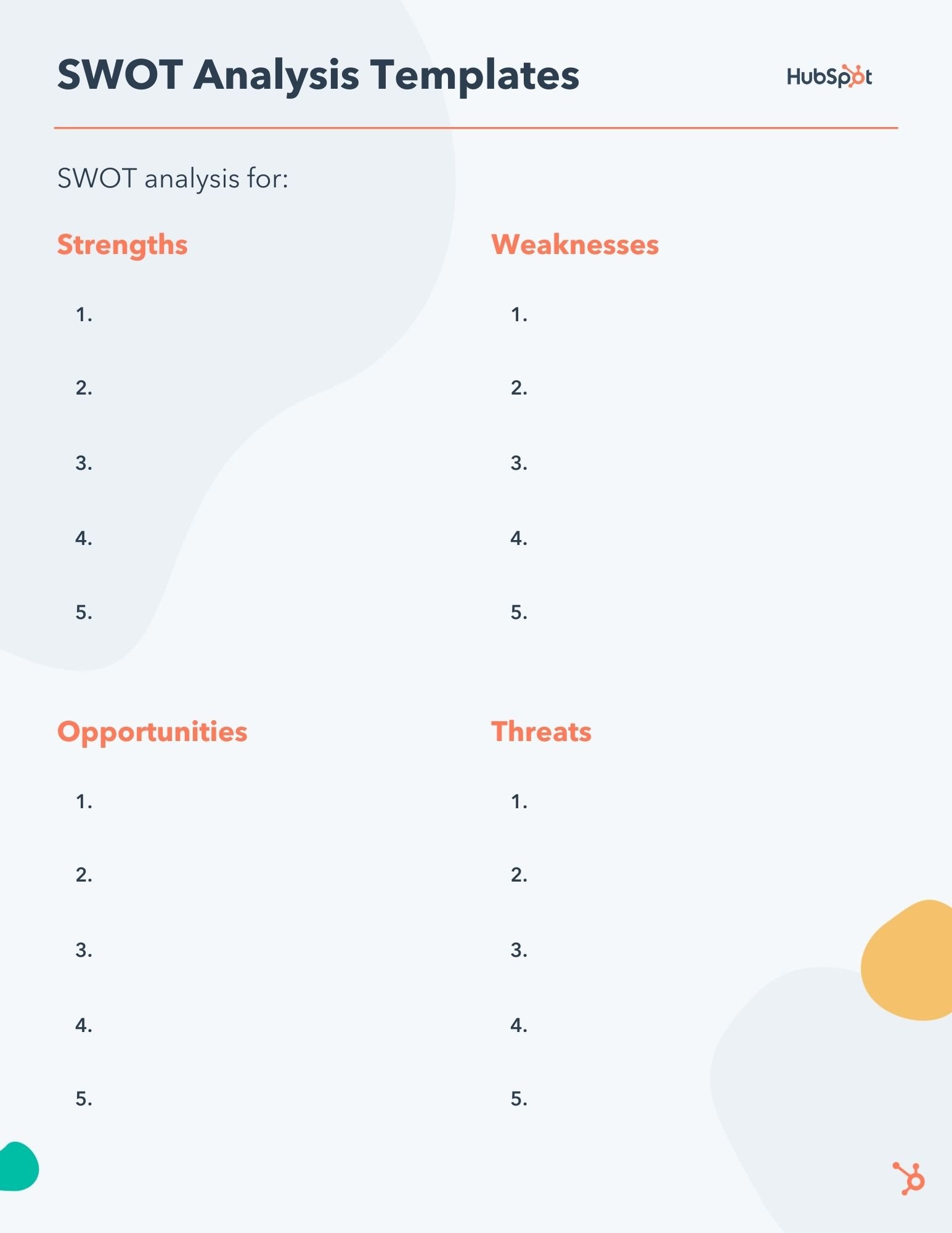
Free SWOT Analysis Template
A free SWOT analysis template, plus other helpful market research resources.
Opportunities
You're all set.
Click this link to access this resource at any time.
Importance of a SWOT Analysis
You’ve noticed by now that SWOT stands for Strengths, Weaknesses, Opportunities, and Threats. The framework seems simple enough that you’d be tempted to forgo using it at all, relying instead on your intuition to take these things into account.
But you shouldn’t. Doing a SWOT analysis is important. Here’s why.
SWOT gives you the chance to worry and to dream.
A SWOT analysis is an important step in your strategic process because it gives you the opportunity to explore both the potential risks and the exciting possibilities that lie ahead. You’re giving yourself the space to dream, evaluate, and worry before taking action. Your insights then turn into assets as you create the roadmap for your initiative.
For instance, when you consider the weaknesses and threats that your business may face, you can address any concerns or challenges and strategize on how to mitigate those risks. At the same time, you can identify strengths and opportunities, which can inspire innovative ideas and help you dream big. Both are equally important.
SWOT forces you to define your variables.
Instead of diving head first into planning and execution, you’re taking inventory of all your assets and roadblocks. This process will help you develop strategies that leverage your strengths and opportunities while addressing and mitigating the impact of weaknesses and threats.
As a result, you'll gain a comprehensive understanding of your current situation and create a more specific and effective roadmap. Plus, a SWOT analysis is inherently proactive. That means you'll be better equipped to make informed decisions, allocate resources effectively, and set realistic goals.
SWOT allows you to account for mitigating factors.
As you identify weaknesses and threats, you’re better able to account for them in your roadmap, improving your chances of success.
Moreover, accounting for mitigating factors allows you to allocate your resources wisely and make informed decisions that lead to sustainable growth. With a SWOT analysis as a guide, you can confidently face challenges and seize opportunities.
SWOT helps you keep a written record.
As your organization grows and changes, you’ll be able to strike things off your old SWOTs and make additions. You can look back at where you came from and look ahead at what’s to come.
In other words, SWOT analyses serve as a tangible history of your progress and provide a reference point for future decision-making. With each update, your SWOT analysis becomes a living document that guides your strategic thinking and helps you stay agile and adaptable in an ever-changing business landscape.
By maintaining this written record, you foster a culture of continuous improvement and empower your team to make data-driven decisions and stay aligned with your long-term vision.
Parts of a SWOT Analysis
Conducting a SWOT analysis will help you strategize effectively, unlock valuable insights, and make informed decisions. But what exactly does a SWOT analysis include?
Let’s explore each component: Strengths, Weaknesses, Opportunities, and Threats.
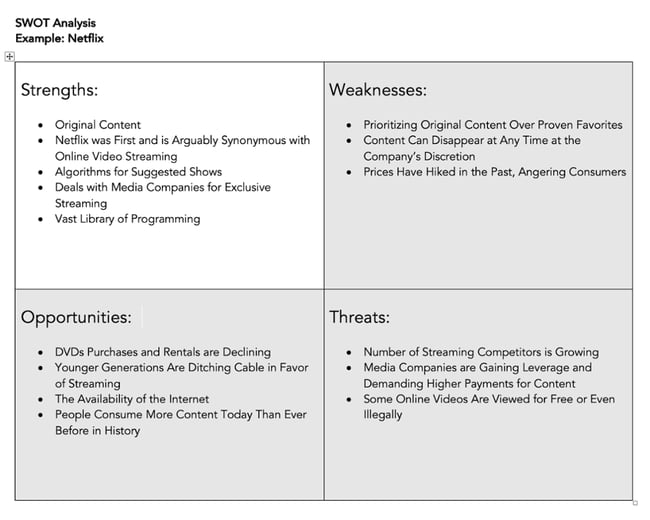
Your strengths are the unique advantages and internal capabilities that give your company a competitive edge in the market. A strong brand reputation, innovative products or services, or exceptional customer service are just a few examples. By identifying and capitalizing on your strengths, you can foster customer loyalty and build a solid foundation for growth.
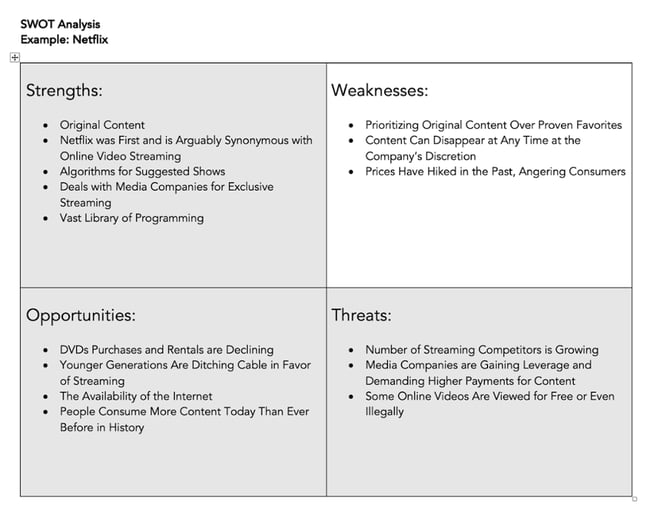
No business is flawless. Weaknesses are areas where you may face challenges or fall short of your potential. It could be outdated processes, skill gaps within the team, or inadequate resources. By acknowledging these weaknesses, you can establish targeted initiatives for improvement, upskill your team, adopt new technologies, and enhance your overall operational efficiency.
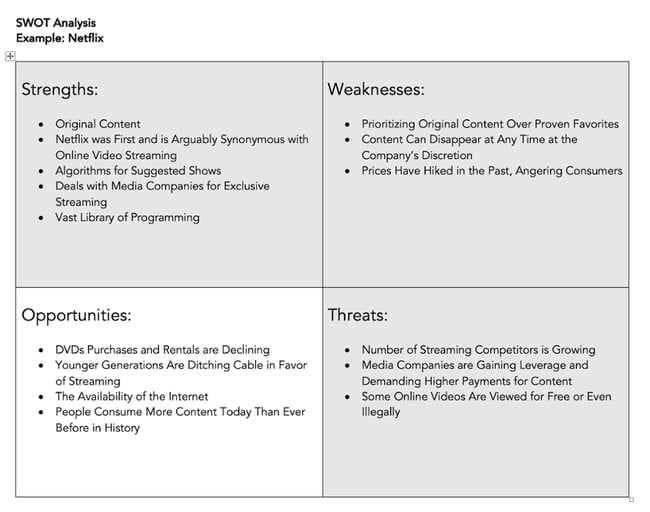
Opportunities are external factors that can contribute to your company's progress. These may include emerging markets, technological advancements, changes in consumer behavior, or gaps in the market that your company can fill. By seizing these opportunities, you can expand your market reach, diversify your product offerings, forge strategic partnerships, or even venture into untapped territories.
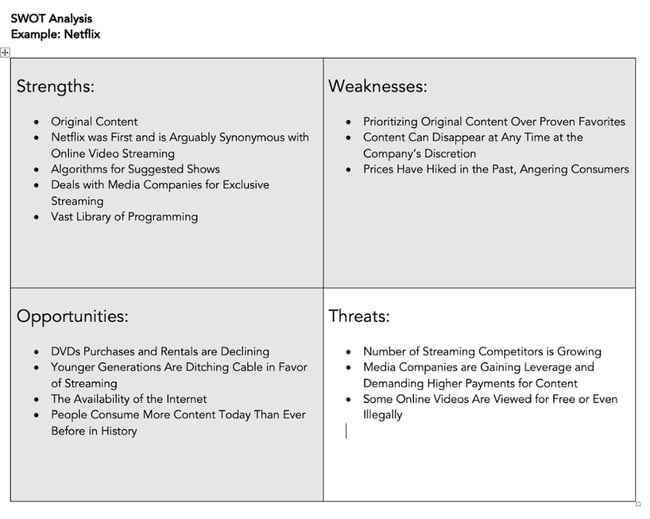
Threats are external factors that are beyond your control and pose challenges to your business. Increased competition, economic volatility, evolving regulatory landscapes, or even changing market trends are examples of threats. By proactively assessing and addressing them, you can develop contingency plans, adjust your strategies, and minimize their impact on your operations.
In a SWOT analysis, you’ll have to take both internal and external factors into account. We’ll cover those next.
.png)
Free Market Research Kit
5 Research and Planning Templates + a Free Guide on How to Use Them in Your Market Research
- SWOT Analysis Template
- Survey Template
- Focus Group Template
SWOT Analysis Internal and External Factors
A SWOT analysis typically has internal (i.e., within your organization) and external (i.e., outside your organization) factors at play. Here's a breakdown of each.
Internal Factors
Internal factors refer to the characteristics and resources within your organization that directly influence its operations and performance. These factors are completely within your organization's control, so they can be modified, improved, or capitalized upon.
In a SWOT analysis, strengths and weaknesses are categorized as internal factors. Let’s look at a few examples.
- Brand reputation
- Unique expertise
- Loyal customer base
- Talented workforce
- Efficient processes
- Proprietary technology
- Outdated technology
- Inadequate resources
- Poor financial health
- Inefficient processes
- Skill gaps within the team
External Factors
External factors are elements outside the organization's control that have an impact on its operations, market position, and success. These factors arise from the industry climate and the broader business environment. You typically have no control over external factors, but you can respond to them.
In a SWOT analysis, opportunities and threats are categorized as external factors. Let’s look at a few examples.
- Emerging markets
- Changing consumer trends
- Technological advancements
- Positive shifts in regulations
- New gaps in the market you could fill
- Intense competition
- Economic downturns
- Disruptive technologies
- Changing regulations
- Negative shifts in consumer behavior
Remember, a well-rounded SWOT analysis empowers you to capitalize on strengths, address weaknesses, seize opportunities, and navigate threats — all while making informed decisions for the future.
Now, let’s take a look at how you can write a good SWOT analysis for yourself or for stakeholders.
How do you write a good SWOT analysis?
There are several steps you’ll want to take when evaluating your business and conducting a strategic SWOT analysis.
1. Download HubSpot's SWOT Analysis Template.
There’s no need to start from scratch for your analysis. Instead, start by downloading a free, editable template from HubSpot. Feel free to use the model yourself, or create your own as it suits your needs.
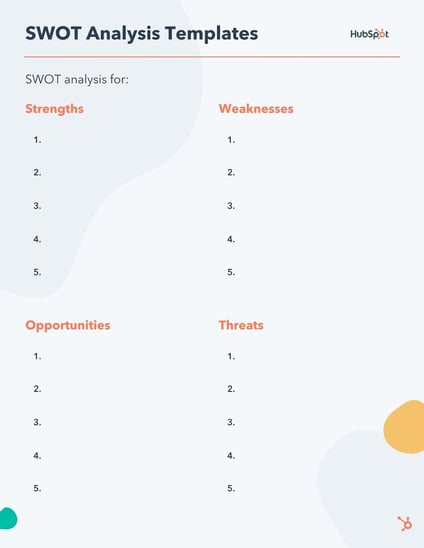
3. Identify your objective.
Before you start writing things down, you’ll need to figure out what you’re evaluating with your SWOT analysis.
Be specific about what you want to analyze. Otherwise, your SWOT analysis may end up being too broad, and you’ll get analysis paralysis as you are making your evaluations.
If you’re creating a new social media program, you’ll want to conduct an analysis to inform your content creation strategy. If you’re launching a new product, you’ll want to understand its potential positioning in the space. If you’re considering a brand redesign, you’ll want to consider existing and future brand conceptions.
All of these are examples of good reasons to conduct a SWOT analysis. By identifying your objective, you’ll be able to tailor your evaluation to get more actionable insights.
4. Identify your strengths.
“Strengths” refers to what you are currently doing well. Think about the factors that are going in your favor as well as the things you offer that your competitors just can’t beat.
For example, let’s say you want to use a SWOT analysis to evaluate your new social media strategy.
If you’re looking at a new social media program, perhaps you want to evaluate how your brand is perceived by the public. Is it easily recognizable and well-known? Even if it’s not popular with a widespread group, is it well-received by a specific audience?
Next, think about your process: Is it effective or innovative? Is there good communication between marketing and sales?
Finally, evaluate your social media message, and in particular, how it differs from the rest of the industry. I’m willing to bet you can make a lengthy list of some major strengths of your social media strategy over your competitors, so try to dive into your strengths from there.
5. Identify your weaknesses.
In contrast to your strengths, what are the roadblocks hindering you from reaching your goals? What do your competitors offer that continues to be a thorn in your side?
This section isn’t about dwelling on negative aspects. Rather, it’s critical to foresee any potential obstacles that could mitigate your success.
When identifying weaknesses, consider what areas of your business are the least profitable, where you lack certain resources, or what costs you the most time and money. Take input from employees in different departments, as they’ll likely see weaknesses you hadn’t considered.
If you’re examining a new social media strategy, you might start by asking yourself these questions: First, if I were a consumer, what would prevent me from buying this product, or engaging with this business? What would make me click away from the screen?
Second, what do I foresee as the biggest hindrance to my employees’ productivity, or their ability to get the job done efficiently? What derails their social media efforts?
6. Consider your opportunities.
This is your chance to dream big. What are some opportunities for your social media strategy you hope, but don’t necessarily expect, to reach?
For instance, maybe you’re hoping your Facebook ads will attract a new, larger demographic. Maybe you’re hoping your YouTube video gets 10,000 views and increases sales by 10%.
Whatever the case, it’s important to include potential opportunities in your SWOT analysis. Ask yourself these questions:
- What technologies do I want my business to use to make it more effective?
- What new target audience do I want to reach?
- How can the business stand out more in the current industry?
- Is there something our customers complain about that we could fix?
The opportunities category goes hand-in-hand with the weaknesses category. Once you’ve made a list of weaknesses, it should be easy to create a list of potential opportunities that could arise if you eliminate your weaknesses.
7. Contemplate your threats.
It’s likely, especially if you’re prone to worry, you already have a good list of threats in your head.
If not, gather your employees and brainstorm. Start with these questions:
- What obstacles might prevent us from reaching our goals?
- What’s going on in the industry, or with our competitors, that might mitigate our success?
- Is there new technology out there that could conflict with our product?
Writing down your threats helps you evaluate them objectively.
For instance, maybe you list your threats in terms of least and most likely to occur and divide and conquer each. If one of your biggest threats is your competitor’s popular Instagram account, you could work with your marketing department to create content that showcases your product’s unique features.
SWOT Analysis Chart
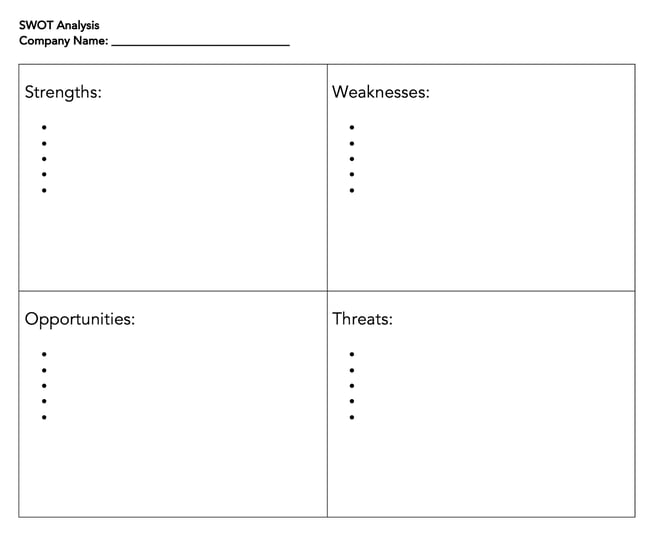
Download a free SWOT analysis chart included in HubSpot’s free market research kit .
A SWOT analysis doesn’t have to be fancy. Our SWOT analysis chart provides a clear and structured framework for capturing and organizing your internal strengths and weaknesses, and external opportunities and threats. It's the perfect visual aid to make sense of the wealth of information gathered during your analysis.
(Plus, you can always customize and paste it into a document you plan to share with stakeholders.)
But remember: Filling out the SWOT chart is just one step in the process. Combine it with our entire market research kit , and you'll have all the tools necessary to help your organization navigate new opportunities and threats.
SWOT Analysis Examples
The template above helps get you started on your own SWOT analysis.
But, if you’re anything like me, it’s not enough to see a template. To fully understand a concept, you need to see how it plays out in the real world.
These SWOT examples are not exhaustive. However, they are a great starting point to inspire you as you do your own SWOT analysis.
Apple’s SWOT analysis
Here’s how we’d conduct a SWOT analysis on Apple.

First off, strengths. While Apple has many strengths, let’s identify the top three:
- Brand recognition.
- Innovative products.
- Ease of use.
Apple’s brand is undeniably strong, and its business is considered the most valuable in the world . Since it’s easily recognized, Apple can produce new products and almost ensure a certain degree of success by virtue of the brand name itself.
Apple’s highly innovative products are often at the forefront of the industry. One thing that sets Apple apart from the competition is its product inter-connectivity.
For instance, an Apple user can easily sync their iPhone and iPad together. They can access all of their photos, contacts, apps, and more no matter which device they are using.
Lastly, customers enjoy how easy it is to use Apple’s products. With a sleek and simple design, each product is developed so that most people can quickly learn how to use them.
Next, let’s look at three of Apple’s weaknesses.
- High prices
- Closed ecosystem
- Lack of experimentation
While the high prices don’t deter Apple’s middle- and upper-class customer base, they do hinder Apple’s ability to reach a lower-class demographic.
Apple also suffers from its own exclusivity. Apple controls all its services and products in-house, and while many customers become loyal brand advocates for this reason, it means all burdens fall on Apple employees.
Ultimately, Apple’s tight control over who distributes its products limits its market reach.
Lastly, Apple is held to a high standard when it comes to creating and distributing products. Apple’s brand carries a high level of prestige. That level of recognition inhibits Apple from taking risks and experimenting freely with new products that could fail.
Now, let’s take a look at opportunities for Apple.
It’s easy to recognize opportunities for improvement, once you consider Apple’s weaknesses. Here’s a list of three we came up with:
- Expand distribution options.
- Create new product lines.
- Technological advancement.
One of Apple’s biggest weaknesses is its distribution network, which, in the name of exclusivity, remains relatively small. If Apple expanded its network and enabled third-party businesses to sell its products, it could reach more people globally, while alleviating some of the stress currently put on in-house employees.
There are also plenty of opportunities for Apple to create new products. Apple could consider creating more affordable products to reach a larger demographic, or spreading out into new industries — Apple self-driving cars, perhaps?
Finally, Apple could continue advancing its products’ technology. Apple can take existing products and refine them, ensuring each product offers as many unique features as possible.
Finally, let’s look at threats to Apple.
Believe it or not, they do exist.
Here are three of Apple’s biggest threats:
- Tough competition.
- International issues.
Apple isn’t the only innovative tech company out there, and it continues to face tough competition from Samsung, Google, and other major forces. In fact, Samsung sold more smartphones than Apple did in Q1 of 2022 , shipping 17 million more units than Apple and holding 24% of the market share.
Many of Apple’s weaknesses hinder Apple’s ability to compete with the tech corporations that have more freedom to experiment, or that don’t operate in a closed ecosystem.
A second threat to Apple is lawsuits. Apple has faced plenty of lawsuits, particularly between Apple and Samsung . These lawsuits interfere with Apple’s reputable image and could steer some customers to purchase elsewhere.
Finally, Apple needs to improve its reach internationally. The company isn’t number one in China and doesn’t have a very positive relationship with the Chinese government. In India, which has one of the largest consumer markets in the world, Apple’s market share is low , and the company has trouble bringing stores to India’s market.
If Apple can’t compete globally the way Samsung or Google can, it risks falling behind in the industry.
Starbucks SWOT Analysis
Now that we’ve explored the nuances involved with a SWOT analysis, let’s fill out a SWOT template using Starbucks as an example.
Here’s how we’d fill out a SWOT template if we were Starbucks:

Download this Template for Free
Restaurant Small Business SWOT Analysis
Some small business marketers may have difficulty relating to the SWOTs of big brands like Apple and Starbucks. Here’s an example of how a dine-in Thai restaurant might visualize each element.
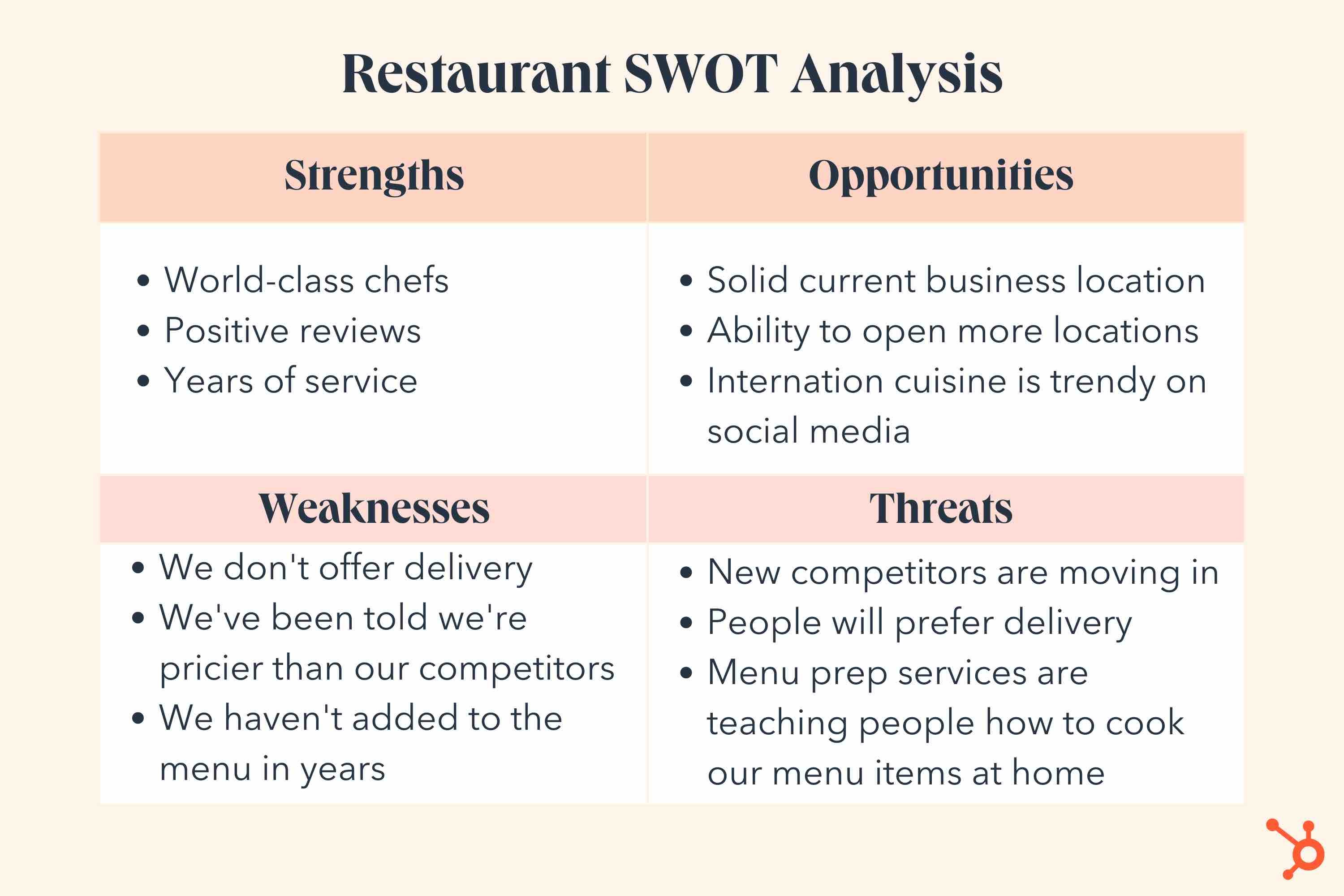
Small restaurants can lean into their culinary expertise and service skills to find opportunities for growth and brand awareness. A SWOT analysis can also help identify weaknesses that can be improved, such as menu variation and pricing.
While a restaurant might not be as worried about high-level lawsuits, a small business might be more concerned about competitors or disruptors that might enter the playing field.
Local Boutique SWOT Analysis
In another small business example, let’s take a look at a SWOT analysis for a local boutique.
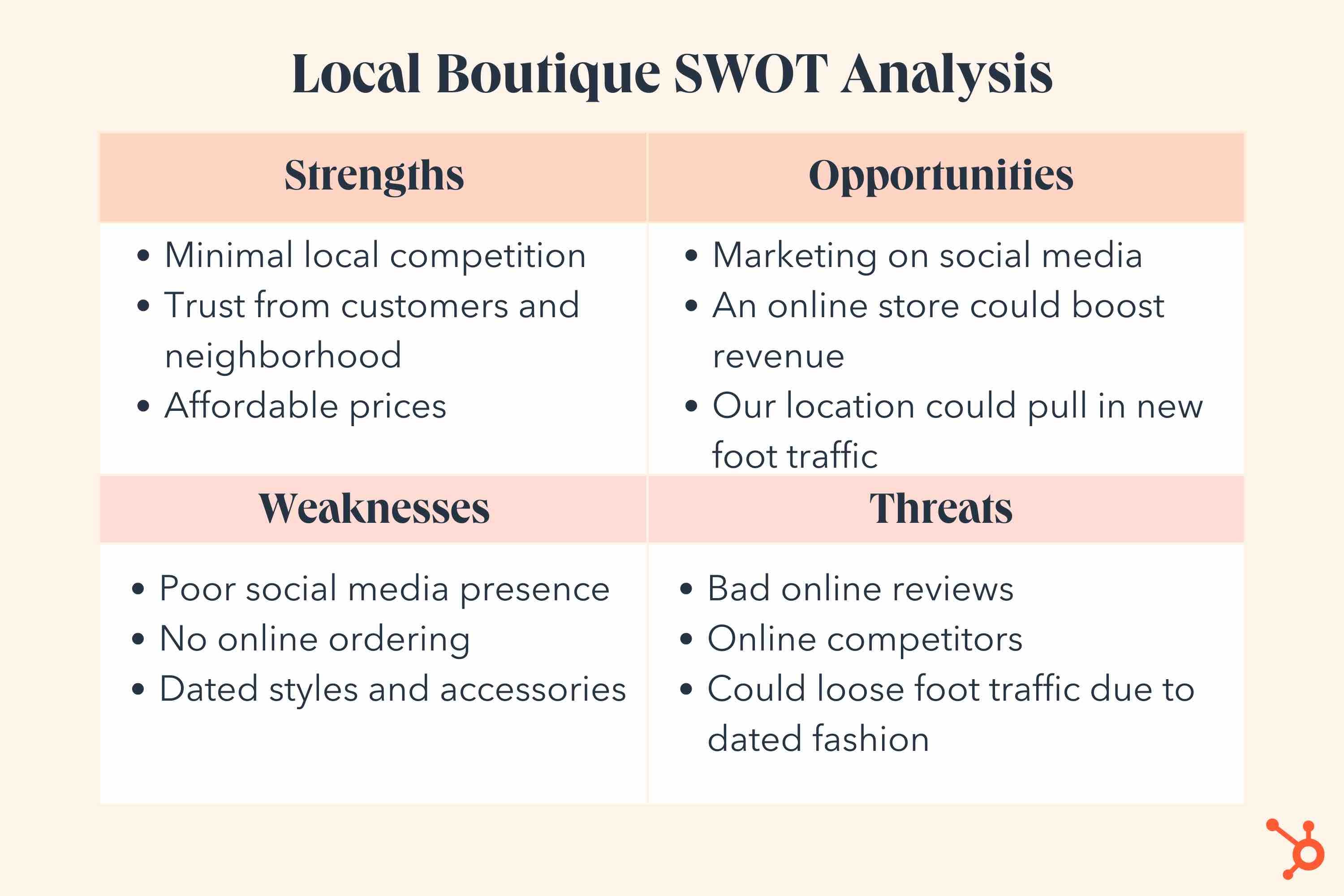
This shop might be well known in its neighborhood, but it also might take time to build an online presence or get its products in an online store.
Because of this, some of its strengths and opportunities might relate to physical factors while weaknesses and threats might relate to online situations.
How to Act on a SWOT Analysis
After conducting a SWOT analysis, you may be asking yourself: What’s next?
Putting together a SWOT analysis is only one step. Executing the findings identified by the analysis is just as important — if not more.
Put your insights into action using the following steps.
Take advantage of your strengths.
Use your strengths to pursue opportunities from your analysis.
For example, if we look at the local boutique example above, the strength of having affordable prices can be a value proposition. You can emphasize your affordable prices on social media or launch an online store.
Address your weaknesses.
Back to the boutique example, one of its weaknesses is having a poor social media presence. To mitigate this, the boutique could hire a social media consultant to improve its strategy. They may even tap into the expertise of a social-savvy employee.
Make note of the threats.
Threats are often external factors that can’t be controlled, so it’s best to monitor the threats outlined in your SWOT analysis to be aware of their impacts on your business.
When to Use a SWOT Analysis
While the examples above focus on business strategy in general, you can also use a SWOT analysis to evaluate and predict how a singular product will play out in the market.
Ultimately, a SWOT analysis can measure and tackle both big and small challenges, from deciding whether or not to launch a new product to refining your social media strategy.
Editor's note: This post was originally published in May 2018 and has been updated for comprehensiveness.

Don't forget to share this post!
Related articles.

Market Research: A How-To Guide and Template

20+ Tools & Resources for Conducting Market Research

What's a Competitive Analysis & How Do You Conduct One?

TAM SAM SOM: What Do They Mean & How Do You Calculate Them?
![where does the swot analysis go in a business plan How to Run a Competitor Analysis [Free Guide]](https://blog.hubspot.com/hubfs/Google%20Drive%20Integration/how%20to%20do%20a%20competitor%20analysis_122022.jpeg)
How to Run a Competitor Analysis [Free Guide]
![where does the swot analysis go in a business plan 5 Challenges Marketers Face in Understanding Audiences [New Data + Market Researcher Tips]](https://blog.hubspot.com/hubfs/challenges%20marketers%20face%20in%20understanding%20the%20customer%20.png)
5 Challenges Marketers Face in Understanding Audiences [New Data + Market Researcher Tips]

Causal Research: The Complete Guide

Total Addressable Market (TAM): What It Is & How You Can Calculate It

What Is Market Share & How Do You Calculate It?
![where does the swot analysis go in a business plan 3 Ways Data Privacy Changes Benefit Marketers [New Data]](https://blog.hubspot.com/hubfs/how-data-privacy-benefits-marketers_1.webp)
3 Ways Data Privacy Changes Benefit Marketers [New Data]
Free Guide & Templates to Help Your Market Research
Marketing software that helps you drive revenue, save time and resources, and measure and optimize your investments — all on one easy-to-use platform
.css-s5s6ko{margin-right:42px;color:#F5F4F3;}@media (max-width: 1120px){.css-s5s6ko{margin-right:12px;}} Join us: Learn how to build a trusted AI strategy to support your company's intelligent transformation, featuring Forrester .css-1ixh9fn{display:inline-block;}@media (max-width: 480px){.css-1ixh9fn{display:block;margin-top:12px;}} .css-1uaoevr-heading-6{font-size:14px;line-height:24px;font-weight:500;-webkit-text-decoration:underline;text-decoration:underline;color:#F5F4F3;}.css-1uaoevr-heading-6:hover{color:#F5F4F3;} .css-ora5nu-heading-6{display:-webkit-box;display:-webkit-flex;display:-ms-flexbox;display:flex;-webkit-align-items:center;-webkit-box-align:center;-ms-flex-align:center;align-items:center;-webkit-box-pack:start;-ms-flex-pack:start;-webkit-justify-content:flex-start;justify-content:flex-start;color:#0D0E10;-webkit-transition:all 0.3s;transition:all 0.3s;position:relative;font-size:16px;line-height:28px;padding:0;font-size:14px;line-height:24px;font-weight:500;-webkit-text-decoration:underline;text-decoration:underline;color:#F5F4F3;}.css-ora5nu-heading-6:hover{border-bottom:0;color:#CD4848;}.css-ora5nu-heading-6:hover path{fill:#CD4848;}.css-ora5nu-heading-6:hover div{border-color:#CD4848;}.css-ora5nu-heading-6:hover div:before{border-left-color:#CD4848;}.css-ora5nu-heading-6:active{border-bottom:0;background-color:#EBE8E8;color:#0D0E10;}.css-ora5nu-heading-6:active path{fill:#0D0E10;}.css-ora5nu-heading-6:active div{border-color:#0D0E10;}.css-ora5nu-heading-6:active div:before{border-left-color:#0D0E10;}.css-ora5nu-heading-6:hover{color:#F5F4F3;} Register now .css-1k6cidy{width:11px;height:11px;margin-left:8px;}.css-1k6cidy path{fill:currentColor;}
- Project management |
SWOT analysis: Examples and templates

A SWOT analysis helps you identify strengths, weaknesses, opportunities, and threats for a specific project or your overall business plan. It’s used for strategic planning and to stay ahead of market trends. Below, we describe each part of the SWOT framework and show you how to conduct your own.
Whether you’re looking for external opportunities or internal strengths, we’ll walk you through how to perform your own SWOT analysis, with helpful examples along the way.
What is a SWOT analysis?
A SWOT analysis is a technique used to identify strengths, weaknesses, opportunities, and threats for your business or even a specific project. It’s most widely used by organizations—from small businesses and non-profits to large enterprises—but a SWOT analysis can be used for personal purposes as well.
While simple, a SWOT analysis is a powerful tool for helping you identify competitive opportunities for improvement. It helps you improve your team and business while staying ahead of market trends.
What does SWOT stand for?
SWOT is an acronym that stands for:
Opportunities

When analyzed together, the SWOT framework can paint a larger picture of where you are and how to get to the next step. Let’s dive a little deeper into each of these terms and how they can help identify areas of improvement.
Strengths in SWOT refer to internal initiatives that are performing well. Examining these areas helps you understand what’s already working. You can then use the techniques that you know work—your strengths—in other areas that might need additional support, like improving your team’s efficiency .
When looking into the strengths of your organization, ask yourself the following questions:
What do we do well? Or, even better: What do we do best?
What’s unique about our organization?
What does our target audience like about our organization?
Which categories or features beat out our competitors?
Example SWOT strength:
Customer service: Our world-class customer service has an NPS score of 90 as compared to our competitors, who average an NPS score of 70.
Weaknesses in SWOT refer to internal initiatives that are underperforming. It’s a good idea to analyze your strengths before your weaknesses in order to create a baseline for success and failure. Identifying internal weaknesses provides a starting point for improving those projects.
Identify the company’s weaknesses by asking:
Which initiatives are underperforming and why?
What can be improved?
What resources could improve our performance?
How do we rank against our competitors?
Example SWOT weakness:
E-commerce visibility: Our website visibility is low because of a lack of marketing budget , leading to a decrease in mobile app transactions.
Opportunities in SWOT result from your existing strengths and weaknesses, along with any external initiatives that will put you in a stronger competitive position. These could be anything from weaknesses that you’d like to improve or areas that weren’t identified in the first two phases of your analysis.
Since there are multiple ways to come up with opportunities, it’s helpful to consider these questions before getting started:
What resources can we use to improve weaknesses?
Are there market gaps in our services?
What are our business goals for the year?
What do your competitors offer?
Example SWOT opportunities:
Marketing campaign: To improve brand visibility, we’ll run ad campaigns on YouTube, Facebook, and Instagram.
Threats in SWOT are areas with the potential to cause problems. Different from weaknesses, threats are external and out of your control. This can include anything from a global pandemic to a change in the competitive landscape.
Here are a few questions to ask yourself to identify external threats:
What changes in the industry are cause for concern?
What new market trends are on the horizon?
Where are our competitors outperforming us?
Example SWOT threats:
New competitor: With a new e-commerce competitor set to launch within the next month, we could see a decline in customers.
SWOT analysis example
One of the most popular ways to create a SWOT analysis is through a SWOT matrix—a visual representation of strengths, weaknesses, opportunities, and threats. The matrix comprises four separate squares that create one larger square.
A SWOT matrix is great for collecting information and documenting the questions and decision-making process . Not only will it be handy to reference later on, but it’s also great for visualizing any patterns that arise.
Check out the SWOT matrix below for a simple example. As you can see, each of the quadrants lists out the company's strengths, weaknesses, opportunities, and threats.
![where does the swot analysis go in a business plan [Inline illustration] SWOT analysis (Example)](https://assets.asana.biz/transform/cfab4ed2-46d1-4636-b801-14b3d86c8367/inline-project-management-SWOT-analysis-4-2x?io=transform:fill,width:2560&format=webp)
When used correctly and effectively, your matrix can be a great toolkit for evaluating your organization’s strengths and weaknesses.
How to do a SWOT analysis, with examples
A SWOT analysis can be conducted in a variety of ways. Some teams like to meet and throw ideas on a whiteboard, while others prefer the structure of a SWOT matrix. However you choose to make your SWOT analysis, getting creative with your planning process allows new ideas to flow and results in more unique solutions.
There are a few ways to ensure that your SWOT analysis is thorough and done correctly. Let’s take a closer look at some tips to help you get started.
Tip 1: Consider internal factors
Often, strengths and weaknesses stem from internal processes. These tend to be easier to solve since you have more control over the outcome. When you come across internal factors, you can start implementing improvements in a couple of different ways.
Meet with department stakeholders to form a business plan around how to improve your current situation.
Research and implement new tools, such as a project management tool , that can help streamline these processes for you.
Take immediate action on anything that can be changed in 24 hours or less. If you don’t have the capacity, consider delegating these items to others with deadlines.
The way you go about solving internal factors will depend on the type of problem. If it’s more complex, you might need to use a combination of the above or a more thorough problem management process.
Tip 2: Evaluate external factors
External factors stem from processes outside of your control. This includes competitors, market trends, and anything else that’s affecting your organization from the outside in.
External factors are trickier to solve, as you can’t directly control the outcome. What you can do is pivot your own processes in a way that mitigates negative external factors.
You can work to solve these issues by:
Competing with market trends
Forecasting market trends before they happen
Improving adaptability to improve your reaction time
Track competitors using reporting tools that automatically update you as soon as changes occur
While you won’t be able to control an external environment, you can control how your organization reacts to it.
Let’s say, for instance, that you’re looking to compete with a market trend. For example, a competitor introduced a new product to the market that’s outperforming your own. While you can’t take that product away, you can work to launch an even better product or marketing campaign to mitigate any decline in sales.
Tip 3: Hold a brainstorming session
Brainstorming new and innovative ideas can help to spur creativity and inspire action. To host a high impact brainstorming session, you’ll want to:
Invite team members from various departments. That way, ideas from each part of the company are represented.
Be intentional about the number of team members you invite, since too many participants could lead to a lack of focus or participation. The sweet spot for a productive brainstorming session is around 10 teammates.
Use different brainstorming techniques that appeal to different work types.
Set a clear intention for the session.
Tip 4: Get creative
In order to generate creative ideas, you have to first invite them. That means creating fun ways to come up with opportunities. Try randomly selecting anonymous ideas, talking through obviously bad examples, or playing team building games to psych up the team.
Tip 5: Prioritize opportunities
Now, rank the opportunities. This can be done as a team or with a smaller group of leaders. Talk through each idea and rank it on a scale of one through 10. Once you’ve agreed on your top ideas based on team capabilities, competencies, and overall impact, it’s easier to implement them.
Tip 6: Take action
It’s all too easy to feel finished at this stage —but the actual work is just beginning. After your SWOT analysis, you’ll have a list of prioritized opportunities. Now is the time to turn them into strengths. Use a structured system such as a business case , project plan, or implementation plan to outline what needs to get done—and how you plan to do it.
SWOT analysis template
A SWOT analysis template is often presented in a grid format, divided into four quadrants. Each quadrant represents one of the four elements.
Use this free SWOT analysis template to jump-start your team’s strategic planning.
Identify the strengths that contribute to achieving your objectives. These are internal characteristics that give you an advantage. Some examples could be a strong brand reputation, an innovative culture, or an experienced management team.
Next, focus on weaknesses. These are internal factors that could serve as obstacles to achieving your objectives. Common examples might include a lack of financial resources, high operational costs, or outdated technology.
Move on to the opportunities. These are external conditions that could be helpful in achieving your goals. For example, you might be looking at emerging markets, increased demand, or favorable shifts in regulations.
Lastly, let's address threats. These are external conditions that could negatively impact your objectives. Examples include increased competition or potential economic downturns.
Why is a SWOT analysis important?
A SWOT analysis can help you improve processes and plan for growth. While similar to a competitive analysis , it differs because it evaluates both internal and external factors. Analyzing key areas around these opportunities and threats will equip you with the insights needed to set your team up for success.

A SWOT analysis isn’t only useful for organizations. With a personal SWOT analysis, you can examine areas of your life that could benefit from improvement, from your leadership style to your communication skills. These are the benefits of using a SWOT analysis in any scenario.
1. Identifies areas of opportunity
One of the biggest benefits of conducting an analysis is to determine opportunities for growth. It’s a great starting point for startups and teams that know they want to improve but aren’t exactly sure how to get started.
Opportunities can come from many different avenues, like external factors such as diversifying your products for competitive advantage or internal factors like improving your team’s workflow . Either way, capitalizing on opportunities is an excellent way to grow as a team.
2. Identifies areas that could be improved
Identifying weaknesses and threats during a SWOT analysis can pave the way for a better business strategy.
Ultimately, learning from your mistakes is the best way to excel. Once you find areas to streamline, you can work with team members to brainstorm an action plan . This will let you use what you already know works and build on your company’s strengths.
3. Identifies areas that could be at risk
Whether you have a risk register in place or not, it’s always crucial to identify risks before they become a cause for concern. A SWOT analysis can help you stay on top of actionable items that may play a part in your risk decision-making process.
It may be beneficial to pair your SWOT analysis with a PEST analysis, which examines external solutions such as political, economic, social, and technological factors—all of which can help you identify and plan for project risks .
When should you use a SWOT analysis?
You won’t always need an in-depth SWOT analysis. It’s most useful for large, general overviews of situations, scenarios, or your business.
A SWOT analysis is most helpful:
Before you implement a large change—including as part of a larger change management plan
When you launch a new company initiative
If you’d like to identify opportunities for growth and improvement
Any time you want a full overview of your business performance
If you need to identify business performance from different perspectives
SWOT analyses are general for a reason—so they can be applied to almost any scenario, project, or business.
SWOT analysis: Pros and cons
Although SWOT is a useful strategic planning tool for businesses and individuals alike, it does have limitations. Here’s what you can expect.
The simplicity of SWOT analysis makes it a go-to tool for many. Because it is simple, it takes the mystery out of strategic planning and lets people think critically about their situations without feeling overwhelmed.
For instance, a small bakery looking to expand its operations can use SWOT analysis to easily understand its current standing. Identifying strengths like a loyal customer base, weaknesses such as limited seating space, opportunities like a rising trend in artisanal baked goods, and threats from larger chain bakeries nearby can all be accomplished without any specialized knowledge or technical expertise.
Versatility
Its versatile nature allows SWOT analysis to be used across various domains. Whether it’s a business strategizing for the future or an individual planning their career path, SWOT analysis lends itself well.
For example, a tech start-up in the competitive Silicon Valley landscape could employ SWOT to navigate its pathway to profitability. Strengths might include a highly skilled development team; weaknesses could be a lack of brand recognition; opportunities might lie in emerging markets; and threats could include established tech giants.
Meaningful analysis
SWOT excels in identifying external factors that could impact performance. It nudges organizations to look beyond the present and anticipate potential future scenarios.
A retail company, for example, could use SWOT analysis to identify opportunities in e-commerce and threats from changing consumer behavior or new competitors entering the market. By doing so, the company can strategize on how to leverage online platforms to boost sales and counteract threats by enhancing the customer experience or adopting new technologies.
Subjectivity and bias
The subjective nature of SWOT analysis may lead to biases. It relies heavily on individual perceptions, which can sometimes overlook crucial data or misinterpret information, leading to skewed conclusions.
For example, a manufacturing company might undervalue the threat of new entrants in the market due to an overconfidence bias among the management. This subjectivity might lead to a lack of preparation for competitive pricing strategies, ultimately affecting the company's market share.
Lack of prioritization
SWOT analysis lays out issues but falls short on prioritizing them. Organizations might struggle to identify which elements deserve immediate attention and resources.
For instance, a healthcare provider identifying numerous opportunities for expansion into new services may become overwhelmed with the choices. Without a clear way to rank these opportunities, resources could be spread too thinly or given to projects that do not have as much of an impact, leading to less-than-ideal outcomes.
Static analysis
Since SWOT analysis captures a snapshot at a particular moment, it may miss the evolving nature of challenges and opportunities, possibly leading to outdated strategies. An example could be a traditional retail business that performs a SWOT analysis and decides to focus on expanding physical stores, overlooking the growing trend of e-commerce. As online shopping continues to evolve and gain popularity, the static analysis might lead to investment in areas with diminishing returns while missing out on the booming e-commerce market trend.
SWOT analysis FAQ
What are the five elements of swot analysis.
Traditionally, SWOT stands for its four main elements: strengths, weaknesses, opportunities, and threats. However, a fifth essential element often overlooked is "actionable strategies." Originally developed by Albert Humphrey, SWOT is more than just a list—it's a planning tool designed to generate actionable strategies for making informed business decisions. This fifth element serves to tie the other four together, enabling departments like human resources and marketing to turn analysis into actionable plans.
What should a SWOT analysis include?
A comprehensive SWOT analysis should focus on the internal and external factors that affect your organization. Internally, consider your strong brand and product line as your strengths, and maybe your supply chain weaknesses. Externally, you'll want to look at market share, partnerships, and new technologies that could either pose opportunities or threats. You should also account for demographics, as it helps in market targeting and segmentation.
How do you write a good SWOT analysis?
Writing an effective SWOT analysis begins with research. Start by identifying your strengths, like a strong brand, and your weaknesses, like a small human resources department. Following that, look outward to find opportunities, possibly in technological advancement, and threats, like fluctuations in market share. Many businesses find it helpful to use a free SWOT analysis template to structure this information. A good SWOT analysis doesn't just list these elements; it integrates them to provide a clear roadmap for making business decisions.
What are four examples of threats in SWOT analysis?
New technologies: Rapid technological advancement can make your product or service obsolete.
Supply chain disruptions: Whether due to natural disasters or geopolitical tensions, an unstable supply chain can seriously jeopardize your operations.
Emerging competitors: New players entering the market can erode your market share and offer alternative solutions to your customer base.
Regulatory changes: New laws or regulations can add costs and complexity to your business, affecting your competitiveness.
How do you use a SWOT analysis?
Once you've completed a SWOT analysis, use the results as a decision-making aid. It can help prioritize actions, develop strategic plans that play to your strengths, improve weaknesses, seize opportunities, and counteract threats. It’s a useful tool for setting objectives and creating a roadmap for achieving them.
Plan for growth with a SWOT analysis
A SWOT analysis can be an effective technique for identifying key strengths, weaknesses, opportunities, and threats. Understanding where you are now can be the most impactful way to determine where you want to go next.
Don’t forget, a bit of creativity and collaboration can go a long way. Encourage your team to think outside of the box with 100+ team motivational quotes .
Related resources

Unmanaged business goals don’t work. Here’s what does.

How Asana uses work management to drive product development

How Asana uses work management to streamline project intake processes

How Asana uses work management for smoother creative production
- Skip to primary navigation
- Skip to main content
- Skip to primary sidebar
PESTLE Analysis
SWOT and Business Analysis Tools
How to Use SWOT in Business Plans
Jun 16, 2016 by Thomas Bush
Building a successful business requires extensive forethought and planning. The latter, business planning, assists you in picking goals, defining strategies, and actualizing your vision. It may sound complicated to do so, but with the help of some key business analyses , especially the SWOT analysis, you can make the process much easier for yourself.
SWOT: What and Why?
If you’re a regular PESTLEAnalysis.com reader, you should know by now that SWOT analysis identifies the S trengths, W eaknesses, O pportunities, and T hreats of a business or individual venture. A well-executed SWOT analysis reveals lots of information about the circumstances you (do or will) find yourself in, and how to make the most out of them, both of which are essential in business planning.
If you are still not sold on the importance of a SWOT analysis in business, it is critical that you review this article (“ How Your Business Could Fall Without Proper SWOT Analysis ”) before continuing on.
SWOT Analysis in Business Planning / Plans
Business plans often try to answer questions like “How will we grow?”, “What will we change?”, or “What might prevent us?” The two external factors in a SWOT matrix (Opportunities and Threats) begin the process of answering these questions, thanks to their inherent relation to the future. The other two factors (Strengths and Weaknesses) — both of which are internal — also contribute to an answer, but in a less explicit way. These two factors help you pick out, amongst other things, what to make the most of and what might need working on to reach your goals.
Business Planning, Analysis, and SWOT
You can’t plan for where you want your business to be in some amount of time if you don’t know where it is now. Thankfully, business analyses are designed to help you work that out. Before actually getting started with your business plan, be sure to conduct a concise business analysis (which might also use a SWOT analysis as discussed in a previous article ) to gain some more insight into this matter.
Actually Planning with SWOT
When formulating a business plan, go through each of the variables included in a SWOT analysis, and ask how they relate to your plan. Here are a few examples for each factor:
- Does our vision correspond with what we do well?
- Are we good at what we will need to be good at?
- How will our plan make the most of what we are good at?
- Weaknesses:
- Will our business plan be hindered by certain weaknesses?
- Is it worth fixing them, or adjusting our plan to avoid them?
- Opportunities:
- What opportunities can we plan for?
- How will we make the most of unexpected, unplanned-for opportunities?
- What could prevent us from following our plan?
- How will we deal with any unexpected issues?
SWOT Models for Business Planning
Everything is better explained with lots of examples or outlines, and so we have an entire article dedicated to SWOT analysis templates for more effective, efficient business planning. Be sure to check it out for another approach to using SWOT in business.
That’s all there is to using SWOT analysis in business planning! It may seem simple, but its benefits are surprisingly apparent. Have you used a SWOT analysis for business planning or a previous venture? We’d love to hear about it down below, along with your questions and comments.
Image © Thodonal | Dreamstime.com – Business plan

How it works
For Business
Join Mind Tools
Article • 17 min read
SWOT Analysis
Understanding your business, informing your strategy.
By the Mind Tools Content Team
What Is a SWOT Analysis?
SWOT stands for Strengths, Weaknesses, Opportunities, and Threats, and so a SWOT analysis is a technique for assessing these four aspects of your business.
SWOT Analysis is a tool that can help you to analyze what your company does best now, and to devise a successful strategy for the future. SWOT can also uncover areas of the business that are holding you back, or that your competitors could exploit if you don't protect yourself.
A SWOT analysis examines both internal and external factors – that is, what's going on inside and outside your organization. So some of these factors will be within your control and some will not. In either case, the wisest action you can take in response will become clearer once you've discovered, recorded and analyzed as many factors as you can.
In this article, video and infographic, we explore how to carry out a SWOT analysis, and how to put your findings into action. We also include a worked example and a template to help you get started on a SWOT analysis in your own workplace.
Why Is SWOT Analysis Important?
SWOT Analysis can help you to challenge risky assumptions and to uncover dangerous blindspots about your organization's performance. If you use it carefully and collaboratively, it can deliver new insights on where your business currently is, and help you to develop exactly the right strategy for any situation.
For example, you may be well aware of some of your organization's strengths, but until you record them alongside weaknesses and threats you might not realize how unreliable those strengths actually are.
Equally, you likely have reasonable concerns about some of your business weaknesses but, by going through the analysis systematically, you could find an opportunity, previously overlooked, that could more than compensate.
How to Write a SWOT Analysis
SWOT analysis involves making lists – but so much more, too! When you begin to write one list (say, Strengths), the thought process and research that you'll go through will prompt ideas for the other lists (Weaknesses, Opportunities or Threats). And if you compare these lists side by side, you will likely notice connections and contradictions, which you'll want to highlight and explore.
You'll find yourself moving back and forth between your lists frequently. So, make the task easier and more effective by arranging your four lists together in one view.
A SWOT matrix is a 2x2 grid, with one square for each of the four aspects of SWOT. (Figure 1 shows what it should look like.) Each section is headed by some questions to get your thinking started.
Figure 1. A SWOT Analysis Matrix.
Swot analysis template.
When conducting your SWOT analysis, you can either draw your own matrix, or use our free downloadable template .
How to Do a SWOT Analysis
Avoid relying on your own, partial understanding of your organization. Your assumptions could be wrong. Instead, gather a team of people from a range of functions and levels to build a broad and insightful list of observations.
Then, every time you identify a Strength, Weakness, Opportunity, or Threat, write it down in the relevant part of the SWOT analysis grid for all to see.
Let's look at each area in more detail and consider what fits where, and what questions you could ask as part of your data gathering.
Strengths are things that your organization does particularly well, or in a way that distinguishes you from your competitors. Think about the advantages your organization has over other organizations. These might be the motivation of your staff, access to certain materials, or a strong set of manufacturing processes.
Your strengths are an integral part of your organization, so think about what makes it "tick." What do you do better than anyone else? What values drive your business? What unique or lowest-cost resources can you draw upon that others can't? Identify and analyze your organization's Unique Selling Proposition (USP), and add this to the Strengths section.
Then turn your perspective around and ask yourself what your competitors might see as your strengths. What factors mean that you get the sale ahead of them?
Remember, any aspect of your organization is only a strength if it brings you a clear advantage. For example, if all of your competitors provide high-quality products, then a high-quality production process is not a strength in your market: it's a necessity.
Weaknesses, like strengths, are inherent features of your organization, so focus on your people, resources, systems, and procedures. Think about what you could improve, and the sorts of practices you should avoid.
Once again, imagine (or find out) how other people in your market see you. Do they notice weaknesses that you tend to be blind to? Take time to examine how and why your competitors are doing better than you. What are you lacking?
Be honest! A SWOT analysis will only be valuable if you gather all the information you need. So, it's best to be realistic now, and face any unpleasant truths as soon as possible.
Opportunities
Opportunities are openings or chances for something positive to happen, but you'll need to claim them for yourself!
They usually arise from situations outside your organization, and require an eye to what might happen in the future. They might arise as developments in the market you serve, or in the technology you use. Being able to spot and exploit opportunities can make a huge difference to your organization's ability to compete and take the lead in your market.
Think about good opportunities that you can exploit immediately. These don't need to be game-changers: even small advantages can increase your organization's competitiveness. What interesting market trends are you aware of, large or small, which could have an impact?
You should also watch out for changes in government policy related to your field. And changes in social patterns, population profiles, and lifestyles can all throw up interesting opportunities.
Threats include anything that can negatively affect your business from the outside, such as supply-chain problems, shifts in market requirements, or a shortage of recruits. It's vital to anticipate threats and to take action against them before you become a victim of them and your growth stalls.
Think about the obstacles you face in getting your product to market and selling. You may notice that quality standards or specifications for your products are changing, and that you'll need to change those products if you're to stay in the lead. Evolving technology is an ever-present threat, as well as an opportunity!
Always consider what your competitors are doing, and whether you should be changing your organization's emphasis to meet the challenge. But remember that what they're doing might not be the right thing for you to do. So, avoid copying them without knowing how it will improve your position.
Be sure to explore whether your organization is especially exposed to external challenges. Do you have bad debt or cash-flow problems, for example, that could make you vulnerable to even small changes in your market? This is the kind of threat that can seriously damage your business, so be alert.
Use PEST Analysis to ensure that you don't overlook threatening external factors. And PMESII-PT is an especially helpful check in very unfamiliar or uncertain environments.
Frequently Asked Questions About SWOT Analysis
1. who invented swot analysis.
Many people attribute SWOT Analysis to Albert S. Humphrey. However, there has been some debate on the originator of the tool, as discussed in the International Journal of Business Research .
2. What Does SWOT Analysis Stand For?
SWOT Analysis stands for Strengths, Weaknesses, Opportunities and Threats.
3. What Can a SWOT Analysis Be Used For?
SWOT analysis is a useful tool to help you determine your organization's position in the market. You can then use this information to create an informed strategy suited to your needs and capabilities.
4. How Do I Write a SWOT Analysis?
To conduct a SWOT analysis, you first need to create a 2x2 matrix grid. Each square is then assigned to one of the four aspects of SWOT. You can either draw this grid yourself or use our downloadable template to get started.
5. How Do SWOT Analysis and the TOWS Matrix compare?
While SWOT analysis puts the emphasis on the internal environment (your strengths and weaknesses), TOWS forces you to look at your external environment first (your threats and opportunities). In most cases, you'll do a SWOT Analysis first, and follow up with a TOWS Matrix to offer a broader context.
6. What Are the Biggest SWOT Analysis Mistakes?
- Making your lists too long. Ask yourself if your ideas are feasible as you go along.
- Being vague. Be specific to provide more focus for later discussions.
- Not seeing weaknesses. Be sure to ask customers and colleagues what they experience in real life.
- Not thinking ahead. It's easy to come up with nice ideas without taking them through to their logical conclusion. Always consider their practical impact.
- Being unrealistic. Don't plan in detail for opportunities that don't exist yet. For example, that export market you've been eyeing may be available at some point, but the trade negotiations to open it up could take years.
- Relying on SWOT Analysis alone. SWOT Analysis is valuable. But when you use it alongside other planning tools (SOAR, TOWS or PEST), the results will be more vigorous.
How to Use a SWOT Analysis
Use a SWOT Analysis to assess your organization's current position before you decide on any new strategy. Find out what's working well, and what's not so good. Ask yourself where you want to go, how you might get there – and what might get in your way.
Once you've examined all four aspects of SWOT, you'll want to build on your strengths, boost your weaker areas, head off any threats, and exploit every opportunity. In fact, you'll likely be faced with a long list of potential actions.
But before you go ahead, be sure to develop your ideas further. Look for potential connections between the quadrants of your matrix. For example, could you use some of your strengths to open up further opportunities? And, would even more opportunities become available by eliminating some of your weaknesses?
Finally, it's time to ruthlessly prune and prioritize your ideas, so that you can focus time and money on the most significant and impactful ones. Refine each point to make your comparisons clearer. For example, only accept precise, verifiable statements such as, "Cost advantage of $30/ton in sourcing raw material x," rather than, "Better value for money."
Remember to apply your learnings at the right level in your organization. For example, at a product or product-line level, rather than at the much vaguer whole-company level. And use your SWOT analysis alongside other strategy tools (for example, Core Competencies Analysis ), so that you get a comprehensive picture of the situation you're dealing with.
A SWOT Analysis Example
Imagine this scenario: a small start-up consultancy wants a clear picture of its current situation, to decide on a future strategy for growth. The team gathers, and draws up the SWOT Analysis shown in Figure 2.
Figure 2. A Completed SWOT Analysis.
As a result of the team's analysis, it's clear that the consultancy's main strengths lie in its agility, technical expertise, and low overheads. These allow it to offer excellent customer service to a relatively small client base.
The company's weaknesses are also to do with its size. It will need to invest in training, to improve the skills base of the small staff. It'll also need to focus on retention, so it doesn't lose key team members.
There are opportunities in offering rapid-response, good-value services to local businesses and to local government organizations. The company can likely be first to market with new products and services, given that its competitors are slow adopters.
The threats require the consultancy to keep up-to-date with changes in technology. It also needs to keep a close eye on its largest competitors, given its vulnerability to large-scale changes in its market. To counteract this, the business needs to focus its marketing on selected industry websites, to get the greatest possible market presence on a small advertising budget.
It's also possible to carry out a Personal SWOT Analysis . This can be useful for developing your career in ways that take best advantage of your talents, abilities and opportunities.
SWOT Analysis Infographic
See SWOT Analysis represented in our infographic :
SWOT Analysis helps you to identify your organization's Strengths, Weaknesses, Opportunities, and Threats.
It guides you to build on what you do well, address what you're lacking, seize new openings, and minimize risks.
Apply a SWOT Analysis to assess your organization's position before you decide on any new strategy.
Use a SWOT matrix to prompt your research and to record your ideas. Avoid making huge lists of suggestions. Be as specific as you can, and be honest about your weaknesses.
Be realistic and rigorous. Prune and prioritize your ideas, to focus time and money on the most significant and impactful actions and solutions. Complement your use of SWOT with other tools.
Collaborate with a team of people from across the business. This will help to uncover a more accurate and honest picture.
Find out what's working well, and what's not so good. Ask yourself where you want to go, how you might get there – and what might get in your way.
Download Template Worksheet
You've accessed 1 of your 2 free resources.
Get unlimited access
Discover more content
Personal swot analysis.
Seeing Strengths, Weaknesses, Opportunities, and Threats
Add comment
Comments (2)
SWOT is useless. When you try it and you find Weaknesses box bulging, but Strengths & Opportunities completely empty, what can that possibly achieve?
Leslie Bartnicki
The love of my life for 15 years was diagnosed 2 years ago at age 54. Symptoms were tremor in right leg, loss of handwriting ability, and soft voice. He also have difficulty rising from a seated position and have balance issues. he started out taking only Azilect, then Mirapex, and 6 months ago Sinemet. Several months ago he started falling frequently, hence the reason for Sinemet. We tried every shots available but nothing worked. In March 2023, my neurologist and I decided to go with natural treatment and was introduced to Natural Herbs Centre Ayurvedic organic Parkinson’s protocol, he had a total decline of symptoms with this treatment, the Tremor, falling frequently, stiffness, body weakness, balance issues, depression and others has subsided. Visit Natural Herbs Centre official website naturalherbscentre. com. This treatment is a breakthrough for all suffering from Parkinson’s, don’t give up Hope. Keep Sharing the Awareness, herbs are truly gift from God. I can personally vouch for these remedy but you would probably need to decide what works best for you

Get 20% off your first year of Mind Tools
Our on-demand e-learning resources let you learn at your own pace, fitting seamlessly into your busy workday. Join today and save with our limited time offer!
Sign-up to our newsletter
Subscribing to the Mind Tools newsletter will keep you up-to-date with our latest updates and newest resources.
Subscribe now
Business Skills
Personal Development
Leadership and Management
Most Popular
Newest Releases

Team Management Skills

5 Phrases That Kill Collaboration
Mind Tools Store
About Mind Tools Content
Discover something new today
How do i manage a hybrid team.
Adjusting your management style to a hybrid world
The Life Career Rainbow
Finding a Work-Life Balance That Suits You
How Emotionally Intelligent Are You?
Boosting Your People Skills
Self-Assessment
What's Your Leadership Style?
Learn About the Strengths and Weaknesses of the Way You Like to Lead
Recommended for you
The leader-member exchange theory.
Getting the Best From All Team Members
Business Operations and Process Management
Strategy Tools
Customer Service
Business Ethics and Values
Handling Information and Data
Project Management
Knowledge Management
Self-Development and Goal Setting
Time Management
Presentation Skills
Learning Skills
Career Skills
Communication Skills
Negotiation, Persuasion and Influence
Working With Others
Difficult Conversations
Creativity Tools
Self-Management
Work-Life Balance
Stress Management and Wellbeing
Coaching and Mentoring
Change Management
Team Management
Managing Conflict
Delegation and Empowerment
Performance Management
Leadership Skills
Developing Your Team
Talent Management
Problem Solving
Decision Making
Pain Points
- Search Search Please fill out this field.
What Is SWOT Analysis?
Understanding swot analysis, how to do a swot analysis, the bottom line.
- Fundamental Analysis
SWOT Analysis: How To With Table and Example
These frameworks are essential to fundamentally analyzing companies
:max_bytes(150000):strip_icc():format(webp)/wk_headshot_aug_2018_02__william_kenton-5bfc261446e0fb005118afc9.jpg)
Ariel Courage is an experienced editor, researcher, and former fact-checker. She has performed editing and fact-checking work for several leading finance publications, including The Motley Fool and Passport to Wall Street.
:max_bytes(150000):strip_icc():format(webp)/ArielCourage-50e270c152b046738d83fb7355117d67.jpg)
SWOT (strengths, weaknesses, opportunities, and threats) analysis is a framework used to evaluate a company's competitive position and to develop strategic planning. SWOT analysis assesses internal and external factors, as well as current and future potential.
A SWOT analysis is designed to facilitate a realistic, fact-based, data-driven look at the strengths and weaknesses of an organization, initiatives, or within its industry. The organization needs to keep the analysis accurate by avoiding pre-conceived beliefs or gray areas and instead focusing on real-life contexts. Companies should use it as a guide and not necessarily as a prescription.
Subscribe to 'Term of the Day' and learn a new financial term every day. Stay informed and make smart financial decisions. Sign up now .
Key Takeaways
- SWOT analysis is a strategic planning technique that provides assessment tools.
- Identifying core strengths, weaknesses, opportunities, and threats leads to fact-based analysis, fresh perspectives, and new ideas.
- A SWOT analysis pulls information internal sources (strengths of weaknesses of the specific company) as well as external forces that may have uncontrollable impacts to decisions (opportunities and threats).
- SWOT analysis works best when diverse groups or voices within an organization are free to provide realistic data points rather than prescribed messaging.
- Findings of a SWOT analysis are often synthesized to support a single objective or decision that a company is facing.
Investopedia / Xiaojie Liu
SWOT analysis is a technique for assessing the performance, competition, risk, and potential of a business, as well as part of a business such as a product line or division, an industry, or other entity.
Using internal and external data , the technique can guide businesses toward strategies more likely to be successful, and away from those in which they have been, or are likely to be, less successful. Independent SWOT analysts, investors, or competitors can also guide them on whether a company, product line, or industry might be strong or weak and why.
SWOT analysis was first used to analyze businesses. Now, it's often used by governments, nonprofits, and individuals, including investors and entrepreneurs. There is seemingly limitless applications to the SWOT analysis.
Components of SWOT Analysis
Every SWOT analysis will include the following four categories. Though the elements and discoveries within these categories will vary from company to company, a SWOT analysis is not complete without each of these elements:
Strengths describe what an organization excels at and what separates it from the competition : a strong brand, loyal customer base, a strong balance sheet, unique technology, and so on. For example, a hedge fund may have developed a proprietary trading strategy that returns market-beating results. It must then decide how to use those results to attract new investors.
Weaknesses stop an organization from performing at its optimum level. They are areas where the business needs to improve to remain competitive: a weak brand, higher-than-average turnover, high levels of debt, an inadequate supply chain, or lack of capital.
Opportunities
Opportunities refer to favorable external factors that could give an organization a competitive advantage. For example, if a country cuts tariffs, a car manufacturer can export its cars into a new market, increasing sales and market share .
Threats refer to factors that have the potential to harm an organization. For example, a drought is a threat to a wheat-producing company, as it may destroy or reduce the crop yield. Other common threats include things like rising costs for materials, increasing competition, tight labor supply. and so on.
Analysts present a SWOT analysis as a square segmented into four quadrants, each dedicated to an element of SWOT. This visual arrangement provides a quick overview of the company’s position. Although all the points under a particular heading may not be of equal importance, they all should represent key insights into the balance of opportunities and threats, advantages and disadvantages, and so forth.
The SWOT table is often laid out with the internal factors on the top row and the external factors on the bottom row. In addition, the items on the left side of the table are more positive/favorable aspects, while the items on the right are more concerning/negative elements.
A SWOT analysis can be broken into several steps with actionable items before and after analyzing the four components. In general, a SWOT analysis will involve the following steps.
Step 1: Determine Your Objective
A SWOT analysis can be broad, though more value will likely be generated if the analysis is pointed directly at an objective. For example, the objective of a SWOT analysis may focused only on whether or not to perform a new product rollout . With an objective in mind, a company will have guidance on what they hope to achieve at the end of the process. In this example, the SWOT analysis should help determine whether or not the product should be introduced.
Step 2: Gather Resources
Every SWOT analysis will vary, and a company may need different data sets to support pulling together different SWOT analysis tables. A company should begin by understanding what information it has access to, what data limitations it faces, and how reliable its external data sources are.
In addition to data, a company should understand the right combination of personnel to have involved in the analysis. Some staff may be more connected with external forces, while various staff within the manufacturing or sales departments may have a better grasp of what is going on internally. Having a broad set of perspectives is also more likely to yield diverse, value-adding contributions.
Step 3: Compile Ideas
For each of the four components of the SWOT analysis, the group of people assigned to performing the analysis should begin listing ideas within each category. Examples of questions to ask or consider for each group are in the table below.
Internal Factors
What occurs within the company serves as a great source of information for the strengths and weaknesses categories of the SWOT analysis. Examples of internal factors include financial and human resources , tangible and intangible (brand name) assets, and operational efficiencies.
Potential questions to list internal factors are:
- (Strength) What are we doing well?
- (Strength) What is our strongest asset?
- (Weakness) What are our detractors?
- (Weakness) What are our lowest-performing product lines?
External Factors
What happens outside of the company is equally as important to the success of a company as internal factors. External influences, such as monetary policies , market changes, and access to suppliers, are categories to pull from to create a list of opportunities and weaknesses.
Potential questions to list external factors are:
- (Opportunity) What trends are evident in the marketplace?
- (Opportunity) What demographics are we not targeting?
- (Threat) How many competitors exist, and what is their market share?
- (Threat) Are there new regulations that potentially could harm our operations or products?
Companies may consider performing this step as a "white-boarding" or "sticky note" session. The idea is there is no right or wrong answer; all participants should be encouraged to share whatever thoughts they have. These ideas can later be discarded; in the meantime, the goal should be to come up with as many items as possible to invoke creativity and inspiration in others.
Step 4: Refine Findings
With the list of ideas within each category, it is now time to clean-up the ideas. By refining the thoughts that everyone had, a company can focus on only the best ideas or largest risks to the company. This stage may require substantial debate among analysis participants, including bringing in upper management to help rank priorities.
Step 5: Develop the Strategy
Armed with the ranked list of strengths, weaknesses, opportunities, and threats, it is time to convert the SWOT analysis into a strategic plan. Members of the analysis team take the bulleted list of items within each category and create a synthesized plan that provides guidance on the original objective.
For example, the company debating whether to release a new product may have identified that it is the market leader for its existing product and there is the opportunity to expand to new markets. However, increased material costs, strained distribution lines, the need for additional staff, and unpredictable product demand may outweigh the strengths and opportunities. The analysis team develops the strategy to revisit the decision in six months in hopes of costs declining and market demand becoming more transparent.
Use a SWOT analysis to identify challenges affecting your business and opportunities that can enhance it. However, note that it is one of many techniques, not a prescription.
Benefits of SWOT Analysis
A SWOT analysis won't solve every major question a company has. However, there's a number of benefits to a SWOT analysis that make strategic decision-making easier.
- A SWOT analysis makes complex problems more manageable. There may be an overwhelming amount of data to analyze and relevant points to consider when making a complex decision. In general, a SWOT analysis that has been prepared by paring down all ideas and ranking bullets by importance will aggregate a large, potentially overwhelming problem into a more digestible report.
- A SWOT analysis requires external consider. Too often, a company may be tempted to only consider internal factors when making decisions. However, there are often items out of the company's control that may influence the outcome of a business decision. A SWOT analysis covers both the internal factors a company can manage and the external factors that may be more difficult to control.
- A SWOT analysis can be applied to almost every business question. The analysis can relate to an organization, team, or individual. It can also analyze a full product line , changes to brand, geographical expansion, or an acquisition. The SWOT analysis is a versatile tool that has many applications.
- A SWOT analysis leverages different data sources. A company will likely use internal information for strengths and weaknesses. The company will also need to gather external information relating to broad markets, competitors, or macroeconomic forces for opportunities and threats. Instead of relying on a single, potentially biased source, a good SWOT analysis compiles various angles.
- A SWOT analysis may not be overly costly to prepare. Some SWOT reports do not need to be overly technical; therefore, many different staff members can contribute to its preparation without training or external consulting.
SWOT Analysis Example
In 2015, a Value Line SWOT analysis of The Coca-Cola Company noted strengths such as its globally famous brand name, vast distribution network, and opportunities in emerging markets. However, it also noted weaknesses and threats such as foreign currency fluctuations, growing public interest in "healthy" beverages, and competition from healthy beverage providers.
Its SWOT analysis prompted Value Line to pose some tough questions about Coca-Cola's strategy, but also to note that the company "will probably remain a top-tier beverage provider" that offered conservative investors "a reliable source of income and a bit of capital gains exposure."
Five years later, the Value Line SWOT analysis proved effective as Coca-Cola remains the 6th strongest brand in the world (as it was then). Coca-Cola's shares (traded under ticker symbol KO) have increased in value by over 60% during the five years after the analysis was completed.
To get a better picture of a SWOT analysis, consider the example of a fictitious organic smoothie company. To better understand how it competes within the smoothie market and what it can do better, it conducted a SWOT analysis. Through this analysis, it identified that its strengths were good sourcing of ingredients, personalized customer service, and a strong relationship with suppliers. Peering within its operations, it identified a few areas of weakness: little product diversification, high turnover rates, and outdated equipment.
Examining how the external environment affects its business, it identified opportunities in emerging technology, untapped demographics, and a culture shift towards healthy living. It also found threats, such as a winter freeze damaging crops, a global pandemic, and kinks in the supply chain. In conjunction with other planning techniques, the company used the SWOT analysis to leverage its strengths and external opportunities to eliminate threats and strengthen areas where it is weak.
SWOT (strengths, weaknesses, opportunities, and threats) analysis is a method for identifying and analyzing internal strengths and weaknesses and external opportunities and threats that shape current and future operations and help develop strategic goals. SWOT analyses are not limited to companies. Individuals can also use SWOT analysis to engage in constructive introspection and form personal improvement goals.
What Is an Example of SWOT Analysis?
Home Depot conducted a SWOT analysis, creating a balanced list of its internal advantages and disadvantages and external factors threatening its market position and growth strategy. High-quality customer service, strong brand recognition, and positive relationships with suppliers were some of its notable strengths; whereas, a constricted supply chain, interdependence on the U.S. market, and a replicable business model were listed as its weaknesses.
Closely related to its weaknesses, Home Depot's threats were the presence of close rivals, available substitutes, and the condition of the U.S. market. It found from this study and other analysis that expanding its supply chain and global footprint would be key to its growth.
What Are the 4 Steps of SWOT Analysis?
The four steps of SWOT analysis comprise the acronym SWOT: strengths, weaknesses, opportunities, and threats. These four aspects can be broken into two analytical steps. First, a company assesses its internal capabilities and determines its strengths and weaknesses. Then, a company looks outward and evaluates external factors that impact its business. These external factors may create opportunities or threaten existing operations.
How Do You Write a Good SWOT Analysis?
Creating a SWOT analysis involves identifying and analyzing the strengths, weaknesses, opportunities, and threats of a company. It is recommended to first create a list of questions to answer for each element. The questions serve as a guide for completing the SWOT analysis and creating a balanced list. The SWOT framework can be constructed in list format, as free text, or, most commonly, as a 4-cell table, with quadrants dedicated to each element. Strengths and weaknesses are listed first, followed by opportunities and threats.
Why Is SWOT Analysis Used?
A SWOT analysis is used to strategically identify areas of improvement or competitive advantages for a company. In addition to analyzing thing that a company does well, SWOT analysis takes a look at more detrimental, negative elements of a business. Using this information, a company can make smarter decisions to preserve what it does well, capitalize on its strengths, mitigate risk regarding weaknesses, and plan for events that may adversely affect the company in the future.
A SWOT analysis is a great way to guide business-strategy meetings. It's powerful to have everyone in the room discuss the company's core strengths and weaknesses, define the opportunities and threats, and brainstorm ideas. Oftentimes, the SWOT analysis you envision before the session changes throughout to reflect factors you were unaware of and would never have captured if not for the group’s input.
A company can use a SWOT for overall business strategy sessions or for a specific segment such as marketing, production, or sales. This way, you can see how the overall strategy developed from the SWOT analysis will filter down to the segments below before committing to it. You can also work in reverse with a segment-specific SWOT analysis that feeds into an overall SWOT analysis.
Although a useful planning tool, SWOT has limitations. It is one of several business planning techniques to consider and should not be used alone. Also, each point listed within the categories is not prioritized the same. SWOT does not account for the differences in weight. Therefore, a deeper analysis is needed, using another planning technique.
Business News Daily. " SWOT Analysis: What It Is and When to Use It ."
Seeking Alpha. " The Coca-Cola Company: A Short SWOT Analysis ."
Panmore. " Home Depot SWOT Analysis & Recommendations ."
:max_bytes(150000):strip_icc():format(webp)/pest-analysis.asp-896881e77f6a46588dcc398b45fa3274.jpg)
- Terms of Service
- Editorial Policy
- Privacy Policy
- Your Privacy Choices
Plan Smarter, Grow Faster:
25% Off Annual Plans! Save Now

0 results have been found for “”
Return to blog home
What Is a SWOT Analysis and How to Do It Right (With Examples)
Posted february 2, 2021 by noah parsons.

A SWOT analysis is an incredibly simple, yet powerful tool to help you develop your business strategy, whether you’re building a startup or guiding an existing company.
What is a SWOT Analysis?
SWOT stands for Strengths, Weaknesses, Opportunities, and Threats.
Strengths and weaknesses are internal to your company—things that you have some control over and can change. Examples include who is on your team, your patents and intellectual property, and your location.
Opportunities and threats are external—things that are going on outside your company, in the larger market. You can take advantage of opportunities and protect against threats, but you can’t change them. Examples include competitors, prices of raw materials, and customer shopping trends.
A SWOT analysis organizes your top strengths, weaknesses, opportunities, and threats into an organized list and is usually presented in a simple two-by-two grid. Go ahead and download our free template if you just want to dive right in and get started.

Why do a SWOT Analysis?
When you take the time to do a SWOT analysis, you’ll be armed with a solid strategy for prioritizing the work that you need to do to grow your business.
You may think that you already know everything that you need to do to succeed, but a SWOT analysis will force you to look at your business in new ways and from new directions. You’ll look at your strengths and weaknesses, and how you can leverage those to take advantage of the opportunities and threats that exist in your market.
Who should do a SWOT Analysis?
For a SWOT analysis to be effective, company founders and leaders need to be deeply involved. This isn’t a task that can be delegated to others.
But, company leadership shouldn’t do the work on their own , either. For best results, you’ll want to gather a group of people who have different perspectives on the company. Select people who can represent different aspects of your company, from sales and customer service to marketing and product development. Everyone should have a seat at the table.
Innovative companies even look outside their own internal ranks when they perform a SWOT analysis and get input from customers to add their unique voice to the mix.
If you’re starting or running a business on your own, you can still do a SWOT analysis. Recruit additional points of view from friends who know a little about your business, your accountant, or even vendors and suppliers. The key is to have different points of view.
Existing businesses can use a SWOT analysis to assess their current situation and determine a strategy to move forward . But, remember that things are constantly changing and you’ll want to reassess your strategy, starting with a new SWOT analysis every six to 12 months.
For startups, a SWOT analysis is part of the business planning process. It’ll help codify a strategy so that you start off on the right foot and know the direction that you plan to go.

How to do a SWOT analysis the right way
As I mentioned above, you want to gather a team of people together to work on a SWOT analysis. You don’t need an all-day retreat to get it done, though. One or two hours should be more than plenty.
1. Gather the right people
Gather people from different parts of your company and make sure that you have representatives from every department and team. You’ll find that different groups within your company will have entirely different perspectives that will be critical to making your SWOT analysis successful.
2. Throw your ideas at the wall
Doing a SWOT analysis is similar to brainstorming meetings, and there are right and wrong ways to run them. I suggest giving everyone a pad of sticky-notes and have everyone quietly generate ideas on their own to start things off. This prevents groupthink and ensures that all voices are heard.
After five to 10 minutes of private brainstorming, put all the sticky-notes up on the wall and group similar ideas together. Allow anyone to add additional notes at this point if someone else’s idea sparks a new thought.
3. Rank the ideas
Once all of the ideas are organized, it’s time to rank the ideas. I like using a voting system where everyone gets five or ten “votes” that they can distribute in any way they like. Sticky dots in different colors are useful for this portion of the exercise.
Based on the voting exercise, you should have a prioritized list of ideas. Of course, the list is now up for discussion and debate, and someone in the room should be able to make the final call on the priority. This is usually the CEO, but it could be delegated to someone else in charge of business strategy.
You’ll want to follow this process of generating ideas for each of the four quadrants of your SWOT analysis: Strengths, Weaknesses, Opportunities, and Threats.
Questions that can help inspire your analysis
Here are a few questions that you can ask your team when you’re building your SWOT analysis. These questions can help explain each section and spark creative thinking.
Strengths are internal, positive attributes of your company. These are things that are within your control.
- What business processes are successful?
- What assets do you have in your teams? (ie. knowledge, education, network, skills, and reputation)
- What physical assets do you have, such as customers, equipment, technology, cash, and patents?
- What competitive advantages do you have over your competition?
Weaknesses are negative factors that detract from your strengths. These are things that you might need to improve on to be competitive.
- Are there things that your business needs to be competitive?
- What business processes need improvement?
- Are there tangible assets that your company needs, such as money or equipment?
- Are there gaps on your team?
- Is your location ideal for your success?
Opportunities
Opportunities are external factors in your business environment that are likely to contribute to your success.
- Is your market growing and are there trends that will encourage people to buy more of what you are selling?
- Are there upcoming events that your company may be able to take advantage of to grow the business?
- Are there upcoming changes to regulations that might impact your company positively?
- If your business is up and running, do customers think highly of you?
Threats are external factors that you have no control over. You may want to consider putting in place contingency plans for dealing with them if they occur.
- Do you have potential competitors who may enter your market?
- Will suppliers always be able to supply the raw materials you need at the prices you need?
- Could future developments in technology change how you do business?
- Is consumer behavior changing in a way that could negatively impact your business?
- Are there market trend s that could become a threat?
SWOT Analysis example
To help you get a better sense of what at SWOT example actually looks like, we’re going to look at UPer Crust Pies, a specialty meat and fruit pie cafe in Michigan’s Upper Peninsula. They sell hot, ready-to-go pies and frozen take-home options, as well as an assortment of fresh salads and beverages.
The company is planning to open its first location in downtown Yubetchatown and is very focused on developing a business model that will make it easy to expand quickly and that opens up the possibility of franchising. Here’s what their SWOT analysis might look like:
SWOT analysis for UPer Crust Pies

How to use your SWOT Analysis
With your SWOT analysis complete, you’re ready to convert it into a real strategy. After all, the exercise is about producing a strategy that you can work on during the next few months.
The first step is to look at your strengths and figure out how you can use those strengths to take advantage of your opportunities. Then, look at how your strengths can combat the threats that are in the market . Use this analysis to produce a list of actions that you can take.
With your action list in hand, look at your company calendar and start placing goals (or milestones) on it. What do you want to accomplish in each calendar quarter (or month) moving forward?
You’ll also want to do this by analyzing how external opportunities might help you combat your own, internal weaknesses. Can you also minimize those weaknesses so you can avoid the threats that you identified?
Again, you’ll have an action list that you’ll want to prioritize and schedule.
UPer Crust Pies — Potential strategies for growth
Back to the UPer Crust Pies example: Based on their SWOT analysis, here are a few potential strategies for growth to help you think through how to translate your SWOT into actionable goals.
- Investigate investors. UPer Crust Pies might investigate its options for obtaining capital.
- Create a marketing plan. Because UPer Crust Pies wants to execute a specific marketing strategy—targeting working families by emphasizing that their dinner option is both healthy and convenient—the company should develop a marketing plan.
- Plan a grand opening. A key piece of that marketing plan will be the store’s grand opening, and the promotional strategies necessary to get UPer Crust Pies’ target market in the door.

Next steps with your SWOT Analysis
With your goals and actions in hand, you’ll be a long way toward completing a strategic plan for your business. I like to use the Lean Planning methodology for strategic plans as well as regular business planning. The actions that you generate from your SWOT analysis will fit right into the milestones portion of your Lean Plan and will give you a concrete foundation that you can grow your business from. You can download our free Lean Plan template to help you get started.
If you have additional ideas for how a SWOT analysis can help your business and how it fits into your regular business planning, I’d love to hear from you. You can find me on Twitter @noahparsons .
Editor’s note: This article was originally published in 2018 and updated for 2021.
Like this post? Share with a friend!
Noah Parsons
Posted in management , growth & metrics, join over 1 million entrepreneurs who found success with liveplan, like this content sign up to receive more.
Subscribe for tips and guidance to help you grow a better, smarter business.
You're all set!
Exciting business insights and growth strategies will be coming your way each month.
We care about your privacy. See our privacy policy .
BRAND NEW Two-Day LIVE Summit with 20+ Ecommerce Trailblazers.
- Skip to primary navigation
- Skip to main content
A magazine for young entrepreneurs
The best advice in entrepreneurship
Subscribe for exclusive access, swot analysis: definition, examples, and step-by-step guide.

Written by Mary Kate Miller | June 29, 2021
Comments -->

Get real-time frameworks, tools, and inspiration to start and build your business. Subscribe here
A SWOT analysis can help a small business owner or business assess a company’s position to determine the most optimal strategy going forward. This business practice can help you identify what you’re doing well, what you want to do better, and what kinds of obstacles you might encounter along the way.
This guide will walk you through everything you need to know about a SWOT analysis: what it is, how it works, and how to do it. We’ll also include an example and a template to help guide you as you perform your own SWOT analysis.

What Is a SWOT Analysis?
A SWOT analysis is a strategic planning technique that outlines an organization’s strengths, weaknesses, opportunities, and threats. Assessing business competition in this way can help an organization plan strategically and execute more effectively.
The 4 Parts of a SWOT Analysis
Your business’s strengths SWOT section should include anything that your business does differently or better than competitors. Think about your unique value proposition, trends you’ve noticed in positive customer feedback, operational strengths, and company culture. This section is the perfect place to name and celebrate anything you’re already doing well.
Don’t be afraid to toot your own horn (while also remaining objective). Clearly identifying your business’s strengths not only helps you keep your spirits balanced as you address your weaknesses, it will also give you a sense of where to concentrate your resources. It’s easier to build a successful business when you’re working towards something, rather than acting in opposition.
Questions to help you determine your strengths:
- What is your business’s unique value proposition?
- What common compliments do you receive from your customers?
- What does your business do particularly well?
- How do you operate differently from your competitors?
- What gives you an edge on the competition ? (This can include something product-related like “better access to raw materials” or “lower cost of goods,” or it can be an internal strength like “strong company culture” or “employee motivation.”)
- What might your competitors name as your strengths?
Your weaknesses are the areas in which the business has room for improvement. You should include structural weaknesses in this section—those that relate to your systems, procedures, resources, and personnel. This is a great place to look at common feedback from employees (either from exit interviews, anonymous surveys, or other sources) and recurring customer complaints.
Questions to help you determine your weaknesses:
- What areas of your business could stand to improve?
- What are common hiccups in your customer experience ?
- How do you use your resources? Is there room for improvement?
- What improvements are needed in your employee experience?
- What weaknesses might your customers see that you tend to overlook?
- What weaknesses might your competitors think you have?
Opportunities
Your opportunities are the positive, external factors that your business might benefit from… but cannot directly control. That might include market opportunities, consumer purchasing trends, legal or regulatory changes, population changes, the cost of raw materials, and more. For example, businesses that provide accessibility for aging seniors might recognize the forthcoming “silver tsunami” of Baby Boomers entering the target demographic. This would be a clear opportunity to expand their customer base.
Questions to help you determine your opportunities:
- What trends might affect your industry?
- How might the right talent create new opportunities?
- your customers ask for anything you don’t offer (but could)?
- How might population changes affect your business opportunities? (think: generational shifts)
- Is there a need in the industry that you’re not creating, but could?
- Do your competitors have any weaknesses that could be opportunities for you?
- Is there a way to repackage current products to demand a higher price?
- Are there any new, or potential, regulatory or tax changes that might provide a new opportunity?
Your threats are the external factors that have the potential to negatively affect your business. A threat can be specific and competitor-based or more structural. buy clomid online buy clomid online no prescription Examples of structural threats could be supply chain challenges, shifts in market requirements, talent shortages, or changes to social media algorithms (especially if your business heavily relies on social media marketing). You might also face a threat (or threats) from your competitors. This can include the way they operate, how they’re marketing, or the products they offer.
Identifying every external threat your business faces is essential for your business to identify how it must adapt in order to meet and overcome these challenges.
Questions to help you determine threats:
- What happens if a supplier or manufacturer runs out of materials you use?
- What if a natural disaster (like a pandemic) strikes? buy amitriptyline online buy amitriptyline online no prescription
- Is your market shrinking?
- What are your competitors offering? Are they expanding or offering different products?
- How are your competitors marketing?
- What technological threats are you vulnerable to (website security, social media algorithm changes)?
- Are there any businesses that aren’t competitors now but could become competitors in the future?
The Benefits of a SWOT Analysis
SWOT analyses offer a variety of benefits for businesses and personal brands. Here are some of the most common benefits of a SWOT analysis:
- You can use it to determine a strategic plan.
- You can use it to drive an innovative, informed marketing plan.
- It can help you identify external opportunities.
- It can help you identify external threats.
- It can reveal environmental factors that might affect your business, either positively or negatively.
- You can develop a plan for how to tackle internal weaknesses.
How to Do a SWOT Analysis
You can approach SWOT analyses in multiple ways. You can conduct a personal SWOT analysis for yourself as an individual, you can perform a marketing SWOT analysis to determine a competitive advantage in your marketing , or you can use a SWOT analysis as a part of broader strategic planning.
Whatever your end goal for a SWOT analysis, follow these steps.
1. Create a SWOT Matrix
Use a SWOT template or create your own. You can create your SWOT framework on the computer or on a whiteboard—if you choose to do the latter, be sure that someone is in charge of recording the responses so that you don’t lose key insights (you can also take a picture at the end of the SWOT session).
2. Assemble Key Stakeholders
A SWOT analysis is most effective when it collects a variety of perspectives. Gathering key stakeholders with various perspectives will help you see more than you would have seen alone. Marketing leaders might be able to give you a more specific sense of the opportunities and threats related to your content marketing efforts. Your people team is closest to all personnel changes and feedback, so they’ll have the clearest sense of an organization’s strengths and what is driving employee retention (or challenging it). Sales leaders can help translate opportunities into a cohesive business strategy.
It’s simple: when it comes to a SWOT analysis, more heads are better than one.
3. Brainstorm Around Your Companies’ Strengths, Weaknesses, Opportunities, and Threats
Go through each field of the SWOT diagram, spending some time with each one. Ask the group the guiding questions to ensure you’re developing a comprehensive picture of the internal and external environment. There are no bad ideas in brainstorming. You’re just trying to get thoughts flowing. Something that feels like a “bad idea” might lead to discovering a potential threat you’d never thought of before or nuanced analysis of how you stack up to your nearest competitor. The key here is to keep the brainstorm going.
4. Record Relevant Thoughts in Their Respective Sections
As you brainstorm, record points and ideas when they are relevant. At the end of the session, your SWOT analysis should leave you with a clear sense of the organization’s strengths and company’s weaknesses that you can use to guide your strategy formulation.
5. Edit Your List
Revisit the SWOT diagram at a later time and edit it, culling out anything you don’t really need. You can also polish up some of the key insights gleaned in the brainstorming session. This is especially important if you plan to use your SWOT analysis as a more formal document that might be disseminated broadly.
6. Create a More Formal Version (Optional)
The final step, if you choose to do it, is to take your SWOT takeaways and put them together in a polished document that you can share.
A SWOT Analysis Example
It can be easier to understand how to approach a SWOT analysis if you’ve seen a SWOT analysis example. For the sake of this example, we will imagine a hypothetical company and what its SWOT analysis might look like.
The Business
An Instagram-friendly fitness business offering virtual workouts.
- The business is not limited to a specific geographic area.
- The company offers great benefits so employees tend to stay.
- Workouts look really good, so they market well on social media (particularly Instagram).
- The app experience can be glitchy.
- High customer churn rate.
- Competitors let you filter classes by the instructor. Ours doesn’t offer that.
- There is growing interest in our type of workout.
- As a result of the pandemic, consumers are more interested in at-home workouts.
- We could start offering retail products and branded workout equipment like our competitors do.
- Our app is vulnerable to hacking.
- If Instagram changes its algorithm, we may become wholly dependent on paid ads instead of organic posts.
A SWOT Analysis Template
Use this template to create your own SWOT analysis.
Strengths Section: What Your Company Does Well
Weaknesses section: what your company could improve, opportunities section: external factors you could use to your advantage, threats section: external factors that could harm your business, owning the hard truths of a swot analysis.
A SWOT analysis can bring up a lot of hard truths. It’s difficult to confront your company’s weaknesses and sometimes looking at threats can make them feel like the existential kind. Overcome these obstacles and give yourself the fortitude to confront business challenges head on with the Mental Toughness mini-course. The best part? It’s free.

About Mary Kate Miller
Mary Kate Miller writes about small business, real estate, and finance. In addition to writing for Foundr, her work has been published by The Washington Post, Teen Vogue, Bustle, and more. She lives in Chicago.
Related Posts

AI Tools For Business: 6 Tools to Start from Scratch With

Business Not Making Money? Here’s the Reason(s) Why

What Is MOQ (Minimum Order Quantity)? Learn How It Impacts Your Business.

What Is a Wholesaler? Everything You Need To Know

What Is ROI? And How Can You Calculate It like a Pro?

Jessica Rolph Says Your Subscription Product Needs Purpose

34 Real Ways to Make Money from Home

54 Good Business Ideas That Could Be Your Next Big Thing

What to Sell on Amazon: 9 Tips to Find Profitable Products

Customer Retention Is More Important Than Leads. Here’s Why.

How Hismile Transformed from Internet Sensation into a Category Contender

Profit and Loss Statement: What Is It and Why Your Business Needs One

How Much Do Consultants Make? Get Ready to Consult.

Adrian Grenier Turned His Back on Hollywood to Grow Earth-Centric Businesses

Business Startup Funding: A Beginner’s Guide
FREE TRAINING FROM LEGIT FOUNDERS
Actionable Strategies for Starting & Growing Any Business.
How to Do a SWOT Analysis for Better Strategic Planning

6 min. read
Updated October 27, 2023
Conducting a SWOT analysis of your business is a lot more fun than it sounds. It won’t take much time, and doing it forces you to think about your business in a whole new way.
The point of a SWOT analysis is to help you develop a strong business strategy by making sure you’ve considered all of your business’s strengths and weaknesses, as well as the opportunities and threats it faces in the marketplace.

- What is a SWOT analysis?
S.W.O.T. is an acronym that stands for Strengths, Weaknesses, Opportunities, and Threats. A SWOT analysis is an organized list of your business’s greatest strengths, weaknesses, opportunities, and threats.
Strengths and weaknesses are internal to the company (think: reputation, patents, location). You can change them over time but not without some work. Opportunities and threats are external (think: suppliers, competitors, prices)—they are out there in the market, happening whether you like it or not. You can’t change them.
Existing businesses can use a SWOT analysis, at any time, to assess a changing environment and respond proactively. In fact, I recommend conducting a strategy review meeting at least once a year that begins with a SWOT analysis.
New businesses should use a SWOT analysis as a part of their planning process. There is no “one size fits all” plan for your business, and thinking about your new business in terms of its unique “SWOTs” will put you on the right track right away, and save you from a lot of headaches later on.
Looking to get started right away? Download our free SWOT Analysis template.
In this article, I will cover the following:
- How to conduct a SWOT analysis
- Questions to ask during a SWOT analysis
- Example of a SWOT analysis
- TOWS analysis: Developing strategies for your SWOT analysis
To get the most complete, objective results, a SWOT analysis is best conducted by a group of people with different perspectives and stakes in your company. Management, sales, customer service, and even customers can all contribute valid insight. Moreover, the SWOT analysis process is an opportunity to bring your team together and encourage their participation in and adherence to your company’s resulting strategy.
A SWOT analysis is typically conducted using a four-square SWOT analysis template, but you could also just make lists for each category. Use the method that makes it easiest for you to organize and understand the results.
I recommend holding a brainstorming session to identify the factors in each of the four categories. Alternatively, you could ask team members to individually complete our free SWOT analysis template, and then meet to discuss and compile the results. As you work through each category, don’t be too concerned about elaborating at first; bullet points may be the best way to begin. Just capture the factors you believe are relevant in each of the four areas.
Once you are finished brainstorming, create a final, prioritized version of your SWOT analysis, listing the factors in each category in order of highest priority at the top to lowest priority at the bottom.
Brought to you by
Create a professional business plan
Using ai and step-by-step instructions.
Secure funding
Validate ideas
Build a strategy
I’ve compiled some questions below to help you develop each section of your SWOT analysis. There are certainly other questions you could ask; these are just meant to get you started.
Strengths (internal, positive factors)
Strengths describe the positive attributes, tangible and intangible, internal to your organization. They are within your control.
- What do you do well?
- Positive attributes of people , such as knowledge, background, education, credentials, network, reputation, or skills.
- Tangible assets of the company , such as capital, credit, existing customers or distribution channels, patents, or technology.
- What advantages do you have over your competition?
- Do you have strong research and development capabilities? Manufacturing facilities?
- What other positive aspects, internal to your business, add value or offer you a competitive advantage?
Weaknesses (internal, negative factors)
Weaknesses are aspects of your business that detract from the value you offer or place you at a competitive disadvantage. You need to enhance these areas in order to compete with your best competitor.
- What factors that are within your control detract from your ability to obtain or maintain a competitive edge?
- What areas need improvement to accomplish your objectives or compete with your strongest competitor?
- What does your business lack (for example, expertise or access to skills or technology)?
- Does your business have limited resources?
- Is your business in a poor location?
Opportunities (external, positive factors)
Opportunities are external attractive factors that represent reasons your business is likely to prosper.
- What opportunities exist in your market or the environment that you can benefit from?
- Is the perception of your business positive?
- Has there been recent market growth or have there been other changes in the market the create an opportunity?
- Is the opportunity ongoing, or is there just a window for it? In other words, how critical is your timing?
Threats (external, negative factors)
Threats include external factors beyond your control that could place your strategy, or the business itself, at risk. You have no control over these, but you may benefit by having contingency plans to address them if they should occur.
- Who are your existing or potential competitors?
- What factors beyond your control could place your business at risk?
- Are there challenges created by an unfavorable trend or development that may lead to deteriorating revenues or profits?
- What situations might threaten your marketing efforts?
- Has there been a significant change in supplier prices or the availability of raw materials?
- What about shifts in consumer behavior, the economy, or government regulations that could reduce your sales?
- Has a new product or technology been introduced that makes your products, equipment, or services obsolete?
- Examples of a SWOT analysis
For illustration, here’s a brief SWOT example from a hypothetical, medium-sized computer store in the United States:
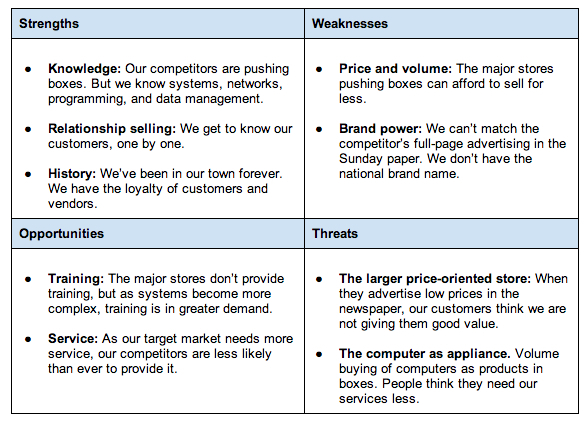
See our SWOT analysis examples article for in-depth examples of SWOT analyses for several different industries and business types or download our free SWOT analysis template .
- TOWS analysis: Developing strategies from your SWOT analysis
Once you have identified and prioritized your SWOT results, you can use them to develop short-term and long-term strategies for your business. After all, the true value of this exercise is in using the results to maximize the positive influences on your business and minimize the negative ones.
But how do you turn your SWOT results into strategies? One way to do this is to consider how your company’s strengths, weaknesses, opportunities, and threats overlap with each other. This is sometimes called a TOWS analysis.
For example, look at the strengths you identified, and then come up with ways to use those strengths to maximize the opportunities (these are strength-opportunity strategies). Then, look at how those same strengths can be used to minimize the threats you identified (these are strength-threats strategies).
Continuing this process, use the opportunities you identified to develop strategies that will minimize the weaknesses (weakness-opportunity strategies) or avoid the threats (weakness-threats strategies).
The following table might help you organize the strategies in each area:
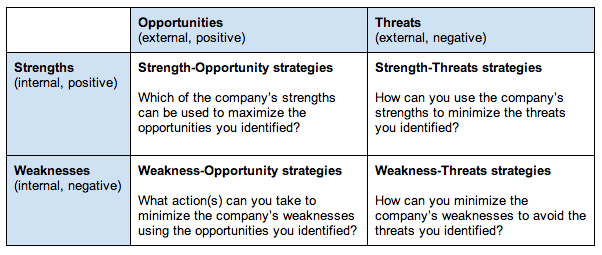
Once you’ve developed strategies and included them in your strategic plan, be sure to schedule regular review meetings. Use these meetings to talk about why the results of your strategies are different from what you’d planned (because they always will be) and decide what your team will do going forward.
See why 1.2 million entrepreneurs have written their business plans with LivePlan
Tim Berry is the founder and chairman of Palo Alto Software , a co-founder of Borland International, and a recognized expert in business planning. He has an MBA from Stanford and degrees with honors from the University of Oregon and the University of Notre Dame. Today, Tim dedicates most of his time to blogging, teaching and evangelizing for business planning.

Table of Contents
Related Articles

7 Min. Read
Build your promotional plan

4 Min. Read
Create a positioning statement

9 Min. Read
Create a unique value proposition

Craft your sales plan
The Bplans Newsletter
The Bplans Weekly
Subscribe now for weekly advice and free downloadable resources to help start and grow your business.
We care about your privacy. See our privacy policy .

The quickest way to turn a business idea into a business plan
Fill-in-the-blanks and automatic financials make it easy.
No thanks, I prefer writing 40-page documents.

Discover the world’s #1 plan building software
What Is a SWOT Analysis?

A SWOT (strengths, weaknesses, opportunities, threats) analysis is a visual framework used for strategic planning across all types of businesses and organizations. SWOT analyses are made up of four components that will help you determine the output of your team’s analysis.
What Does SWOT Analysis Stand For?
Opportunities, how do i do a swot analysis.

A SWOT analysis is a qualitative assessment of a company’s SWOT components. Individuals responsible for the assessment fill out a visual template similar to the figure above, which is usually laid out in a two-by-two matrix. This template helps visualize all the SWOT elements together in their entirety.
To understand in more detail the elements of this template, let’s dive into each component individually.
More From Built In Experts How Competitive Analysis Helps You Shine Over Your Rivals
What Are the 4 Components of a SWOT Analysis?
Your strengths are organizational features that provide a competitive and strategic advantage relative to the market and competition.
Weaknesses
Your weaknesses include organizational features that are lacking relative to market competition, or that hinder the organization’s overall effectiveness to compete, grow, and strive for optimal business performance.
These are favorable market conditions or external developments that represent an opportunity for unlocking or improving the organization’s competitive positioning and business performance. Opportunities can be related to present market conditions, but can also be forward-looking.
These are unfavorable market conditions or external developments that pose a risk to the organization’s performance or the entire viability of the current market. Threats can be related to present market conditions, but can also be forward-looking. (e.g. near-term competitive threats or geopolitical risks would be good examples to feature in this bucket)
- Strengths and weaknesses are factors that are owned (and thus controlled) by the organization. As a result, the organization and its team can directly influence strengths and weaknesses.
- Opportunities and threats are factors that cannot be controlled by the organization. For example, a near-term innovation trend or advantageous legal ruling that may come into play are considered opportunities, whereas near-term competitive innovation or geopolitical risks fall within the threats bucket. In either instance, your organization may prepare for these events, but it cannot control them.
During the process of filling in this template, you’ll consider all four elements individually. Once you complete the template, through brainstorming sessions and workshops, you can start putting together an actionable plan to capitalize on your strengths and opportunities while countering your weaknesses and threats.
More From Edoardo Romani DataCamp: What I Learned After 44 Courses and 308 Hours
SWOT Analysis Example
Let’s take, for example, a smartphone-producing company in the technology industry. Your example SWOT table may include the following.
Strengths :
- Strong brand positioning
- Loyal customer base
- High barriers to entry for the competition due to recent patent filings
Weaknesses:
- Recently departed CEO who led the company for the previous 15 years
- Production bottlenecks in key geographical regions
- Leaked PR documents
Opportunities:
- Customer trends indicating a shift towards higher-end smartphones in emerging markets
- Weakened competition due to a key competitor recently filing for bankruptcy
- Increased regulatory scrutiny
- Global chip shortage
As a result and potential plan of action, the company in question may decide to focus on mitigating the risks caused by its weaknesses (for example by increasing production in key regions close to the ones suffering bottlenecks in addition to selecting an experienced interim CEO as soon as possible) while seizing market opportunities that may not come about again (i.e. gaining market share in the short term by exploiting the competitor’s bankruptcy).
Overall, resource allocation should flow to:
- Seizing market opportunities
- Developing mitigation plans for market threats and investing in limiting potential damage or performance slowdowns caused by internal weaknesses
Why Use a SWOT Analysis?
The results of a SWOT analysis inform your company’s strategic plan and help you make decisions about how to allocate future resources. As a result of a SWOT analysis your team might decide on the following:
- investment/divestments related to a given product line
- international market entry or market expansions
- changes to the company’s position relative to its competition (based on factors such as price, target customers and barriers to entry among others)
- adjustments to external macroeconomic trends (raise in interest rates) or market-related dynamics (global supply chain constraints)
SWOT Analysis Advantages and Disadvantages
The SWOT analysis as a framework for strategic planning has received its fair share of critique and scrutiny. Let’s review some of the pros and cons.
SWOT Analysis Advantages
- 10,000-Foot View : A SWOT allows you to consider multiple factors that you might not normally associate together all at once (departing CEO and macro-trends, for example). This process can invite management to identify creative solutions to company issues that may have previously been hard to identify; having this combination of different sources of data, from internal balance-sheet metrics to market data points to press releases may enable your organization to find more comprehensive and representative patterns.
- Cross-Team Collaboration : SWOT analyses create space for the representation of multiple viewpoints within the organization. The exercise invites people from different departments of the organization to contribute and collaborate across departments, thereby enriching the overall quality of the SWOT analysis and enabling better communication across company silos.
- Simplicity: A SWOT is a simple framework that allows you to consider and break down complex problems that are usually considered and tackled separately but without a link to the bigger picture offered by a SWOT exercise.
- Simultaneous Consideration of Internal and External Factors : A SWOT allows us to relate internal factors with external factors, which is important since these two sides are usually considered separately from one another and only more broadly considered at the executive level. For this reason, conducting a SWOT exercise at the department level allows internal teams to understand how external forces influence and relate to their day-to-day operations.
More on Group and Organizational Analyses 7 Ways to Use Mind Mapping in Your Work
SWOT Analysis Disadvantages
- Groupthink and Bias: The generation of a SWOT chart is heavily influenced by the individuals tasked with the exercise. If the group isn’t diverse or made up of representatives from around the organization, the analysis will result in biased outcomes and lopsided strategies.
- Short Shelf Life : A SWOT analysis is a spot exercise, which means we typically perform them as a one-off planning effort. In fast-changing markets, its results (and, thus, its overall relevance) can go out of date quickly.
- Research shows a weak link between the SWOT exercise and actual strategic decision-making and organization follow-through. As a result, we’ve seen alternative frameworks emerge, most notably Porter's five forces analysis .

Built In’s expert contributor network publishes thoughtful, solutions-oriented stories written by innovative tech professionals. It is the tech industry’s definitive destination for sharing compelling, first-person accounts of problem-solving on the road to innovation.
Great Companies Need Great People. That's Where We Come In.

- Certifications
- Associate Business Strategy Professional
- Senior Business Strategy Professional
- Examination
- Partnership
- For Academic Affiliation
- For Training Companies
- For Corporates
- Help Center
- Associate Business Strategy Professional (ABSP™)
- Senior Business Strategy Professional (SBSP™)
- Certification Process
- TSI Certification Examination
- Get your Institution TSI Affiliated
- Become a Corporate Education Partner
- Become a Strategy Educator
Frequently Asked Questions
Swot analysis: how to strengthen your business plan.

Introduction
Every business, big or small needs a solid plan to succeed. A well-constructed business plan takes into account the strengths and weaknesses of a company and the opportunities and threats present in the marketplace. One of the most useful tools for assessing these factors is the SWOT analysis as it provides a comprehensive overview of a company's current situation and potential for growth. In this article, we will discuss what a SWOT analysis is, why it is important for businesses, who should conduct it, and how to conduct it effectively.
What is a SWOT analysis?
Have you ever wondered how businesses manage to evaluate all the internal and external factors that could affect their success? Welcome to the SWOT analysis. It's a strategic planning tool that helps businesses identify their Strengths, Weaknesses, Opportunities, and Threats.
Strengths refer to internal factors that give a company an edge over its competitors. Think of a strong brand, loyal customer base, experienced employees, or efficient operations. Weaknesses, on the other hand, are internal factors that put a company at a disadvantage. These could be a weak brand, lack of funding, inexperienced employees, or outdated technology .
But what about external factors that could impact a business's success? That's where Opportunities and Threats come in. Opportunities are external factors that could help a company grow and succeed. This could include a growing market, new trends, technological advancements, or changes in regulations. Threats, on the other hand, are external factors that could harm a company's growth and success. Examples of threats could be economic downturns, increased competition, changes in consumer behavior, or natural disasters.
By conducting a SWOT analysis, businesses can make informed decisions about their strategic initiatives. By focusing their resources on areas with the greatest potential for growth and competitive advantage, businesses can increase their profitability, market share, and long-term success. So, whether you're a business strategist, executive, manager, or consultant, SWOT analysis can provide a fresh perspective on your company's current situation and potential for growth .
Why is a SWOT analysis important for businesses?
A SWOT analysis is essential for developing a business plan that maximizes a company's strengths, minimizes its weaknesses, and takes advantage of opportunities while mitigating threats.
Here are some of the reasons why a SWOT analysis is important for businesses:
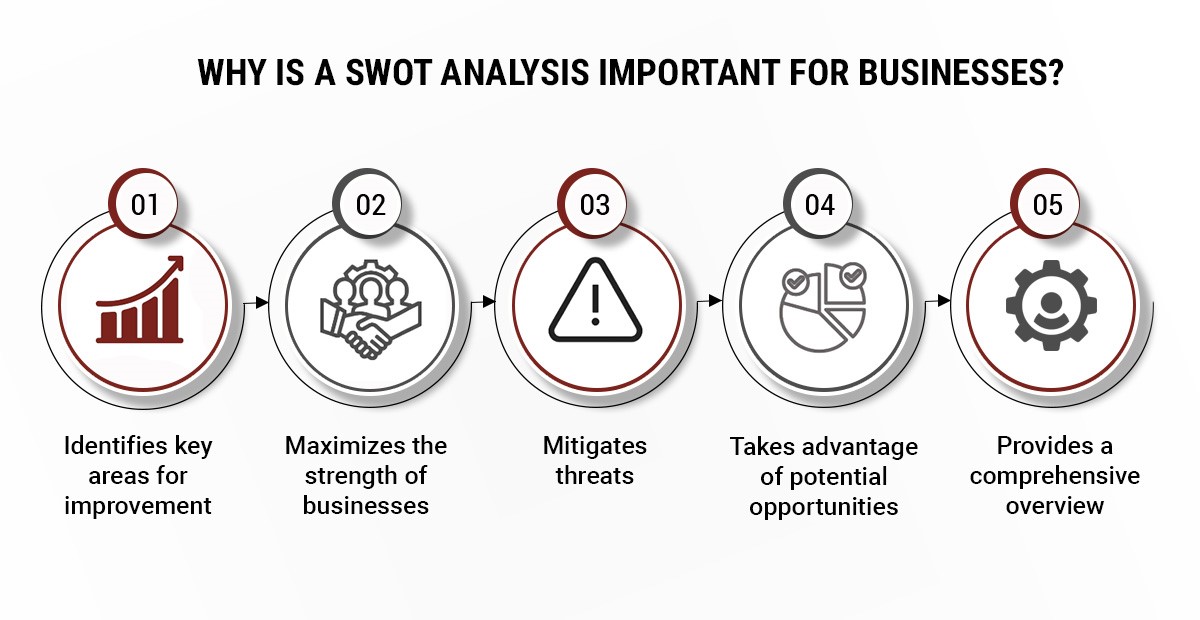
- Identifies key areas for improvement By conducting the SWOT analysis, businesses can gain a better understanding of their internal weaknesses and external threats, which enables them to prioritize areas for improvement. They can then focus their resources and efforts on those areas, which can help them become more competitive and improve their overall performance.
- Maximizes the strength of businesses In addition to identifying areas for improvement, SWOT analysis also helps businesses identify their strengths. By leveraging these strengths, businesses can differentiate themselves from their competitors and take advantage of their competitive advantages. This can lead to increased market share, improved profitability, and overall success.
- Mitigates threats SWOT analysis can help businesses identify potential threats to their operations and take proactive measures to mitigate them. This could include diversifying their product or service offerings, investing in risk management strategies, or developing contingency plans to minimize the impact of unforeseen events.
- Takes advantage of potential opportunities In addition to mitigating threats, SWOT analysis can also help businesses identify potential opportunities for growth and success. By capitalizing on these opportunities, businesses can increase their market share, expand their customer base, and improve their overall performance.
- Provides a comprehensive overview Finally, SWOT analysis provides a comprehensive overview of a company's internal and external factors. This can help businesses develop a well-informed business plan that takes into account their current situation and potential for growth. By developing a strategic plan based on the SWOT analysis, businesses can increase their chances of success and achieve their long-term goals.
How to conduct a SWOT analysis?
Now that we know what a SWOT analysis is and why it is important for businesses, let's discuss how to conduct a SWOT analysis effectively. Here are the steps involved:
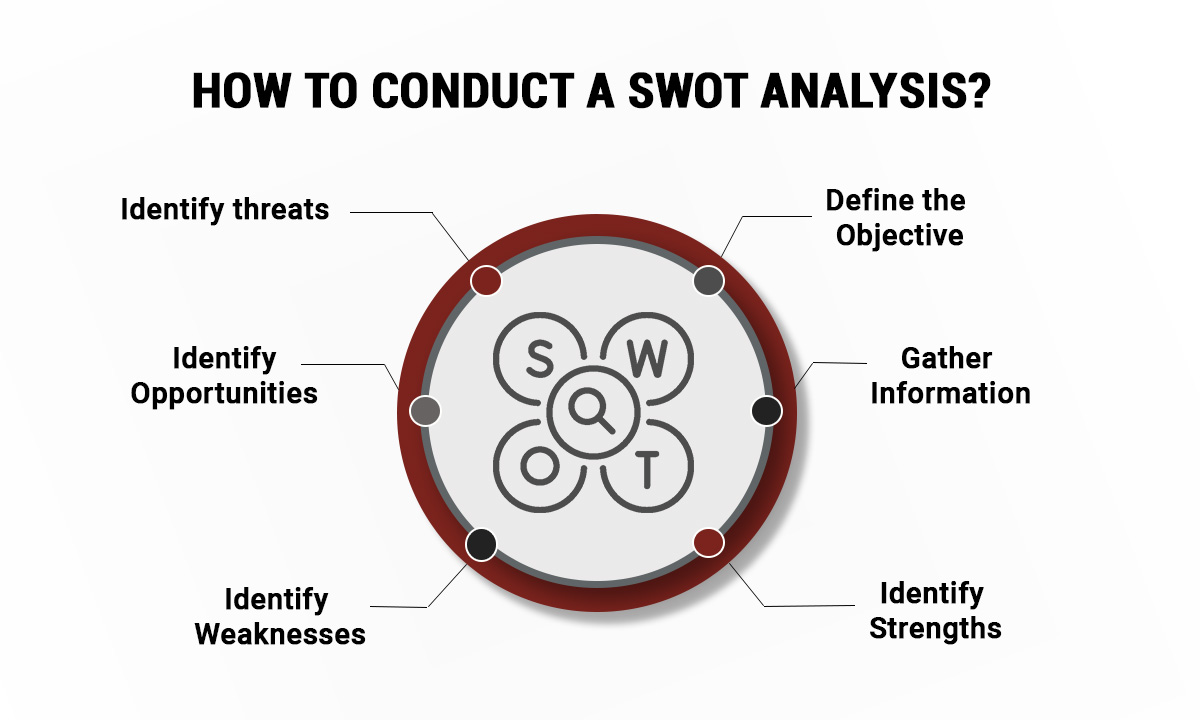
- Define the objective: The first step in conducting a SWOT analysis is to define the objective. What is the purpose of the analysis? What are the specific goals that the analysis aims to achieve? Defining the objective will help focus the analysis and ensure that it is relevant to the specific needs of the business.
- Gather information: Once you have defined the objective, the next step is to gather information about the business, its industry, and its competitors. This can include things like financial reports, customer feedback, market research, and competitor analysis.
- Identify strengths: What are the things that the business does well? What advantages does it have over its competitors? This can include things like a strong brand, loyal customer base, experienced employees, and efficient operations.
- Identify weaknesses: The next step is to identify the weaknesses of the business. What are the areas that need improvement? What disadvantages does it have compared to its competitors? This can include things like a weak brand, lack of funding, inexperienced employees, and outdated technology.
- Identify opportunities: To identify the opportunities available to the business , you need to address questions such as, What are the trends in the industry? What changes in regulations could benefit the business? What new technologies are emerging? This can include things like a growing market, new trends, technological advancements, and changes in regulations.
- Identify threats: The final step is to identify the threats to the business. What are the economic, social, and environmental factors that could impact the business negatively? What are the risks associated with the current situation and potential growth opportunities? This can include things like economic downturns, increased competition, changes in consumer behavior, and natural disasters.
Once the SWOT analysis is complete, the next step is to use the information to develop a strategic plan that maximizes the strengths of the business, minimizes its weaknesses, takes advantage of opportunities, and mitigates threats.
Who should conduct a SWOT analysis and what are the benefits?
A SWOT analysis can be conducted by anyone involved in the strategic planning process of a business. This can include business strategists , executives, managers, and consultants. Here are some of the benefits of conducting a SWOT analysis:
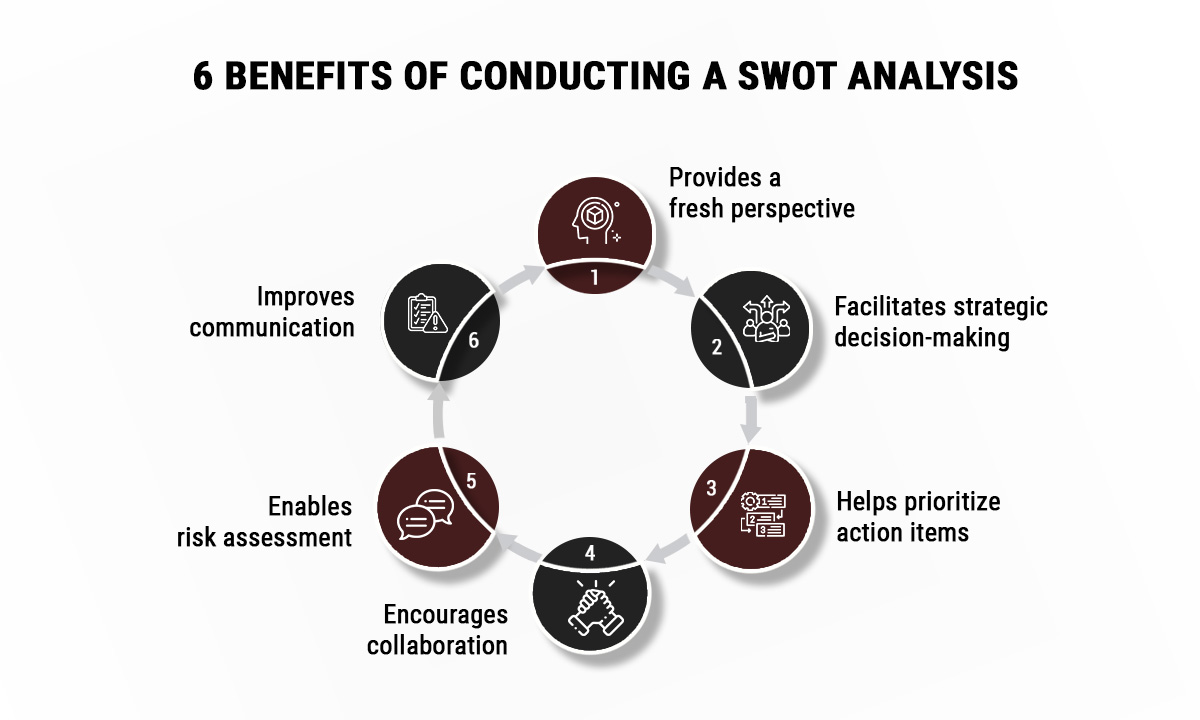
- Provides a fresh perspective on a company's strengths, weaknesses, opportunities, and threats, allowing for a more objective view of the situation.
- Facilitates strategic decision-making that enables businesses to make informed strategic decisions based on their current situation and potential for growth.
- Helps prioritize action items based on their importance and potential impact to the business.
- Encourages collaboration among team members, allowing for a more comprehensive analysis of the situation.
- Enables risk assessment associated with their current situation and potential growth opportunities.
- Improves communication among team members, ensuring that everyone is on the same page regarding the current situation and potential for growth.
This information helps businesses to prioritize their key strategic initiatives, focus their resources on areas with the greatest potential for growth and competitive advantage, and develop a strategic plan that aligns with their goals and objectives. Ultimately, a SWOT analysis helps businesses to make more effective strategic decisions that can lead to increased profitability, market share, and long-term success.
Example of a SWOT analysis
To help illustrate the SWOT analysis process, let's take a look at an example of a SWOT analysis for a company in the fashion industry:
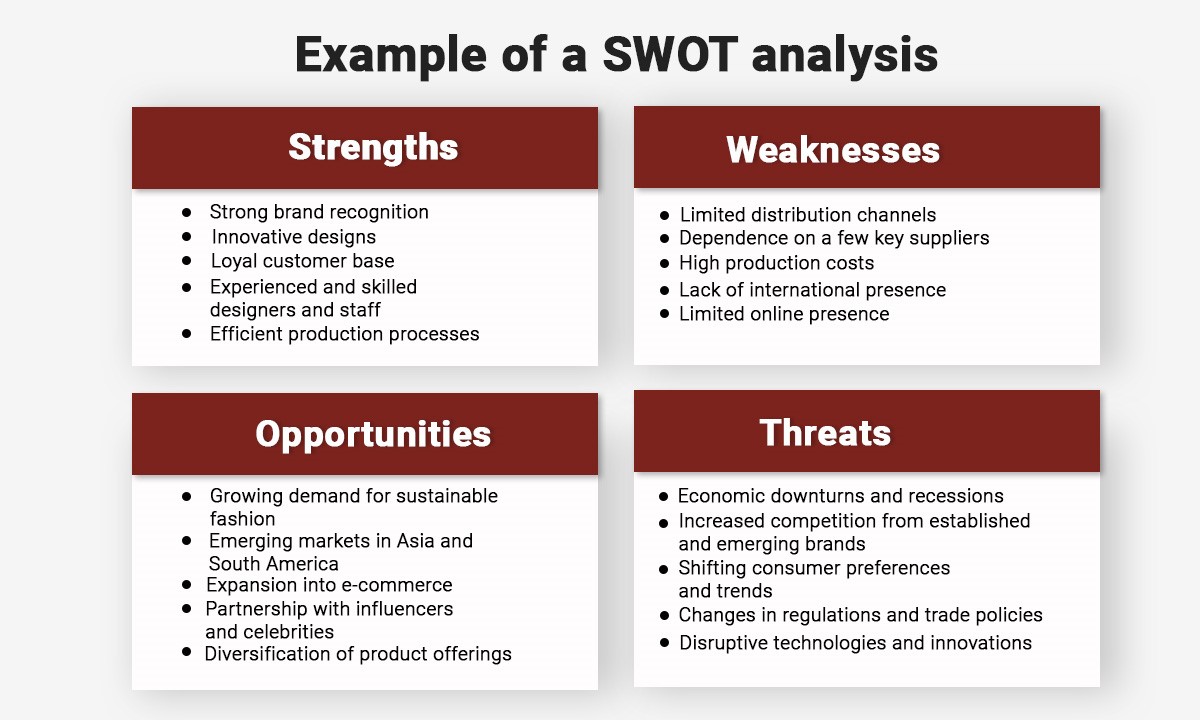
- Strong brand recognition
- Innovative designs
- Loyal customer base
- Experienced and skilled designers and staff
- Efficient production processes
- Limited distribution channels
- Dependence on a few key suppliers
- High production costs
- Lack of international presence
- Limited online presence
Opportunities
- Growing demand for sustainable fashion
- Emerging markets in Asia and South America
- Expansion into e-commerce
- Partnership with influencers and celebrities
- Diversification of product offerings
- Economic downturns and recessions
- Increased competition from established and emerging brands
- Shifting consumer preferences and trends
- Changes in regulations and trade policies
- Disruptive technologies and innovations
Using this SWOT analysis, the company could focus on expanding its distribution channels and international presence, reducing production costs, and investing in sustainable and diverse product offerings.
Q: Is a SWOT analysis only for large businesses? A: No, a SWOT analysis is beneficial for businesses of all sizes, including small businesses.
Q: Can a SWOT analysis be conducted for a specific project or product? A: Yes, a SWOT analysis can be conducted for a specific project or product to evaluate its strengths, weaknesses, opportunities, and threats.
Q: How often should a SWOT analysis be conducted? A: It is recommended to conduct a SWOT analysis at least once a year or whenever there are significant changes in the industry, competition, or business environment.
Q: What should I do with the information gathered from a SWOT analysis? A: The information gathered from a SWOT analysis should be used to develop a strategic plan that maximizes strengths, minimizes weaknesses, takes advantage of opportunities, and mitigates threats.
In conclusion, a SWOT analysis is an important tool that can help businesses of all sizes and industries to identify their strengths, weaknesses, opportunities, and threats. By conducting a SWOT analysis, businesses can gain a better understanding of their current situation and potential growth opportunities, enabling them to make informed business decisions and develop effective business strategies. As a strategic leader or business strategist, it is important to conduct a SWOT analysis regularly to stay up-to-date with changes in the industry and competition, and ensure that your business plan is relevant and effective in achieving your business goals.

Recent Posts

How Data Analytics Can Revolutionize Your Business - A Strategist's Guide
Download this Strategist's Guide to empower yourself with resourceful insights:
- Roadblocks to Data Usage
- Advantages that Data Analytics offer for businesses
- Elements of a Data Analytics Strategy
- Top reasons why businesses must adopt a Data Analytics Strategy
- Case studies, Scenarios, and more

CredBadge™ is a proprietary, secure, digital badging platform that provides for seamless authentication and verification of credentials across digital media worldwide.
CredBadge™ powered credentials ensure that professionals can showcase and verify their qualifications and credentials across all digital platforms, and at any time, across the planet.

Verify A Credential
Please enter the License Number/Unique Credential Code of the certificant. Results will be displayed if the person holds an active credential from TSI.
Stay Informed!
Keep yourself informed on the latest updates and information about business strategy by subscribing to our newsletter.
Start Your Journey with The Strategy Institute by Creating Your myTSI Account Today.
- Manage your professional profile conveniently.
- Manage your credentials anytime.
- Share your experiences and ideas with The Strategy Institute.
Account Login
- Remember Password
- Forgot Password?
Forgot Password
More Like this
How to do a swot analysis in 5 steps, a refresher on swot.
SWOT stands for Strengths, Weaknesses, Opportunities, and Threats. The purpose of a SWOT analysis is to objectively review what your organization is and isn’t doing well to create a synthesized view of the current state of your organization. This article will further help you on how to do a SWOT analysis. But, if you need a refresher, be sure to read our introductory post here !
Excellent strategic planning begins with a keen understanding of where you are today to build a bright and prosperous future. A key concept to remember is identifying the attribute and its impact, be it positive or negative.
A SWOT analysis is a great way to identify, organize, and fully determine your current state.
We’ll discuss what it is in more detail, how to pull it all together, and then most importantly, explain how to effectively put it to use while you have the momentum to do so.

Step 1: Gather the Data You Need Internally and Externally
A SWOT analysis, by definition, is designed to look at the internal and external forces that hinder or enable your organization and what market forces you need to seize or mitigate. Need help with your SWOT? Use this SWOT template with examples!
A complete SWOT analysis requires examining internal and external data to create a holistic assessment of your organization’s current state.
Pro Tip – Without data, a SWOT can be filled with opinions instead of data and facts. You can lean into your team’s opinions, but they shouldn’t be the sole basis for your SWOT. Lean on good data.
Internal Data Sources
- Past 3 Years Revenue & Next 3- to 5-Year Forecast – Revenue by customer segment, revenue by product line/service offering.
- Profitability – Operating costs, EBITDA by line of business or market.
- Marketing Performance – Web traffic analytics, keyword reports, earned and paid media performance and for a few share-of-voice might be a data point you capture.
- Sales Performance and Pipelines – Closed business, pipeline forecast, time to close.
- Staff Insights – Including employee engagement/satisfaction, product or service delivery performance.
- Customer Insights & Customer Analytics – Log in sessions, time spent using product, average customer value, customer satisfaction/ratings and needs, customer surveys.
External Data Sources
- Consumer Data – Demographics, media consumption, social media usage, consumer behavior.
- Labor Markets – Labor forecasts, labor market size, labor growth or reduction.
- Economic Forecasts – Market sizing, market growth, consumer spending forecasts.
- Marketing Data – Addressable search traffic, addressable audience sizes, industry CPC or CPA averages.
- Competitor Data – From industry reports, marketing data available, or review sites.
- Supply Chain Data – Lead times, availability of a product for manufacturing, shipping routes or times.
- Local Data – Growth or reduction in metros, population by zip code, demographics by zip code.
- Real Estate – Forecasted commercial/residential values, market forecasts for rent, affordability indexes.
Get the Free Guide and Canvas to Create a SWOT Analysis
Step 2: assess your internal strengths.
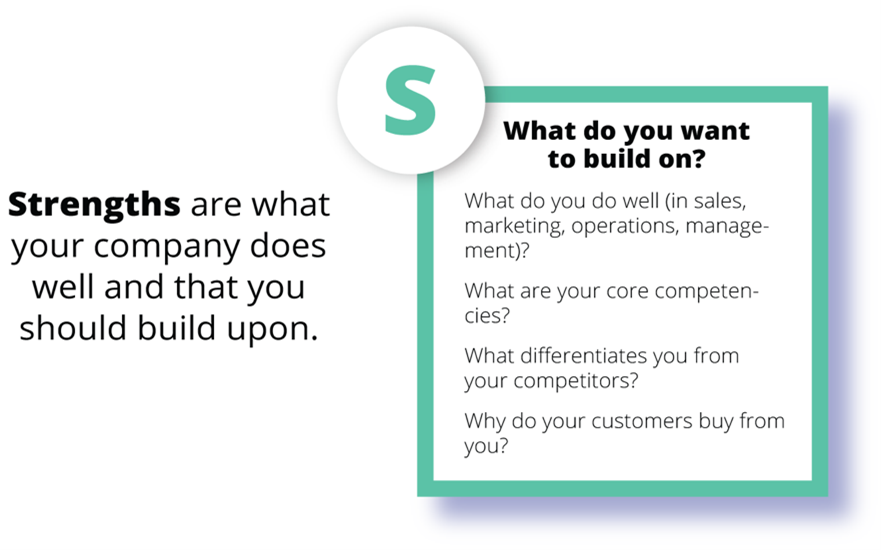
Look within and focus on the experience and resources you have today that you can further develop and lean on for continued success.
Pro Tip – Your growth strategy and competitive advantages start here. You need to know what you do well today to determine how it will play into your approach to growth and if the unique strengths you possess are your competitive advantages.
Questions to ask to help identify your organization’s strengths?
- What are your core competencies?
- What differentiates you from your competitors? What do you do better than your competitors?
- Why do your customers buy from you?
- What do you do well in marketing, sales, or operations?
- Do you have any strengths financially?
- Do you have strengths in your customer service?
Example Data Sources and Ideas for Strengths
- What positive feedback have you received from your customers? Are those strengths?
- What do your employees say during assessments or surveys about your organization’s strengths?
- NPS scores can help identify strengths.
- What does your internal data tell you about your current strengths? How do you perform well in marketing, sales, financial management, position, or operations?
Step 3: Assess Your Internal Weaknesses
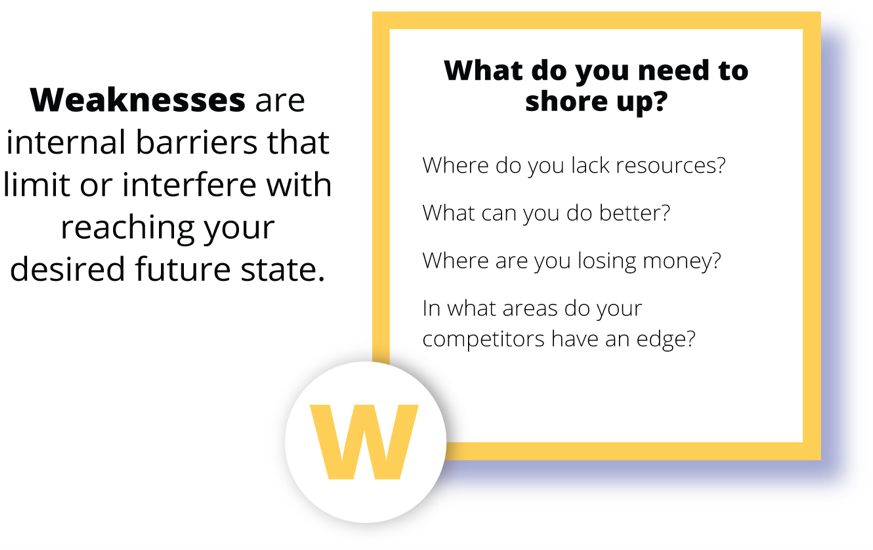
This can feel like a vulnerable, critical part of completing your SWOT analysis because it requires a level of self-criticism and honesty that can be daunting – but remember, it can be a rewarding exercise if done with objectivity and clarity. You get the chance to identify what’s not working in your organization and how you might address those issues to better support your vision and mission.
Pro Tip – You’ll need to take a step back and be vulnerable and honest about your weaknesses. If you are honest, you’ll be able to create strategies or initiatives to solve your organization’s biggest weaknesses.
Questions to Answer
- Where do you lack resources?
- What can you do better?
- Where are you losing money?
- In what areas do your competitors have an edge?
Example Data Sources and Areas to Look for Weaknesses
- Negative feedback received from customers.
- Critical feedback from employee assessments or surveys.
- Draws on your NPS scores.
- Looking at employee turnover rates and exit interviews.
- Company workflows and efficiency rates.
- Operational inefficiencies, dragging profitability, or overhead costs.
Step 4: Assess Your External Opportunities

Finding opportunities based in your market takes research, a bit of creativity, and skill. It’s about finding external market opportunities that your organization is well positioned to take advantage of, and sometimes it requires thinking outside of the box.
Opportunities rely solely on external sources, which requires digging and finding good data sources to review your market. And because it’s based on external data, it can be a more challenging section of your SWOT. But it can be refreshing to complete this section in your SWOT because you get to see the world through the lens of an optimist. You’ll get to examine economic and market trends, environmental concerns, and political/governmental regulations that could propel your organization to your desired future state.
Pro Tip – The world is in a constant state of change. When assessing your market opportunities, look for current data and emerging market trends. A market report from 3 years ago might still be relevant but be critical about your sources. Current data is important.
Questions to Answer:
- What are the needs of your customers currently unmet by your organization? Are you positioned to meet those needs?
- Are there economic trends you might capitalize on?
- What are the emerging political and social opportunities that you need to capitalize on?
- What niches have your competitors missed in the marketplace?
Example Data Sources to Consider
- Are there any opportunities within changing consumer habits you can capitalize on?
- Economic forecasts for your geography or industry.
- Holes in the market your competitors have missed.
- Opportunities to change or modify your supply chain for your benefit.
- Political or governmental forces to benefit from.
- What political or governmental forces could you benefit from?
- How could the change in real estate benefit your organization?
- How can you play the shifting global economy to your advantage?
Step 5: Assess Your External Threats
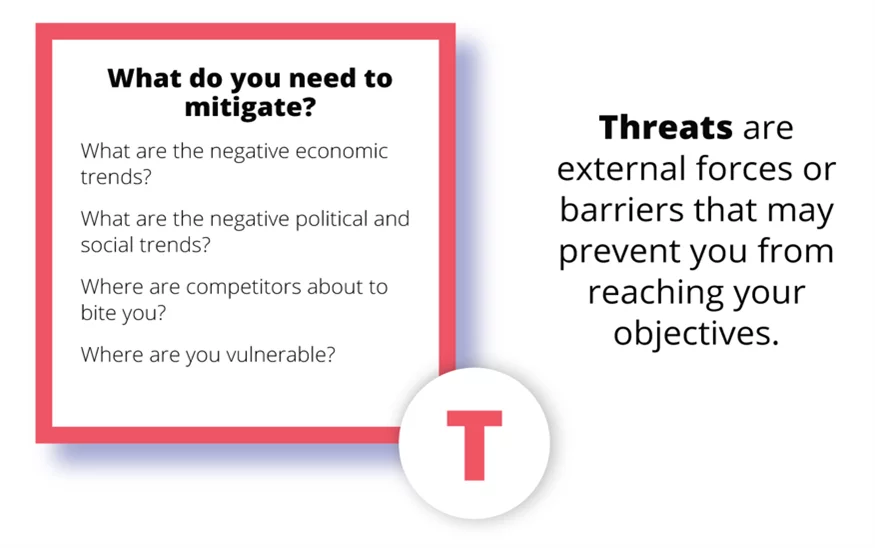
Threats are external factors out of your control that can hurt your organization. A threat is not a weakness; those are internal factors that you can generally solve with intention. A threat must be identified to reduce the risk of harm or mitigate possible damages.
Pro Tip – Threats can be mitigated, sometimes. In other cases, it’s just something you need to watch closely and respond to when necessary.
- What negative economic trends do you need to mitigate?
- What are negative political or social trends you need to address?
- Where are competitors about to bite you?
- Where are you vulnerable?
- What other external forces do you need to mitigate?
- Disruptions in the global supply chain could threaten your businesses.
- Threats in your competitive environment from new or emerging competitors.
- Shifts in your target audiences.
- Changes in technology threaten your competitive advantages.
- Shifting economic forecasts that are not in your favor.
- Increasing costs of living for your employees.
- Rising real estate prices impacting your organization’s rent.
- Tight labor markets make it challenging to attract talent.
How You Know You Got it Right
Standing back and addressing your current state requires digging deep, getting a bit uncomfortable, and thinking hard about where your organization currently stands today.
Here’s the checklist of an awesome SWOT analysis:
- Does your SWOT contain all the key areas relevant to your plan? This needs to include insights about customers, employees, leadership, competitors, industry trends, and external market forces.
- Does each item in your SWOT identify the attribute and the impact?
- Is each item under strengths and weaknesses internal and controllable?
- Are the items under opportunities and threats external and not controllable?
- Were you honest about the potential threats and dug deep enough to find the ones you may not want to see?
You’ve Done Your SWOT? What’s Next?
Now that you’ve done the heavy lifting, how do you make sure your hard work isn’t in vain? You use what you’ve got to get what you want, which is a roadmap to success. The most important thing is to use your SWOT to turn the information into goals, actions, and other elements of your strategic plan.

Strengths – Create Goals & Identify Competitive Advantages
The strengths section of a SWOT helps create a few specific outputs. The first of which is to help create goals and actions for your team to build upon your strengths.
The second output of your strengths is to help your organization identify its competitive advantages. We’ve covered this extensively in our competitive advantages post and guide, so check that out here !
Examples of Strengths
- How do you build upon your strong brand reputation?
- How can you continue to have high staff retention and build an amazing culture? Could a Diversity, Equity, and Accessibility initiative help create an inclusive culture?
- If you have great marketing presence, what can you do to improve it even further?
Weaknesses – Pick Urgent and Important Themes to Address
The weaknesses section helps your organization identify clear areas of improvement. The key here is that you need to decide what is most important or urgent to act upon, and then create goals or actions in your plan to address these weaknesses.
Looking at your weaknesses, it is entirely within your ability to control and change them, so you can create initiatives to solve areas of concern. It is recommended to start with the most pertinent and then work your way through the list from there.
Examples to Show How to do a SWOT Analysis
- If you have high turnover and unhappy employees, examine what can be done to change behaviors, outcomes, and improve your culture. Identify key areas of concern and make commitments to shifting that methodology or behavior.
- Examine work processes and determine how to make things simpler.
- Invest in employee learning and development to increase their value both intrinsically and to the organization.
- Examine your physical real estate and determine the need for it in relation to a remote work environment, or you can make changes like reconfiguring, growing, or downsizing your office space.
Opportunities – Prioritize Your Opportunities, Build a Growth Strategy
Examine your opportunities and create short-term and long-term goals focusing on how to strategically go after them to win more business or benefits for your organization.
Your external opportunities paired with your competitive advantages are what feed your growth strategy. Check out our post and guide on building your growth strategy !
Pro Tip – Have too many opportunities and not sure what you need to prioritize? Check out our guide on prioritizing opportunities .
Threats – Watch, and Refresh them Quarterly
In most cases, your SWOTs won’t have a significant number of threats, but look at the few you do have as an opportunity to create proactive initiatives.
If you don’t need to create proactive initiatives, it is best to review and refresh them quarterly to see if anything is an emerging threat.
Final Reminder – If You Create a SWOT, Use It!
Last tip, whatever you do, do not go through the exercise of putting your SWOT together and then fail to put it to good use. We see that ALL the time. Make sure you use your SWOT to build out your goals and your competitive advantages to set yourself apart and create a winning roadmap for success. Happy strategizing!
Frequently asked questions
Still not sure how to conduct a SWOT analysis? Read our Frequently Asked Questions for more clarity.
OnStrategy recommends five tips to help you easily and thoughtfully develop your own SWOT analysis:
- Use clear, verifiable, and quantifiable data to form your SWOT- not just opinions.
- Be clear and write complete sentences, not just singular words. For example, instead of citing ‘recruitment’ as a weakness, instead explain ‘Open positions take three or more months to fill’…
- Only include entries that lead to action
- If internal opportunities are also identified, be sure to separate the internal opportunities from the external opportunities. Keep it clear and concise, not convoluted!
- Engage multiple levels of the organization to create your SWOT, not just your executive team.
A PESTLE analysis can serve as a great alternative or addition to your SWOT analysis. It looks at the various environmental/external forces your organization may come up against such as political, economic, sociological, technological, legal, and environmental forces that can prove as either threats or opportunities to your business.
Comments Cancel
Join 60,000 other leaders engaged in transforming their organizations., subscribe to get the latest agile strategy best practices, free guides, case studies, and videos in your inbox every week..

Leading strategy? Join our FREE community.
Become a member of the chief strategy officer collaborative..

Free monthly sessions and exclusive content.
Do you want to 2x your impact.
BUSINESS STRATEGIES
SWOT analysis: what is it and how to do it for your business
- Cecilia Lazzaro Blasbalg
- Jul 27, 2021

You can be a seasoned company with an established business plan, or be starting out and create a website for your new venture. Either way, identifying and understanding your competitors at each step of the process can lead to building a better business strategy.
This is where a SWOT analysis comes into play. It is a useful tool for making improvements and keeping your marketing goals on track. In this guide, we’ll explain what this method is all about and how to do a SWOT analysis of your own.
What is a SWOT analysis?
SWOT is an acronym for Strengths, Weaknesses, Opportunities, and Threats. A SWOT analysis is a strategy used by businesses for measuring and evaluating their overall performance, and that of competitors, in an objective manner. All these factors help business owners make smarter decisions for their company, such as if a venture should grow into a new field or rebrand itself.
The first two parameters, strengths and weaknesses, involve internal factors such as your reputation, team, location and intellectual property. These considerations are not necessarily permanent, and can fluctuate over time. It’s within an organization's own control to keep or change them (which can happen for the better or the worse). So, assuming you want to make a positive change, you’re going to need to put forth the effort and time to see that happen.
Opportunities and threats are related to external influences such as competitors, market trends, and prices of materials. Unfortunately, these are not within an organization’s control, and therefore you are not able to change them. That said, successful businesses and corporations learn how to work with these factors to their advantage, and also adapt their strategies accordingly in order to compete with others in the field.
Why do a SWOT analysis
As mentioned earlier, SWOT analysis is a lengthy process that can help different types of businesses draw conclusions by enabling them to see the bigger picture clearly. Once they have obtained valuable data and insight, only then can businesses formulate a clever and strategic plan accordingly.
Furthermore, a SWOT analysis forces you to examine your business in new and interesting ways vis-à-vis your strengths and weaknesses. This preparedness enables you to not only be ready for any challenges that might impact your business, but also offers a deeper understanding of potential opportunities or threats within your target market .
How to do a SWOT analysis
SWOT analysis should be a collaborative and inclusive process, so before you can really dive in, be sure to assemble your partners, stakeholders and any other decision-makers who will bring their ideas to the table. This way you’ll ensure you hear multiple opinions and diverse outlooks that’ll enrich your overall SWOT discussion ahead.
Below, we’ll walk through the stages of how to do a SWOT analysis for reviewing both your own company and competitors. For each one, grab a white board, sheet of paper, or another note-taking device. On this, create four sections for each company you’ll analyze. Label the sections with these parts: strengths, weaknesses, opportunities, and threats. And remember that when it comes to this type of analysis, leave out the bias. The more honest you are, the better and more useful your results will be.

Steps on how to do a SWOT analysis:
In order to get a better sense of what a complete SWOT analysis might look like, we’ve taken the example of a hypothetical massage therapist who is starting a service business.
Identify your company strengths
Be aware of your weaknesses
Recognize business opportunities
Understand potential threats
Make a business plan
01. Identify your strengths
Strengths are the big things that a particular company is doing well, which gives them a competitive advantage in their industry and benefits their customers. For your own business, identifying your strengths can help you leverage these by making them stronger.
For competitors, consider their strengths a goal to aim for. Ask yourself, How can I do what they do, but better? or, How can I create my own twist on this idea that outsmarts theirs?
Here are a few questions to consider as you begin your SWOT analysis:
What are this company’s competitive advantages in the industry?
What features do they offer that are unique and valuable?
What processes are they excelling in?
What draws customers in?
Are they a market leader? If so, how did they get here?
Is the organization expanding and hiring new employees?
What strong assets does the company have, i.e., intellectual property, stakeholders, buildings, etc.?
02. Be aware of your weaknesses
These are the aspects of an organization that could use some improvement. During this stage of a SWOT analysis, it’s especially important to be honest with yourself. It might be a bit uncomfortable at first, but if you don’t draw attention to a weakness, there won’t be room for you to make it better.
Note that many of the points you analyzed from the strengths above can be addressed in this section as well, but with a reverse meaning. For example, a strength might be “expanding their business and hiring new people,” while a weakness could be “losing employees to competition.” So think about those as options in addition to these kinds of questions:
What could this company do better?
What processes could be improved?
Is this company lacking an established reputation?
What is this company struggling with compared to others in the industry?
What do customers often complain about?
Is the organization losing employees?
What assets is the company lacking, from patents to funding to employee positions and more?

03. Recognize business opportunities
Owning a business is all about seizing the moment. Opportunities are probably the same for yourself and your competition, if not very similar. Recognizing them is the first step, and taking advantage of them before your competition does is the second. Likewise, you should do so at the determined time that makes the most sense for your business, depending on what stage of development you’re in. Here are more questions for doing a SWOT analysis the right way:
What is the latest trend, such as a green initiative to use recycled packaging or working with social media influencers for promotion?
What are some upcoming events to take advantage of, such as a trade show, holiday or recent news release?
Is there a loophole in your market, such as a cheaper supplier or opportunity to eliminate the middleman?
Is there an opportunity to expand to a larger building or better location?
Could the business be sold soon? Or on the other hand, could this business buy smaller, local businesses to expand?
04. Understand potential threats
These are external factors which can put a business in a negative light. And just like opportunities, threats are often similar for both you and your competitors. However, some threats can be individual to an organization, such as a particularly bad PR scandal from an unhappy customer. It’s extremely important to learn how to mitigate these, and prevent them from turning into larger issues in the future.
Although threats come last in the SWOT analysis, it might be a good idea to address them first off paper. Like a small fire, if you don’t act quickly, threats can sometimes cause irreplaceable damage.
Here are examples of potential threats:
Is a customer expressly unhappy with a particular product or service?
Is the market fluctuating, i.e., are prices rising, are consumers purchasing alternatives, etc.?
Are there new government regulations to watch out for?
What is it that they are doing better? Do some market research to find out.
Will new technology become available in the near future that could make this business’s products or services obsolete?
Are consumers no longer expressing interest in these services?

05. Make a business plan
Now that you’ve laid out the most important components affecting the success of your organization and your competition, you have the tools you need to develop a strategy. This plan will guide you to make improvements in your company, and compete on a level playground with your competition.
Consider these five steps in working through your plan:
Get feedback on your own SWOT analysis from your employees and other relevant stakeholders.
Draw out a plan, which involves using your strengths to counteract your weaknesses, as well as finding opportunities through your threats. If you’re just starting a business , write out these components as a part of your business plan , too.
Communicate your ideas to your team members, making sure that everyone is on board and held accountable.
Prioritize your action items, starting with the most important factors first. (Perhaps these are your threats if they are urgent matters.)
Execute your plan with a business proposal . Introduce the plan in the format of listed action items for your team, making sure to assign a designated person for each topic.
As your business continues to grow and evolve, know that this is just a snapshot of a moment in time. Many of these factors are subject to change at a later date. It’s a good idea to come back to this exercise in the future so that you can properly assess where your business stands in your industry and how far along you came.
Related Posts
10 best author websites for inspiration
7 tips for spring cleaning your small business, according to experts
How to start an LLC in Missouri
Was this article helpful?
How To Write a SWOT Analysis For a Business Plan
An acronym standing for Strengths, Weaknesses, Opportunities, and Threats, a SWOT Analysis is designed to help you analyze your company’s capabilities against the realities of your business environment. Doing so allows you to direct your business toward areas where your abilities are the strongest and your opportunities are abundant. It also allows you to develop short and long-term strategies for your business. A well-developed SWOT analysis will:
- capture business opportunities by capitalizing on business strengths
- overcome weaknesses to take advantage of business opportunities
- monitor potentially threatening outside forces while maintaining or developing internal strength response capabilities
- eliminate weaknesses to protect your business from threats
Writing a SWOT Analysis
When writing your SWOT Analysis, we recommend involving employees with different perspectives and stakes in your company, for example, management, sales, customer service, and customers.
To write a SWOT Analysis for a business plan, we recommend following these four steps. You can use a four-square SWOT Analysis template, or if more manageable, you can make lists for each category.
Example of a four-square template:

After you’ve gathered the right group of employees together, brainstorm your company’s strengths and weaknesses and its opportunities and threats, first individually and then collectively.
Strengths and weaknesses are internal to your company and can change over time with work. Examples of internal factors include:
- Company culture
- Company image
- Operational efficiency
- Operational capacity
- Brand awareness
- Market share
- Financial resources
- Organizational structure
Opportunities and threats are external, happening whether you want them to or not, and can’t be changed. Examples of external factors include:
- Societal changes
- Competitors
- Economic environment
- Government regulations
- Market trends
Strengths refer to the positive, tangible and intangible attributes internal to your company that are within your control.
To help you determine what your company’s strengths are, ask yourself:
- What does the company do well?
- The positive attributes of your employees (knowledge, background, education, credentials, network, reputation, or skills)
- The tangible assets of the company (capital, credit, existing customers or distribution channels, patents, or technology)
- What advantages does the company have over our competitors?
- Do we have strong research and development capabilities? What about manufacturing facilities?
- What other positive aspects, internal to the business, add value or offer us a competitive advantage?
Any aspect of your business that detracts from the value you offer or places you at a competitive disadvantage is a weakness. To determine your company’s weaknesses, ask yourself these questions:
- What factors detract from a competitive edge?
- To accomplish my objectives or compete with my strongest competitor, what areas need to improve?
- What does the business lack? Is it expertise? Maybe it’s access to skills or technology?
- Does the company have limited resources?
- Is my business in a poor location?
Opportunities
Opportunities are attractive external factors that denote reasons your business is likely to thrive. To identify your business opportunities, ask yourself:
- What opportunities are there in my market or my environment that I can benefit from?
- Does my business have a positive perception?
- Has my market recently grown, or have there been other changes that have created an opportunity?
- Is this opportunity ongoing or time-limited? How critical is my timing?
Any external factor beyond your control that could place your strategy, or the business itself, at risk is a threat. Although you have no control over threats, you can benefit by having a contingency plan to address them if and when they occur. To identify threats, ask yourself:
- Who are my existing or potential competitors?
- What factors beyond my control could place my business at risk?
- Are there challenges created by an unfavourable trend or development that could lead to declining revenues or profits?
- What situations could threaten my marketing efforts?
- Have supplier prices or the availability of raw materials significantly changed?
- Are there any shifts in consumer behaviour, the economy, or government regulations that could reduce my sales?
- Are any of my products, equipment, or services obsolete due to the introduction of a new product or technology in the market?
Once you’ve brainstormed your lists of strengths, weaknesses, opportunities, and threats, we recommend ranking them through a voting process. At the end of this process, you should have a prioritized list of ideas, with one person, usually the CEO, having the final call on priority.

Divide your strengths into two groups:
- Group 1: Strengths that can help you take advantage of opportunities facing your business.
- Group 2: Strengths that can help you head off potential threats.
Divide your weaknesses into two groups:
- Group 1: Weaknesses that require improvement before you can take advantage of opportunities.
- Group 2: Weaknesses that you need to completely and quickly overhaul and convert into strengths to avert potential threats to your business.
Continually refer to your lists as you make decisions that contribute to your business, including developing strategies and actions for capitalizing on opportunities. Questions that can guide your decision making include:
- Do strengths open any opportunities?
- How can we convert weaknesses to strengths?
- What do we have to do to take advantage of opportunities?
- How can we best neutralize threats?
SWOT Analysis For a Business Plan Conclusion
Once you have finalized your SWOT Analysis and added it to your business plan, don’t just leave it and forget it. A SWOT Analysis is a crucial element in any business plan and should be revisited regularly, at least annually.
Suppose your business is facing significant changes in the marketplace or competitive conditions, experiencing growth problems, or failing to meet goals. In that case, you may want to revisit your SWOT Analysis more frequently.
It should reflect the world around you as it is, not the way it was. It’s an invaluable tool for leveraging your company’s strengths, minimizing threats, taking advantage of available opportunities, strategic planning, and determining company objectives.
At Bsbcon, we are available to provide support and guidance with your company’s SWOT Analysis, ensuring that it reflects the current state of your business and considers all factors needed to ensure your business’s short and long-term goals and successes. Once your SWOT Analysis is complete, we will work with you to incorporate it seamlessly into your business plan.
Each of our business plans are tailor-made (no templates or plugins!) and designed to be easily implementable in practice. We have business plans for bank loans, investors, strategic purposes, immigration, and more.
Contact us today to get started on accomplishing everything you’ve dreamed with consumer-tested, expert panel-approved business plans that outline your steps to success.
How can we help you?
Get in touch with us or visit our office
- United States
- Meet The Team
- Partnerships
- Testimonials
How to Use a SWOT Analysis for Strategic Planning
By Jibility Co-Founder Chuen Seet
A SWOT analysis is a popular business analysis method that business leaders use to produce a current, high-level understanding of their business. SWOT stands for Strengths, Weakness, Opportunities, and Threats.
Arranged in a 2×2 matrix, a SWOT analysis is easy to create and easy to understand, making it a useful starting point in the strategic planning process. However, a SWOT analysis only presents a static view of a business’s current situation – so we’ll also be exploring how to use a completed SWOT analysis to create a dynamic, actionable strategic roadmap !
Components of a SWOT Analysis
As we mentioned earlier, SWOT stands for Strengths, Weaknesses, Opportunities, and Threats. During a SWOT analysis, you’ll be dividing the internal and external factors that affect your organization into one of these four categories, so it’s important to understand what each category represents.
In a SWOT analysis, strengths represent what your organization already does well. These are the factors that define your brand and give you a competitive advantage . Questions you might ask yourself to define your strengths include:
- In what areas does our business already excel?
- What assets do we already have that will drive our current and future success?
- Why would customers choose our business over a competitor’s?
During the strategic planning process, you will want to create a plan that plays to (and preserves) your strengths, leveraging them to help your organization realize its strategic vision.
Weaknesses are the areas that hold your business back from optimal performance. These are the gaps in your business capabilities that will need to be addressed in order to achieve your goals. During a SWOT analysis, you will want to ask yourself questions to define your weaknesses:
- In what areas does our business struggle to perform?
- Why would some customers choose competitors over our brand?
- What are the gaps in capability that will need to be addressed in order for our business to realize its vision?
A strategic plan should address and mitigate your weaknesses in order to achieve your objectives. Later in the strategic planning process, conducting capability-based planning and utilizing prioritization matrixes can help you define and prioritize business actions to shore up your weaknesses.
Opportunities
Opportunities represent external factors and market conditions that present the biggest potential for growth and future success. Unlike strengths and weaknesses, opportunities provide a forward-looking view of your business. Using the following questions can help you identify opportunities:
- How can we position our company to capitalize on changing market conditions?
- What new technology can we invest in to improve our operations?
- Where can we improve our sales or marketing funnel?
A strategic plan should culminate in a business roadmap that provides an actionable path forward and a defined time horizon for capitalizing on your opportunities.
Threats are the external factors and market conditions that have the potential to diminish your business performance. These are the risks that must be accounted for during the strategic planning process. Threats can be identified by questions such as:
- What market conditions might negatively impact our business?
- How might we lose market share to our competitors?
- How could consumer trends negatively impact our business?
A strategic plan should include actionable steps for mitigating the risks associated with these threats.
Free SWOT Analysis Template
Below is a free SWOT analysis template you can download to help you conduct a SWOT analysis.
Download SWOT Analysis Template
How to Use a Completed SWOT Analysis
So, you’ve completed a SWOT analysis of your business…what comes next? Like we mentioned earlier, a completed SWOT analysis gives you snapshot of your business’s current state. But it doesn’t give your organization an actionable, future-oriented plan for addressing your strengths, weaknesses, opportunities, or threats.
However, you can use the insights gained from your completed SWOT analysis to kickstart the strategic planning process. Strategic planning software helps you expand on each component of your completed SWOT analysis and develop a strategic roadmap that enhances your strengths, addresses your weaknesses, capitalizes on opportunities, and mitigates threats.
Unlike a SWOT analysis, a strategic roadmap establishes a bridge connecting your current business conditions to your future goal state, providing an actionable plan for execution!
Get started for free
Privacy overview.
How to Write a SWOT Analysis (Template and Examples Included)
#scribendiinc
Written by Scribendi
Planning for the Future
Where do you see yourself in five years? How about your career? Your business?
These questions keep a staggering amount of people awake at night. All too often, the future can seem like a dark, ominous cloud that looms just out of view. As the old proverb goes, we fear the unknown—and little can possibly be more unknowable than the future.
While there is no crystal ball that can accurately predict future market trends or the steps you should take to optimize your productivity and sharpen your competitive edge, we can offer some advice: Reframe the question. Rather than trying to pinpoint where you think you might be in five years, think about where you want to be at that point in time. Once you have a destination in mind, you can start planning a route to get there. After all, maps are great tools, but they can't help you if you don't know where you're going.
So, what's the metaphorical map in this scenario? We present to you the SWOT (strengths, weaknesses, opportunities, and threats) analysis.
How to Write a SWOT Analysis
SWOT analyses are great strategic tools that are useful in project planning, business development , financial strategizing, and personal advancement . Simple, honest, and to-the-point, they facilitate a profound understanding of your or your business's current standing. Essentially, a SWOT analysis is a comparative list of all your strengths, weaknesses, opportunities, and threats.
There's more power in this process than you might think. You may be only hazily aware of your own strengths and weaknesses. However, thoughtfully recording and reflecting on them creates a thorough, conscious familiarity with both the resources available to you and the obstacles standing in your way. This awareness allows you to map out a path toward your goals with great precision and purpose. Writing a SWOT analysis will help you clearly evaluate whether your goals are feasible according to your resources and needs.
In this guide, we'll break down exactly how to write a SWOT analysis and provide a few examples along the way. Feel free to use our SWOT analysis template, given below, to write your own!
Our SWOT Analysis Template
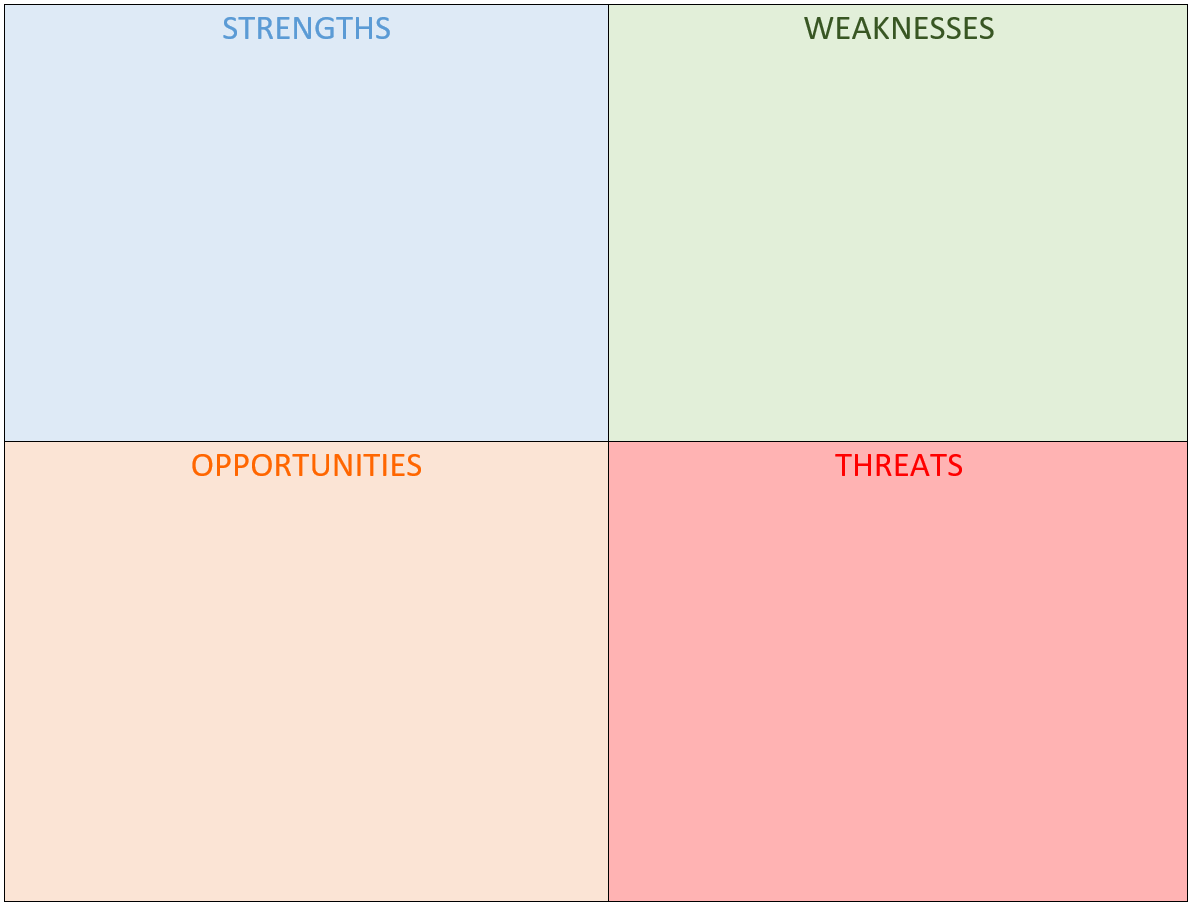
Your list of strengths should focus on your current resources and abilities. It should relate to things that you do or that your company does well. These might be your or your company's accomplishments—both great and small—and the assets that you or your company have. Your strengths give you your greatest edge; they are the resources that propel you forward and that you can continue to develop as you progress.
When you draw up your first SWOT analysis, you may find yourself at a loss. Don't worry—it's difficult for most people to come up with an objective list of strengths and weaknesses on the spot. For your convenience, we've included a list of questions you can ask yourself to get started.
These questions should help you identify a few of your strengths. Remember, while our example questions mostly relate to business strengths, they can also apply to personal strengths. Go ahead and boast as much as you can.
- What sets your company apart from others?
- What do you have that other companies don't?
- What are you most proud of about your company?
- What makes clients come back to you?
- What does your company do well?
- What assets do you have access to?
- What qualities does your company have that other companies try to emulate?
- What has always been easy for your company?
Listing your weaknesses might be a little more uncomfortable than detailing your strengths, but trust us—doing so will help you in the long run. Understanding the obstacles in your path and the elements of your business or skills you may need to improve is just as important as appreciating your strengths. Once you're aware of your weaknesses, you can start working on them and building your next steps around them.
Your list of weaknesses should pertain to any current problems and challenges. Check out the list of questions below—it should give you an idea of where to start. Again, if you'd rather focus on your personal or career growth, feel free to alter these questions to suit your needs.
- What makes your company blend in with its competition?
- What do other companies have that you don't?
- What are the most common criticisms that you receive from clients?
- Why have certain clients not returned to you?
- What does your company need to improve upon?
- What kind of feedback do you receive from your employees?
- What might your competition consider to be a weakness?
- What has always been difficult for your company?
- What are you unwilling to do or change?
Opportunities
Think about the opportunities available to you as potential future strengths. Your opportunities are the assets, resources, and events that could be beneficial to you in some way in the future. You may need to change some of your current approaches or adapt in other ways to capitalize on these opportunities, and that is not necessarily a bad thing.
Here are some questions you can ask yourself to identify your potential opportunities:
- What is happening in the current market that you could capitalize upon?
- What changes have you been making that have returned positive results?
- What is working for other companies?
- How could you introduce new technology to make your processes more efficient?
- What costs can you cut?
- Could you access new sectors or demographic groups?
- How can you improve or modernize your marketing techniques?
- How can you remove existing obstacles?
Threats
Just as your opportunities are based on potential, so are your threats; these are the possible obstacles or issues that are not yet directly affecting your progress. But this doesn't mean that you shouldn't start thinking about them! Being aware of the challenges that you may encounter will help you either plan around them or confront them with solutions. Try to come up with several future events that may realistically hinder the momentum you build from engaging with your strengths and opportunities.
To get started, take a peek at our list of questions:
- What obstacles might your weaknesses create?
- Do changing market trends negatively affect your competitive edge?
- What might stand in the way of the changes you make to accommodate your strengths and opportunities?
- Do you have a lot of debt?
- Could your competition exploit your weaknesses?
How did you do? Do you feel like you've listed everything? Or do you think you're missing something? Below, we've drafted examples of a business and a personal SWOT analysis to provide you with some perspective on what a completed one might look like.
An Example of a Personal SWOT Analysis
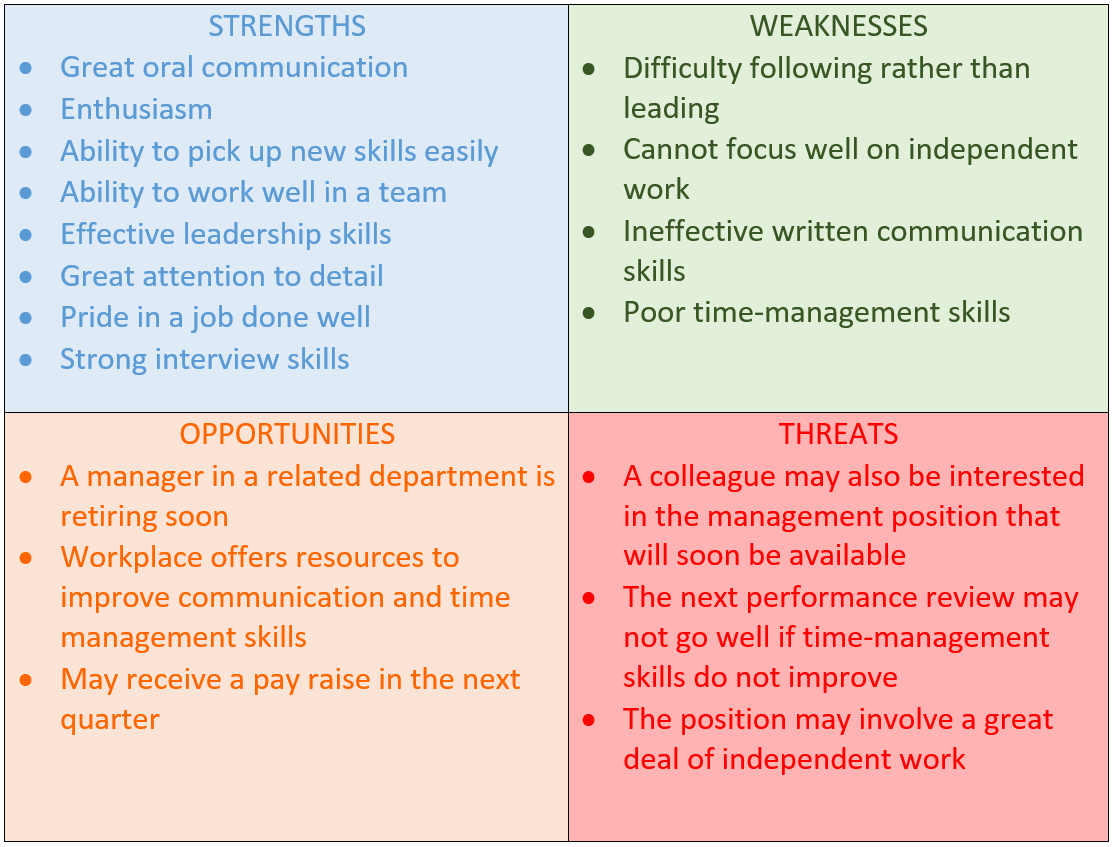
An Example of a Business SWOT Analysis
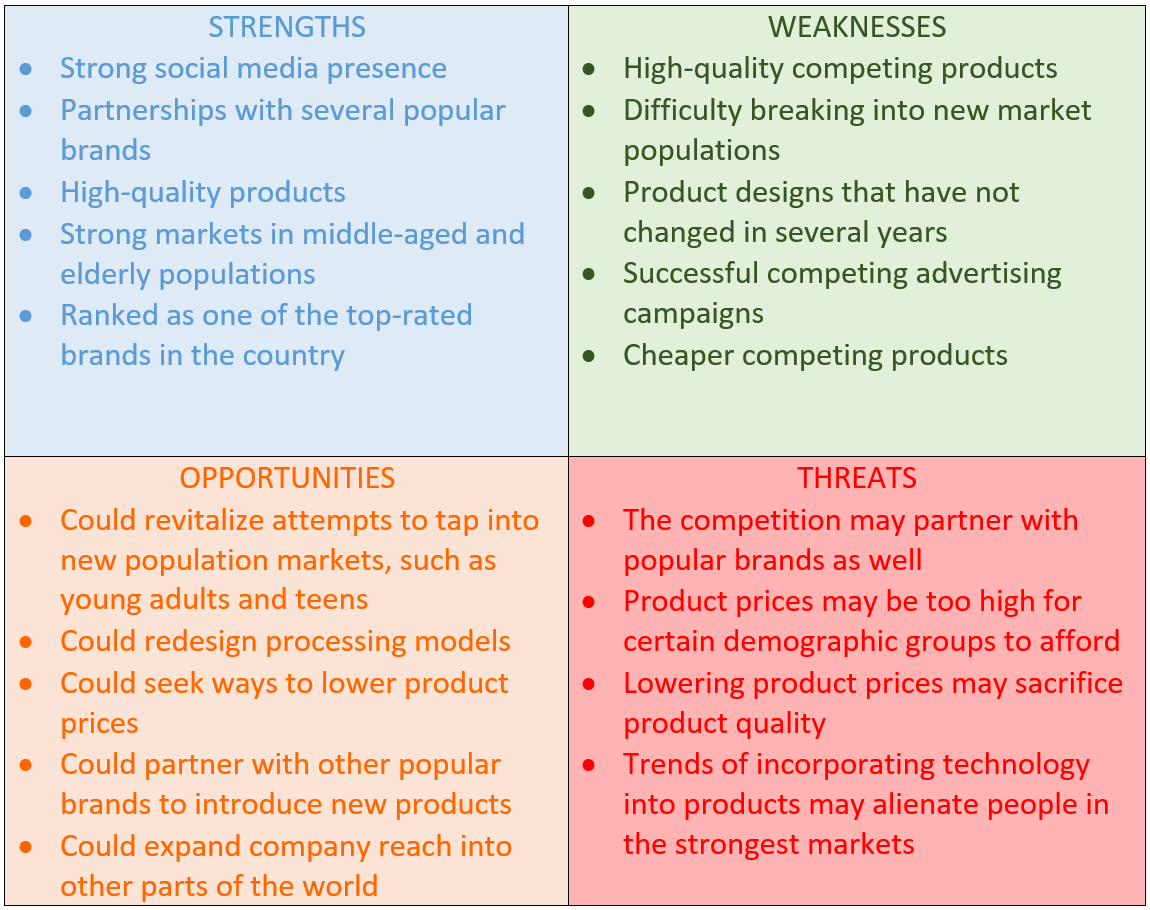
Final Words
The humble but effective SWOT analysis will produce a detailed map of your current environment—its hills and valleys alike. Knowing how to write a SWOT analysis will provide you with the vantage point you need to choose a direction and blaze a trail toward your goals. SWOT analyses may not be crystal balls, but they are something like compasses. Use them wisely, and you will never be lost.
Image source: cookelma/unspla sh.com
Make a Strong Start. Connect with a Professional Editor.
Hire one of our expert editors , or get a free sample, about the author.

Scribendi's in-house editors work with writers from all over the globe to perfect their writing. They know that no piece of writing is complete without a professional edit, and they love to see a good piece of writing turn into a great one after the editing process. Scribendi's in-house editors are unrivaled in both experience and education, having collectively edited millions of words and obtained nearly 20 degrees collectively. They love consuming caffeinated beverages, reading books of various genres, and relaxing in quiet, dimly lit spaces.
Have You Read?
"The Complete Beginner's Guide to Academic Writing"
Related Posts

How to Write a Business Plan

How to Write a Letter of Recommendation

Traditional Publishing versus Self-Publishing: What's the Difference?
Upload your file(s) so we can calculate your word count, or enter your word count manually.
We will also recommend a service based on the file(s) you upload.
English is not my first language. I need English editing and proofreading so that I sound like a native speaker.
I need to have my journal article, dissertation, or term paper edited and proofread, or I need help with an admissions essay or proposal.
I have a novel, manuscript, play, or ebook. I need editing, copy editing, proofreading, a critique of my work, or a query package.
I need editing and proofreading for my white papers, reports, manuals, press releases, marketing materials, and other business documents.
I need to have my essay, project, assignment, or term paper edited and proofread.
I want to sound professional and to get hired. I have a resume, letter, email, or personal document that I need to have edited and proofread.
Prices include your personal % discount.
Prices include % sales tax ( ).

- Sample Plans
- WHY UPMETRICS?
Upmetrics AI Assistant: Simplifying Business Planning through AI-Powered Insights. Learn How
- 400+ Sample Business Plans
Customers Success Stories
Business Plan Course
Strategic Canvas Templates
E-books, Guides & More
Business consultants
Entrepreneurs and Small Business
Accelerators and Incubators
Educators & Business Schools
Students & Scholars
AI Business Plan Generator
Financial Forecasting
AI Assistance
Ai pitch deck generator
Stratrgic Planning
See How Upmetrics Works →
Small Business Tools
Entrepreneurs & Small Business
Accelerators & Incubators
Business Consultants & Advisors
Strategic Planning
What is SWOT Analysis & How to Conduct it

Free Competitive Analysis Kit
Ayush Jalan
- January 1, 2024
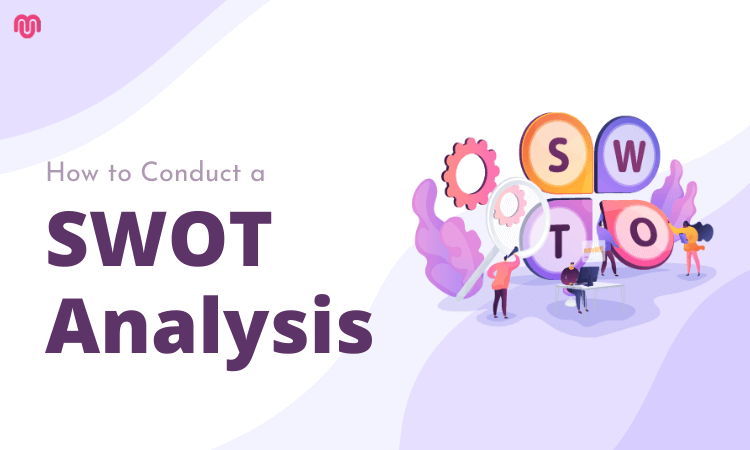
Running a business is rarely ever simple. There’s a constant need to analyze and refine strategies, goals, finances, customer base, and all the other factors that affect your profitability. Businesses use multiple tools to make this process easy. One such tool is the SWOT analysis framework.
SWOT analysis is a strategic planning tool that helps build an effective marketing plan. It is a part of the strategic marketing process , which helps analyze your present market position and further helps build a strong business plan.
It uses the data from the analysis of the market , customer, and competitors to develop a framework to represent your SWOT parameters: Strengths, Weaknesses, Opportunities, and Threats . It also helps when you need a fresh look at your strategies.
Table of Contents
What is swot analysis, how to conduct a swot analysis, how to use a swot analysis.
- Plan, Protect, & Prepare with SWOT Analysis
In this article, you will learn what is a SWOT analysis, how it is used in writing an effective business plan , and how to conduct it for your business.
SWOT analysis (Strengths, Weaknesses, Opportunities, Threats) is a tactic businesses use to evaluate their market position. As the abbreviation suggests, it is a framework that helps identify your strengths and weaknesses as well as the opportunities and threats apparent in your industry.
Conducting a SWOT analysis helps you stay informed about the changing dynamics of your market position. The four aspects of this framework assess both internal and external factors that impact your growth.
The internal factors are strengths and weaknesses, while external factors are opportunities and threats. Conducting a SWOT analysis helps you identify and modify the internal factors and stay aware and attentive to external factors.
SWOT analysis is an essential part of your business plan as it helps predict risks and explore new possibilities. It usually precedes the marketing plan section of your business plan.
You can use it to assess your company’s competitive position, and operational level efficiency, compute the chances of success before accepting new projects, and more.

Want to create a SWOT Analysis for your Business?
Craft a powerful SWOT Analysis in just minutes using our user-friendly and free online SWOT Analysis Generator Tool!
A SWOT analysis, also known as a SWOT matrix, helps you get a new perspective to adjust strategies and serves as a determiner to decide whether or not a project is worth taking up. Make sure to bring together the representatives and/or managers of all the departments.
The more minds involved, the richer and more accurate the analysis can be.
Next, begin brainstorming ideas. This helps incur multiple viewpoints which provide room for further discussion and conversation. Expect some disagreements and conflicts of interest at this stage.
Next, put these ideas together and average them out. That way, you can cut out the intensely opposing views. With the information obtained, start building your SWOT matrix. Make sure to gather enough data to support your claims.
Let’s take a closer look at the four parameters of SWOT analysis.
1. Strengths
Strengths are what you excel at and what sets you apart from your competitors. These can include reliable branding, a loyal customer base, unique technology, a higher conversion rate, monopoly business, strong supply chains, etc. These should be presented in the matrix with a short description to secure investors.
In case you are still confused, answering the below questions can help you determine your strengths.
- What are you best known for?
- How effectively do you use resources?
- How fast do you deliver products?
- Which of your products was the most successful?
- What are the resources that are exclusive only to you?
- Are your investors happy?
- What are your unique selling proportions?
- Do you have a loyal customer base?
- Is your revenue predictable?
2. Weaknesses
After writing down your strengths, the next parameter is your weaknesses. Honesty is paramount to building an effective SWOT matrix. Weaknesses are the areas you need to improve in and the aspects that are staggering your growth .
These can include high debts, low revenue, obsolete machinery, lack of working capital , unskilled staff, etc. Here are some questions you can answer to list down your weaknesses accurately.
- What do your customers often complain about?
- What are the financial resources you lack?
- What is the human resource you lack?
- Do you have enough technical expertise?
- Are your products not innovative enough?
- Are your expenses too high?
3. Opportunities
Opportunities are advantageous openings in the external business environment that you can exploit to attain higher goals. Identifying opportunities as quickly as possible helps you have a competitive edge over others in your industry.
These don’t necessarily have to be groundbreaking discoveries; they can be small advantages that can impact your growth and sales. To identify opportunities, you can start by asking the following questions.
- What are the current market trends that can increase your sales?
- Which new government policies and regulations can benefit you?
- Which upcoming events or festivals can you capitalize on?
- Which recent technological changes can prove to be beneficial?
- What are the social and lifestyle changes that you can capitalize on?
Threats are those events, limitations, or variables that can affect you negatively. These can harm you in the future if you don’t identify them sooner and stay prepared to tackle them. An obvious threat is your immediate competitor(s).
Conduct an extensive competition analysis to understand your competitors ‘ actions and analyze whether or not they’re going to be a problem for you in the coming days.
You should also be aware of the threats that advancements in technology, increases in material costs, and changes in the market can bring. Identifying threats can be tricky; asking the below questions can help you get started.
- What are the obstacles you are facing in the market?
- What are your competitors doing better than you?
- Does your industry have an easy entry for new competitors?
- Will raw materials costs and labor charges rise in the near future?
- Will advancements in technology impact you negatively?
- What are the market trends that can become threats?
- What are the social and lifestyle changes that can harm you?
Simply having the information is not enough. You need to be able to gain actionable insight from it. Let’s take a closer look at how to use a SWOT analysis.
You have successfully created a SWOT matrix filled with valuable information, great work! Now it’s time to act upon this newfound information. Before starting to take action and set up strategies, start looking for connections between the four aspects.
Create an action list that addresses all four elements of the SWOT analysis. Enlist new strategies to complete these actions, set milestones , choose relevant metrics to measure your progress, and closely monitor your actual performance compared to the planned performance.
It is beneficial to prioritize and schedule these changes according to your unique requirements. If you’re conducting a SWOT analysis to determine whether or not a project is worth taking up, these are some questions you will be able to answer at the end of the analysis:
- Do you have the time and resources to accept this project?
- If not, would adjusting current obligations allow room to accept it?
- Is this project worth enough to consider prioritizing over others?
If done well, a SWOT analysis should be able to answer all your questions clearly and in specific and quantifiable terms. Make sure to try and keep your findings measurable. That way, you can get a clear picture of what you’re getting into. You can use the data obtained to create new strategies and set SMART goals .
Plan, Protect, and Prepare with a SWOT Analysis
It can be confusing to set goals and plans without having complete knowledge of your capabilities and limitations. SWOT analysis helps you do this with ease. It equips you with the data to make more informed business decisions to avoid taking unnecessary risks, protect yourself from threats, benefit from your strengths, and capitalize on opportunities.
It equips you with the data to create a solid marketing process and an effective marketing plan. Business factors such as market trends, customer needs, lifestyle changes, and more change often over time. To stay relevant, it’s wise to revise your SWOT matrix regularly.
Build your Business Plan Faster
with step-by-step Guidance & AI Assistance.

About the Author

Ayush is a writer with an academic background in business and marketing. Being a tech-enthusiast, he likes to keep a sharp eye on the latest tech gadgets and innovations. When he's not working, you can find him writing poetry, gaming, playing the ukulele, catching up with friends, and indulging in creative philosophies.
Related Articles
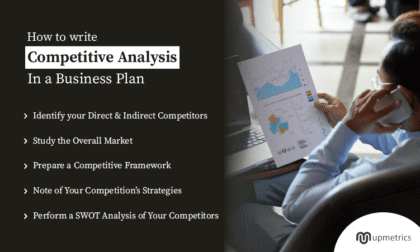
How to Write Competitive Analysis in a Business Plan (w/ Examples)

How to Write SMART Goals: Explained with Examples
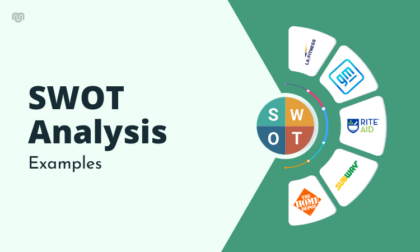
5 Top Brands’ SWOT Analysis Examples
Reach your goals with accurate planning.
No Risk – Cancel at Any Time – 15 Day Money Back Guarantee
Popular Templates

Table of Contents
What is swot analysis, swot analysis process, how to do a swot analysis for your business, swot analysis for business analysts, the ultimate guide to swot analysis for business and why it matters.

To run a business successfully and efficiently, business analysts need to regularly analyze a number of things and processes. There are a number of ways a business analyst assess a business, but one of the most effective methods out there is to conduct a SWOT analysis for business.
A SWOT analysis is a planning technique used to determine a business’ strengths, weaknesses, opportunities and threats. The primary objective of performing a SWOT analysis for business is to help organizations overcome challenges and decide what new leads to pursue.
SWOT analysis was created by Albert Humphrey of the Stanford Research Institute during the 1960s to identify why corporate plans fail. Ever since its inception, it has become one of the most useful tools used in the growth of any business.
SWOT analysis involves four main areas - Strengths, Weaknesses, Opportunities, and Threats. It includes both internal and external components, which are equally important for the success of a business. Here is a brief summary of the SWOT analysis process:
In a SWOT analysis, strength refers to the attributes within an organization that are necessary for the success of a project and ultimately, the success of a business. It can comprise all resources and capabilities that can be used at a competitive advantage. Some example of strengths of a business include:
- Good company reputation
- Strong social media presence
- Skilled and knowledgeable staff
- Qualities that make you stand out from your competitors
Any factor that could prevent successful results within a project are called weaknesses. You need to enhance these weaknesses in order to beat your competitors. Some examples of weaknesses of a business include:
- Lack of appropriate funding
- Rivalry between departments
- Weak internal communication system
- Unclear unique selling proposition
Opportunities
Opportunities of a business are those external elements that could be potentially helpful in achieving the goals of a project. They might come in the form of developments in the market you are in, the technologies you use, etc. You need to be able to spot and seize these opportunities for the long-lasting success of a business. Some examples of opportunities of business include:
- Media coverage for your company
- Emerging need for your products or services
- Few competitors in your market
- Overflowing leads
Threats can be anything that poses a potential risk for the success and growth of a business. It is important to anticipate threats and take action against them before they become a more serious problem. Some examples of threats of a business include:
- Negative public image
- Cheaper and better products and services
- Changes in laws and regulations
- Lack of vendors to supply raw materials
Become a Business and Leadership Professional
- Top 10 skills in demand Business Analysis as a skill in 2020
- 14% Growth in Jobs of Business Analysis profile by 2028
- $85K Average Salary
Post Graduate Program in Business Analysis
- Certificate from Simplilearn in collaboration with Purdue University
- Become eligible to be part of the Purdue University Alumni Association
Business Analyst
- Industry-recognized certifications from IBM and Simplilearn
- Masterclasses from IBM experts
Here's what learners are saying regarding our programs:
I was keenly looking for a change in my domain from business consultancy to IT(Business Analytics). This Post Graduate Program in Business Analysis course helped me achieve the same. I am proficient in business analysis now and am looking for job profiles that suit my skill set.
Assistant Consultant at Tata Consultancy Services , Tata Consultancy Services
My experience with Simplilearn has been great till now. They have good materials to start with, and a wide range of courses. I have signed up for two courses with Simplilearn over the past 6 months, Data Scientist and Agile and Scrum. My experience with both is good. One unique feature I liked about Simplilearn is that they give pre-requisites that you should complete, before a live class, so that you go there fully prepared. Secondly, there support staff is superb. I believe there are two teams, to cater to the Indian and US time zones. Simplilearn gives you the most methodical and easy way to up-skill yourself. Also, when you compare the data analytics courses across the market that offer web-based tutorials, Simplilearn, scores over the rest in my opinion. Great job, Simplilearn!
SWOT analysis for business is best conducted among a group of people with different perspectives and stakes in a business. Upper management customer service, sales, marketing, and even customers can provide valuable insights.
SWOT analysis matrix
Traditionally, a SWOT analysis is conducted by using a four-square SWOT analysis template where there is a box for each of the four components - strengths, weakness, opportunities, and threats. This makes it easier to have a glance at all the components in one go. However, you can just make a simple list as well for each component. The best method is the one which will make it easier for you to organize and understand the results.
These are the various steps that you can take to perform a SWOT analysis for business:
Step 1: Identify Your Strengths
Strengths are internal to your company and within your call. The first step is all about identifying all of your best assets. Here are some questions to get you started.
- Why do your customers stay?
- Why does your business do well?
- What is your unique selling point (USP) that sets you apart from competitors?
Step 2: Evaluate Your Weaknesses
Weaknesses are also internal factors that can break your business or leave you at a competitive disadvantage. The questions you can ask to identify some of your main weaknesses are:
- In which areas does your business struggle?
- Why do customers select your competitors over your business?
- What stops you from performing your best?
Step 3: Look Out for New Opportunities
In order to find new opportunities for your business, you need to do a lot of research. For this section of the SWOT analysis, you can think outside of the box for any possible thing that would be good for the business. One of the most important things you need to do is market research to gauge new and upcoming changes.
Step 4: Identify Threats
The most difficult part of SWOT analysis for business is to come up with a list of potential threats because you never know what can hit you. It may also cause some anxiety to think about threats, but it’s better to identify them before they turn into bigger problems in the future. List out all the threats, no matter how minor you think it might be. Even though it may not have severe consequences to watch out for, it is always better to have it on your radar so that you are ready whenever it becomes a major problem.
Step 5: Develop Actionable Strategies
Once you’ve come up with a list of each of your strengths, weaknesses, opportunities and threats, you can start developing actionable strategies from them using a technique called TOWS analysis.
TOWS analysis example
TOWS analysis is an extension of SWOT analysis and involves matching up your strengths, opportunities, threats, and weaknesses to develop actionable strategies.
Gain expertise in the latest Business analytics tools and techniques with the Business Analyst Master's Program . Enroll now!
A business analyst needs to know the working knowledge of SWOT analysis and its applications. A business analyst can utilize SWOT analysis in a number of ways:
- To ascertain the viability of a proposed solution
- To identify new opportunities in a domain or sector
- To find better alternatives for an existing solution
- To analyze a system undergoing change
- To study and research about business competition
If you want to learn more about SWOT analysis and other tools for business analysts, Simplilearn’s Business Analysis Certification Program will enhance your expertise in all the latest business analyst tools and techniques. This Post Graduate program will provide you with real-world examples and case studies to make you market-ready for any industry.
Our Business And Leadership Courses Duration And Fees
Business And Leadership Courses typically range from a few weeks to several months, with fees varying based on program and institution.
Learn from Industry Experts with free Masterclasses
Data science & business analytics.
Program Overview: How Purdue University Can Help You Succeed in Business Analysis
Business and Leadership
Program Overview: The Reasons to Get Certified in Business Analysis in 2023
Program Preview: Post Graduate Program in Business Analysis
Recommended Reads
Free eBook: Guide To The CCBA And CBAP Certifications
The Ultimate Guide to Business Impact Analysis
A Holistic Look at Tesla SWOT Analysis
Digital Marketing Salary Guide 2021
What Is Data Analysis: A Comprehensive Guide
A Complete Guide to Get a Grasp of Time Series Analysis
Get Affiliated Certifications with Live Class programs
- PMP, PMI, PMBOK, CAPM, PgMP, PfMP, ACP, PBA, RMP, SP, and OPM3 are registered marks of the Project Management Institute, Inc.

Where Do You Put SWOT Analysis In A Business Plan?
The point of a SWOT analysis is to help you develop a strong business strategy by making sure you’ve considered all of your business’s strengths and weaknesses , as well as the opportunities and threats it faces in the marketplace.
How is SWOT analysis done in a business plan?
SWOT is an acronym for strengths, weaknesses, opportunities and threats. The SWOT analysis helps you see how you stand out in the marketplace, how you can grow as a business and where you are vulnerable . This easy-to-use tool also helps you identify your company’s opportunities and any threats it faces.
What should you do before you begin a SWOT analysis?
Before you begin the SWOT analysis you need to do some research to understand your business, industry and market . Get a range of perspectives by talking to your staff, business partners and clients. Also conduct some market research and find out about your competitors.
Why is SWOT analysis Important explain in 3 5 sentences?
SWOT Analysis is important because it’s a simple but useful framework for analyzing your organization’s strengths, weaknesses, opportunities, and threats (SWOT) . Present data related to a SWOT analysis helps identify the strengths, weaknesses, opportunities, and threats in the industry.
What are the strengths of a business?
Some examples of strengths include:
- Strong employee attitudes.
- Excellent customer service.
- Large market share.
- Personal relationships with customers.
- Leadership in product innovation.
- Highly efficient, low-cost manufacturing.
- High integrity.
What are the strengths and weaknesses in business?
Strengths and weaknesses are internal to your company—things that you have some control over and can change . Examples include who is on your team, your patents and intellectual property, and your location. Opportunities and threats are external—things that are going on outside your company, in the larger market.
What are the new business opportunities?
Online Business Opportunities
- Web Design.
- App Development.
- Amazon Selling.
- Etsy Selling.
- Course Creation.
- Virtual Assisting.
- Influencer Marketing on Social Media.
What are the most successful small businesses 2020?
What are the most profitable small businesses?
- Handymen or handywomen. The number of people who know how to repair things around the house is dwindling. …
- Online education. …
- Tutoring. …
- Real estate agency. …
- Child-oriented businesses. …
- Dental offices. …
- Gardening and landscaping. …
- Information technology (IT) support.
What are examples of business opportunities?
- E-learning.
- Dropshipping.
- Online gaming.
- Consulting.
- Print-on-demand services.
- Freelance business.
- Ecommerce store owner.
- Consultant.
What businesses will always be in demand?
- Food. Food is required for life and this means demand will always be high. …
- Pharmaceutical. The pharmaceutical industry has experienced impressive growth globally. …
- Healthcare. …
- Education. …
- Sin Industry. …
- 6. Entertainment & Media. …
- Professional Services.
What is a market weakness?
A weakness is a limitation or fault in your company or marketing plan that prevents it from achieving its goals . These weaknesses are internal considerations or vulnerabilities that can lead to diminished revenue or the outright failure of your enterprise.
What are examples of opportunities?
Opportunities refer to favorable external factors that could give an organization a competitive advantage . For example, if a country cuts tariffs, a car manufacturer can export its cars into a new market, increasing sales and market share.
How do you turn your strength into an opportunity?
Here’s how:
- Strengths–Opportunities. Use your internal strengths to take advantage of opportunities.
- Strengths-Threats. Use your strengths to minimize threats.
- Weaknesses-Opportunities. Improve weaknesses by taking advantage of opportunities.
- Weaknesses-Threats. Work to eliminate weaknesses to avoid threats.
What are the strengths of a small business?
7 Glorious Advantages of Being a Small Business
- Flexibility. When you are a small business, are way more flexible and able to make the changes necessary to survive than a big outfit. …
- Expertise. …
- Uniqueness of Small Businesses. …
- Satisfaction. …
- Personal Service. …
- Focus. …
- Small Business Owner: A Great Boss.
What strengths are most valuable to the business?
4 Key Strengths of Successful Businesses
- Reliability. Reliability is doing what you said you’d do when you said you were going to do it. …
- Competence. …
- Openness. …
- Compassion.
What are my strengths?
Some examples of strengths you might mention include:
- Enthusiasm.
- Trustworthiness.
- Creativity.
- Discipline.
- Respectfulness.
- Determination.
- Dedication.
What is the most important part of the SWOT analysis?
Begin with the strengths and weaknesses and then process the results . Move on to the opportunities and threats and do the same. It’s critical to remain optimistic when you’re discussing the results of a SWOT analysis. Weaknesses and threats can cause a planning team to feel defeated.
How important is SWOT analysis for a good leader?
The SWOT analysis is one of the most-used tools by leaders, and with good reason. When used correctly, identifying your strengths, weaknesses, opportunities and threats provides a foundation for effective strategic planning.
How do you create a SWOT analysis explain your answer in 3 5 sentences?
How to Do a SWOT Analysis
- Determine the objective. Decide on a key project or strategy to analyze and place it at the top of the page.
- Create a grid. Draw a large square and then divide it into four smaller squares.
- Label each box. …
- Add strengths and weaknesses. …
- Draw conclusions.
What are the example of weaknesses?
Here are a few examples of the best weaknesses to mention in an interview:
- I focus too much on the details. …
- I have a hard time letting go of a project. …
- I have trouble saying “no.” …
- I get impatient when projects run beyond the deadline. …
- I sometimes lack confidence. …
- I can have trouble asking for help.
What are some weaknesses in business?
The 7 Business Weaknesses That May Be Your Biggest Advantages
- No one knows you. …
- You lack the resources to grow. …
- You’re new to the industry. …
- High-priced, expert employees are out of your budget. …
- What you’re offering to customers isn’t exactly clear. …
- A specialized product means a high-price point.
What is a major weakness of product?
A potential weakness of product positioning is that every company wants to position its products favorably in the minds of consumers , so there is usually a high level of competition. New companies, for example, often find it difficult to position their products in a market that has well-established competitors.
What is the easiest business to start?
15 Easy Businesses to Start
- Event Planning. …
- Gardening and Landscaping Services. …
- DJing. …
- Painting. …
- Yoga Instruction. …
- Local Tour Guide. Image (c) Zero Creatives / Getty Images. …
- Tutoring. Tutor helping one of her students. …
- You Don’t Need Much Money But You Do Need… Couple running small gardening business .
Related Q&A:
© 2022 - 2024 Times Mojo - All Rights Reserved Home | About | Contact | Copyright | Report Content | Privacy | Cookie Policy | Terms & Conditions | Sitemap

IMAGES
COMMENTS
A SWOT analysis is a framework used in a business's strategic planning to evaluate its competitive positioning in the marketplace. ... Brainstorm and capture SWOT data. The second step is to go ...
A SWOT analysis is a strategic planning tool used to identify and understand the Strengths, Weaknesses, Opportunities, and Threats related to business competition or project planning. This method helps organizations in assessing both internal and external factors that could impact their objectives.
SWOT Analysis: How To Do One [With Template & Examples] As your business grows, you need a roadmap to help navigate the obstacles, challenges, opportunities, and projects that come your way. Enter: the SWOT analysis. This framework can help you develop a plan to determine your priorities, maximize opportunities, and minimize roadblocks as you ...
A SWOT analysis is a technique used to identify strengths, weaknesses, opportunities, and threats in order to develop a strategic plan or roadmap for your business. While it may sound difficult, it's actually quite simple. Whether you're looking for external opportunities or internal strengths, we'll walk you through how to perform your ...
SWOT Analysis in Business Planning / Plans. Business plans often try to answer questions like "How will we grow?", "What will we change?", or "What might prevent us?". The two external factors in a SWOT matrix (Opportunities and Threats) begin the process of answering these questions, thanks to their inherent relation to the future.
SWOT stands for Strengths, Weaknesses, Opportunities, and Threats, and so a SWOT analysis is a technique for assessing these four aspects of your business. SWOT Analysis is a tool that can help you to analyze what your company does best now, and to devise a successful strategy for the future. SWOT can also uncover areas of the business that are ...
SWOT analysis is a process that identifies an organization's strengths, weaknesses, opportunities and threats. Specifically, SWOT is a basic, analytical framework that assesses what an entity ...
Step 6: Draw the SWOT Analysis Table. The final step is crafting a swot analysis table. This involves creating a matrix and dividing it into four sections. The internal factors (strengths and weaknesses) are listed above, with the strengths on the left and the weaknesses on the right. On the other hand, the external factors (opportunities and ...
For startups, a SWOT analysis is part of the business planning process. It'll help codify a strategy so that you start off on the right foot and know the direction that you plan to go. How to do a SWOT analysis the right way. As I mentioned above, you want to gather a team of people together to work on a SWOT analysis.
A SWOT analysis can help a small business owner or business assess a company's position to determine the most optimal strategy going forward. This business practice can help you identify what you're doing well, what you want to do better, and what kinds of obstacles you might encounter along the way. This guide will walk.
A SWOT analysis is typically conducted using a four-square SWOT analysis template, but you could also just make lists for each category. Use the method that makes it easiest for you to organize and understand the results. I recommend holding a brainstorming session to identify the factors in each of the four categories.
Published on Dec. 13, 2022. Image: Shutterstock / Built In. A SWOT (strengths, weaknesses, opportunities, threats) analysis is a visual framework used for strategic planning across all types of businesses and organizations. SWOT analyses are made up of four components that will help you determine the output of your team's analysis.
A SWOT analysis is essential for developing a business plan that maximizes a company's strengths, minimizes its weaknesses, and takes advantage of opportunities while mitigating threats. Here are some of the reasons why a SWOT analysis is important for businesses: Identifies key areas for improvement. By conducting the SWOT analysis, businesses ...
Step 3: Assess Your Internal Weaknesses. This can feel like a vulnerable, critical part of completing your SWOT analysis because it requires a level of self-criticism and honesty that can be daunting - but remember, it can be a rewarding exercise if done with objectivity and clarity.
A SWOT analysis is a strategy used by businesses for measuring and evaluating their overall performance, and that of competitors, in an objective manner. All these factors help business owners make smarter decisions for their company, such as if a venture should grow into a new field or rebrand itself. The first two parameters, strengths and ...
Step #3. Divide your weaknesses into two groups: Group 1: Weaknesses that require improvement before you can take advantage of opportunities. Group 2: Weaknesses that you need to completely and quickly overhaul and convert into strengths to avert potential threats to your business. Step #4.
Review your weaknesses. Make a step-by-step action plan to evaluate their importance and mitigate the risk they post for the business. Evaluate the opportunities. Structure a plan that shows how you might take advantage of them, and what might hinder your progress. Weigh up the threats.
A SWOT analysis is a popular business analysis method that business leaders use to produce a current, high-level understanding of their business. SWOTstands for Strengths, Weakness, Opportunities, and Threats. Arranged in a 2×2 matrix, a SWOT analysis is easy to create and easy to understand, making it a useful starting point in the strategic ...
Essentially, a SWOT analysis is a comparative list of all your strengths, weaknesses, opportunities, and threats. There's more power in this process than you might think. You may be only hazily aware of your own strengths and weaknesses. However, thoughtfully recording and reflecting on them creates a thorough, conscious familiarity with both ...
A SWOT analysis takes a global view of your company but also evaluates smaller-scale elements of the business. It points out where you are strong, or not so strong, and can help you explore the opportunities and threats existing in your market. It's this type of knowledge that makes your strategic planning that much more robust.
The internal factors are strengths and weaknesses, while external factors are opportunities and threats. Conducting a SWOT analysis helps you identify and modify the internal factors and stay aware and attentive to external factors. External factors are uncontrollable and unpredictable. For the best outcome, plan out offensive and defensive ...
The primary objective of performing a SWOT analysis for business is to help organizations overcome challenges and decide what new leads to pursue. SWOT analysis was created by Albert Humphrey of the Stanford Research Institute during the 1960s to identify why corporate plans fail. Ever since its inception, it has become one of the most useful ...
SWOT is an acronym for strengths, weaknesses, opportunities and threats. The SWOT analysis helps you see how you stand out in the marketplace, how you can grow as a business and where you are vulnerable. This easy-to-use tool also helps you identify your company's opportunities and any threats it faces.